Some posts on this site contain affiliate links. If you book or buy something through these links, I earn a small commission (at no extra cost to you). Take a look at my privacy policy for more information.
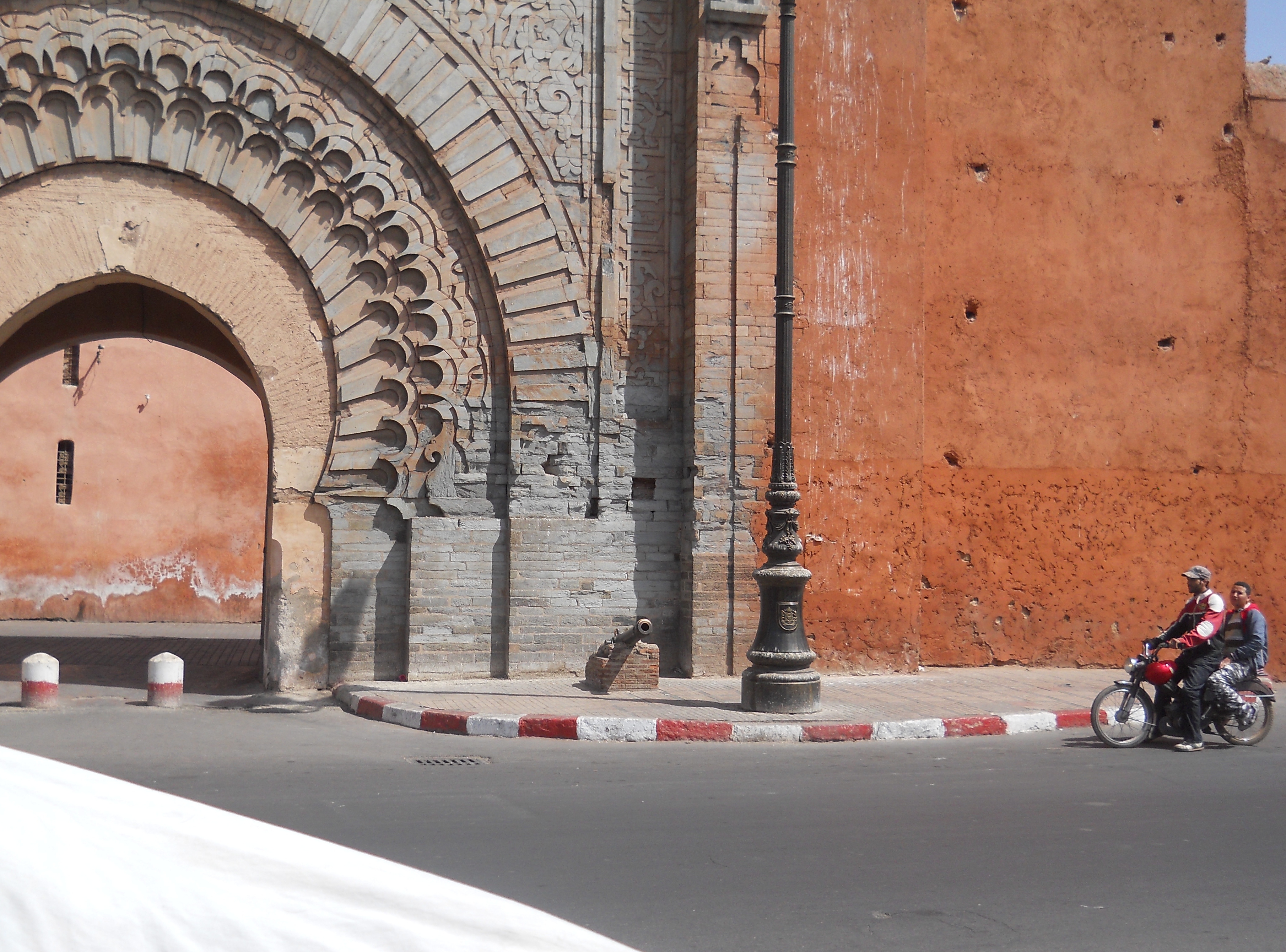
Morocco will always hold a special place in my heart. My first trip there, back in 2012, was the first time I ever set foot on the African continent. It was also my first trip abroad after starting this blog!
At the time, I’d barely travelled at all. Morocco – especially Marrakech – was a culture shock, a sensory overload, a true adventure.
I wrote about everything. And I mean everything! I came home from a ten-day trip with a notebook crammed with thoughts, stories, and observations. There’s something wonderfully naive about it all. looking back over a decade later, after years of travel and working as a full-time travel blogger – it’s funny to read my enthusiastic ramblings!
Sadly, though, these blog posts are far too old (and badly written) to be of much use to anyone these days. But these are my earliest blog posts, and they hold a lot of sentimental value for me. So, I’ve popped them all together on the same page, rather than delete them. This collection is really just for me – but if you’ve stumbled across the page, you’re welcome to read through the posts and see what that fresh-faced, innocent little, early-twenties-Emily thought of her first journey to Africa!
My writing (and travel) styles have changed a lot since that first trip, but one thing remains the same: my love of adventure, the thrill of the new, the excitement of strange flavours and smells. Hopefully, these old-school Morocco diaries capture some of that…
Arriving in Marrakech
19 March 2012
Pink, dusty, and loud. That’s how I’d summarise Marrakech, a city that bewitched and exasperated me in equal measure. It was beautiful, it was chaotic, it was frequently frustrating… it intoxicated me.
Our arrival in Marrakech was like a beautiful, surreal nightmare. We touched down just after sunset, and immediately got caught in a web of taxi drivers. I wasn’t prepared for negotiation and was caught off guard by the 300 dirham fee, which the driver said would be necessary because our Riad was in a difficult place to get to.
This turned out to mean that Riad Dar Nabila wasn’t actually on a road. It stood deep within a small network of alleys near the main bus station and just off the Rue El Gza. Our five nights at this Riad taught us that the taxi driver could have gotten us as near as the main road and pointed us down the alley.
Instead, he stopped on the side of a road “somewhere” in the city, called over a random boy and conversed with him in Moroccan, a language which sounded strange and impenetrable on that first bizarre night. Before we knew it, we were following this boy on foot down a series of side streets, dodging speeding mopeds and passing hole-in-the-wall shop fronts where huge cuts of meat hung from metal hooks. In patchy English, our ‘guide’ assured us he knew where the Riad was and that the journey was a five-minute walk. As we ventured deeper into a mesh of alleys which became gradually darker and less populated, it became clear that this was untrue.
Our guide did not know the way. Gradually, as he asked more kids for directions who inevitably joined the party, we built up an entourage. Eventually – and seemingly by luck rather than any knowledge amongst our party of guides – we arrived at the Riad. We parted with another 50 dirhams as a tip for the original guide; we refused to give him the 100 he demanded as he hadn’t known the way, but even 50 was far too much.
It seems to be a popular sport among young Moroccans to insist on offering uninvited directions to foreigners, often leading them to their destination (guessing most of the way) and to then demand money. My tip; tell them you have no money when they approach you. Often, they walk away then and there.
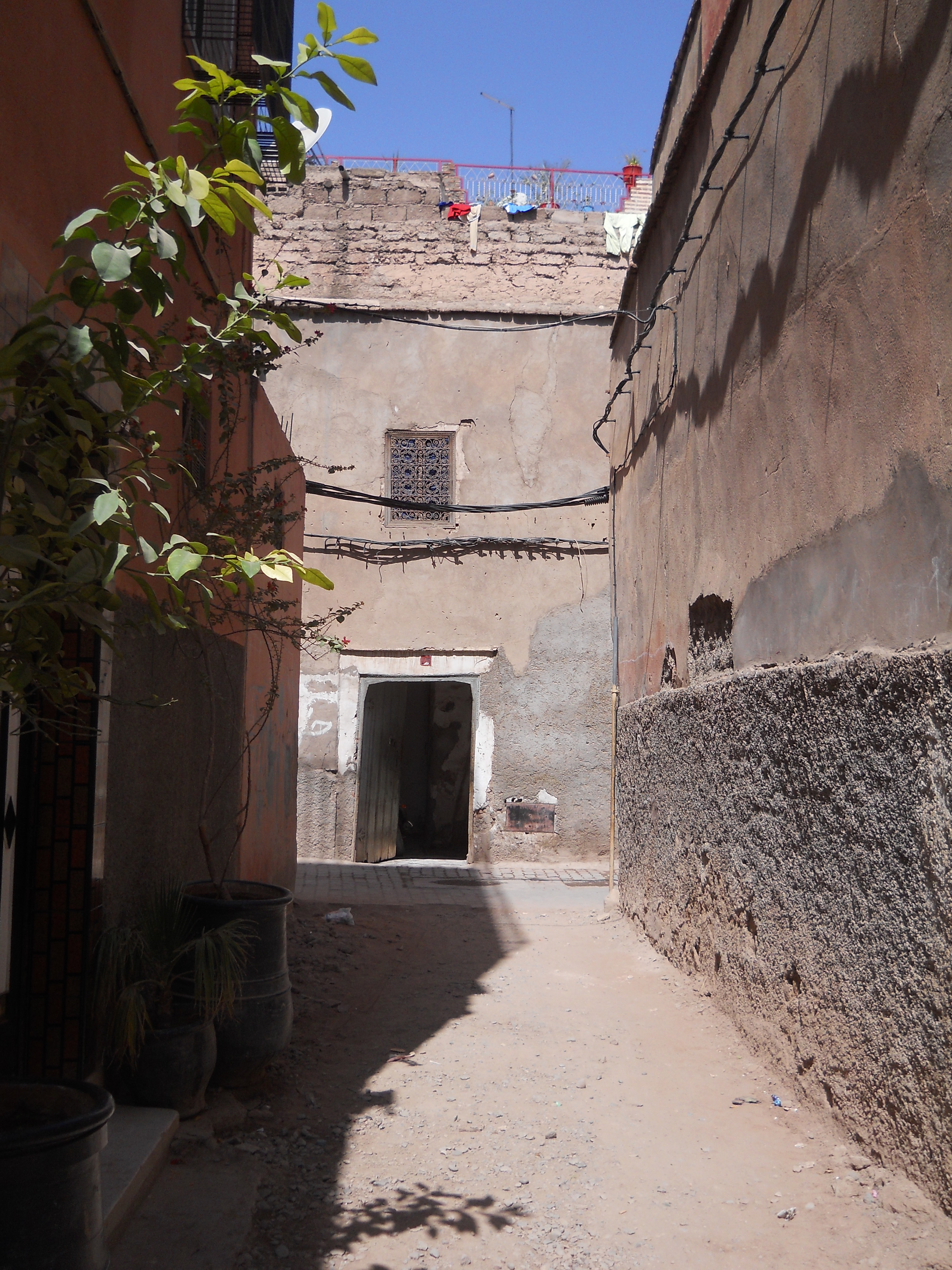
The unassuming street where Riad Dar Nabila can be found – a shabby, narrow alleyway like many in Marrakech.
Riad Dar Nabila was lovely. It stood down an unnamed alleyway, behind a large wooden door in a completely plain wall which opened onto an oasis of calm. As the door closed on our noisy group of guides, we found ourselves in a little envelope of silence. Khalila, the tiny and overpoweringly warm owner, made us feel immediately welcome. Riads are two-storey houses, built around a central courtyard overlooked by a balcony. These courtyards are a way for Marrakechis to bring a splash of nature into the heart of the city. We relaxed on the patio amongst orange trees and creeping trellises to enjoy our first taste of deliciously sweet mint tea, a Moroccan staple.
After a very informal check-in, Khalila brought us dinner. Three courses each for just 30 euros. It was an expensive meal in comparison to many places in Marrakech but still very reasonable, especially given how delicious the food was.
With our bellies full of tagine and our nerves still a little shot from the confusing arrival, we went to sleep with our first adventure in Morocco safely behind us.
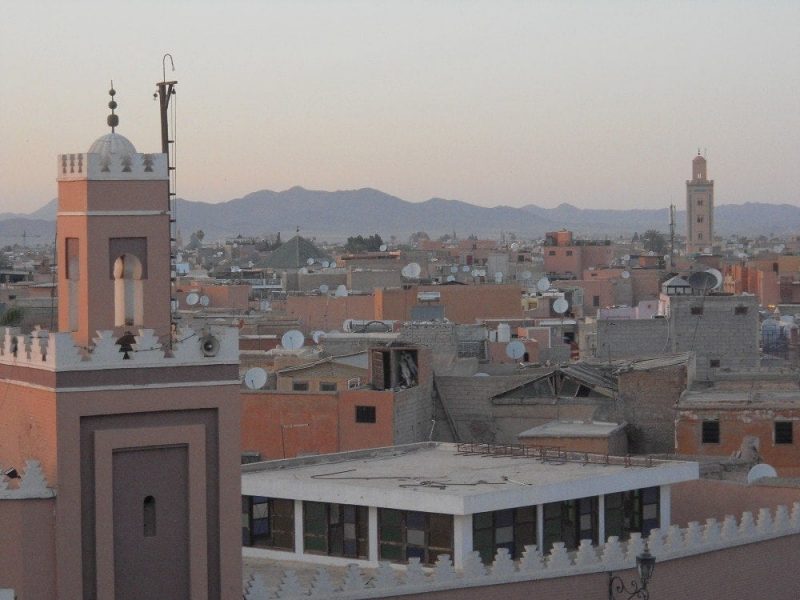
First Day in Marrakech
20 March 2012
Lately I’ve been missing Moroccan breakfasts, which are essentially my perfect meal. On the first morning, we sat at mosaic-tiled patio furniture in the peaceful courtyard of our Riad, and stuffed our faces with freshly squeezed orange juice, sweet mint tea, and a selection of breads and cakes. Moroccan bread, which is a large flat circle and resembles a thick, doughy pizza base, is served with every meal. It’s crusty, with a soft and sweet middle, like French bread, and great for dipping in olive oil as the locals do. We also had pancakes with honey, and a cake a little like brioche with chocolate and walnut. Lots of goodies for my sweet tooth, and delicious tangy juice, all served outdoors amongst leafy plants, fragrant orange trees, and tiny little chirruping birds. What a way to start the day; so much better than shovelling bran flakes at my desk at work!
Exploring the Souqs and Djemma El Fna
All those carbs for breakfast are perfect to keep you going in Marrakech. After breakfast, we plunged straight into the souqs, which are a five minute walk away from Riad Dar Nabila, at the bottom of the Rue El Gza. At the end of the road, as we contemplated the fork which wasn’t present on the guidebook map, our two second pause invited about five different shouts of “Big Square, that way!” In Marrakech, every local wants to send tourists to the square, no matter which direction they’re headed. Not wanting to disappoint, we turned right and ploughed bravely into the souqs.
The souqs are a pretty overwhelming experience, which gets only slightly easier with practice. The map in our guidebook made them look small and simple, and although it described the area as a labyrinth, I assumed that was an artistic exaggeration. Labyrinth, however, is the only word I can think of. The souqs are an intricate network of covered streets and alleys lined with stalls and shops – some of which are just a shop front, while others are deep caverns filled with piles of silver teapots or handmade copper lanterns. Many of the streets are unnamed, several double back on themselves, and the best guesses at the number of roads in this maze range from hundreds to thousands. Confusing is a shameless understatement.
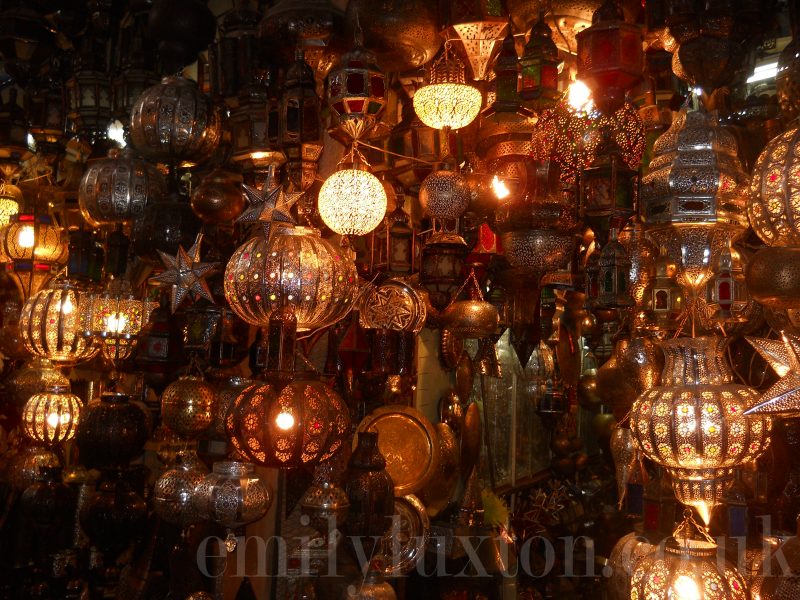
So, we ditched the map and just wandered. In my opinion this is the only way to “do” the souqs, although if you want to take your shopping experience very seriously you could take an expert guidebook with you, like Susan Simon’s Shopping Marrakech. With the dim light filtering through the slatted wood covering, and the winding stone alleys packed from floor to ceiling with Moroccan crafts and glittering treasures, the souqs are like an Arabian Nights fantasy. We ducked through a doorway into a courtyard surrounded by artisans’ workshops, a sudden calm amongst the bustle of the markets. Next door we were summoned into a real-life apothecary by the owner, a lively salesman. Huge glass jars filled with brightly coloured dyes – magenta, scarlet, indigo – or rich yellow and red spices, lined three walls from top to bottom. We walked away with a bottle of bright orange, nutty smelling argan oil and a bag of Ras El Hanout tagine spices. The name means “head of the shop” in Arabic and is a selection of the seller’s best spices – I’m assured that I’ve brought home the finest blend of forty five spices!
Eventually, we emerged blinking into bright sunlight and found ourselves confronted by the insanity of the Djemma El Fna. The huge square at the centre of the city is filled with carts lined with oranges and selling fresh juice, or stalls heaped with dates of more varieties than I knew existed. Men led Barbary apes on leads, and drummers in elaborate traditional costumes played for tips. We passed women in berkers (and one man in drag) offering henna tattoos, and one old man sat in front of a tray of teeth offering al fresco dental work. The non-stop soundtrack is of the shouts of hawkers and the high-pitched whine of oboe music from snake charmers, who squat by coiled black cobras waiting for tourists to stray too near. We were accosted immediately and before we knew it, found ourselves posing for photos with water snakes entwined around our necks. After the charmer blessed us for “good luck and good sex” with a kiss from the snake (and promised Sam six children), he began pressuring us for 300 dirhams – we settled on 100 (about £8-9).
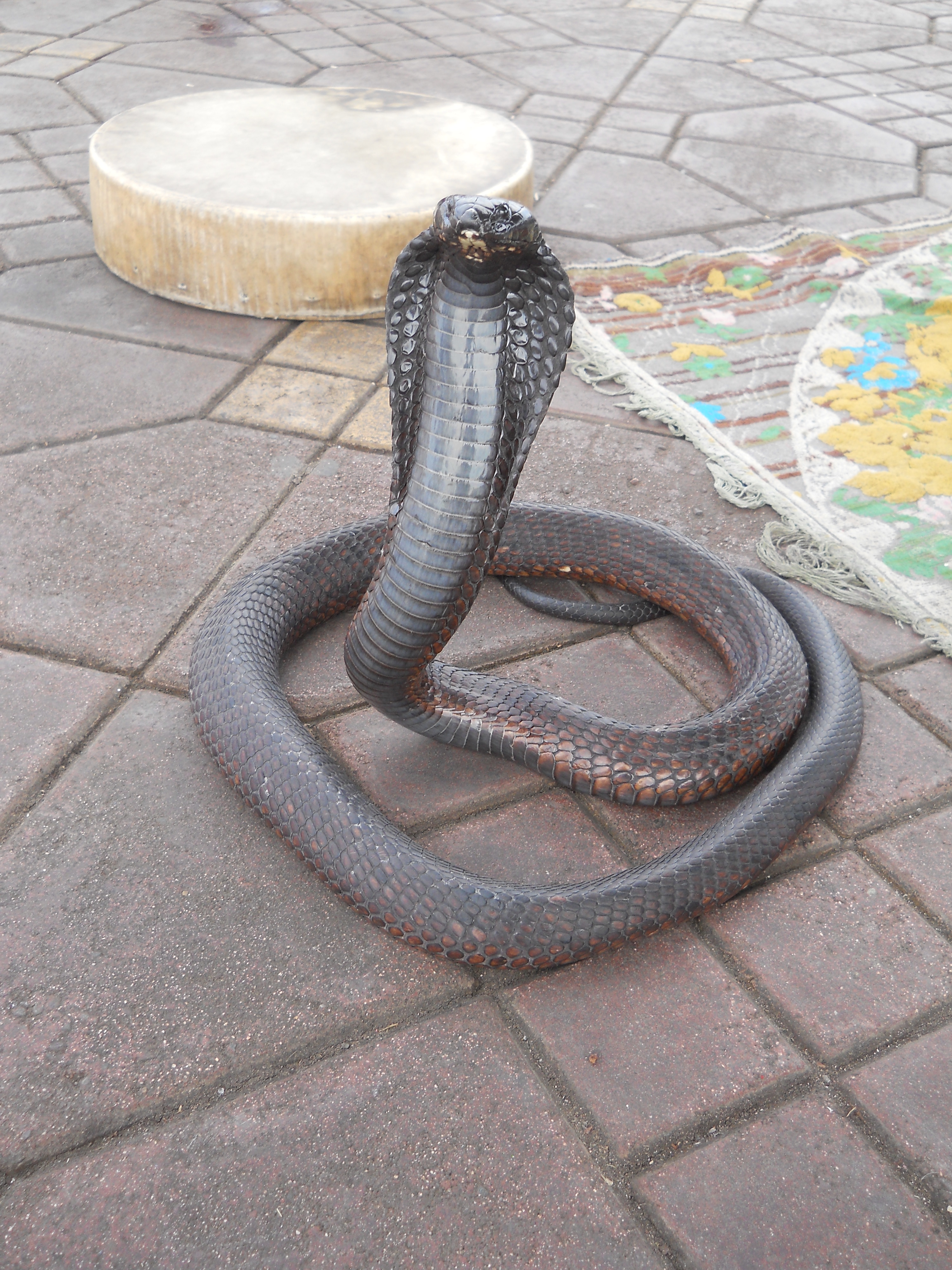
Any article or guidebook I read before coming to Marrakech failed to mention one important fact when describing the Djemma El Fna; that it’s full of salesmen. Tourists will not be left alone; at one point we stood still and took bets on how long before we were approached: I was right on the money with 30 seconds. What I learnt quickly was never to ask “c’est combien?” and to just give coins. Apart from the gentle harassment, though, the Djemma El Fna is a fantastic experience; like a bizarre, overcrowded movie set.
Saadian Tombs and Bahia Palace
In general, the first afternoon wasn’t our best in Morocco. After an incredible morning of discovery, we wanted to keep going, and packed so much into the day that it all became a tad overwhelming.
It started out great. After grabbing a light lunch of pastries from a shop near the Djemma El Fna – an extra sweet, spongy croissant for me and a something unnamed and stuffed with almond paste for Sam – we hired a caléche to take us on a tour of the city. These are bright green wooden carriages, drawn by two horses, which gather at the entrance to the Djemma El Fna by the Avenue Mohammed V. You can’t miss them – for one thing a line of horse-and-carts is difficult to miss and for another, you won’t slip past without the hawkers noticing you. We had more negotiating to do to get the driver down from 400 dirhams to 200 for one hour.
The caléche ride was a lovely, relaxing way to see the city after the chaos of the souqs and the square. We passed the Koutoubia Minaret, the three golden balls on the top glinting against the clear sky. The driver pointed out a few sights – the Kasbah Mosque and the King’s Palace (no photos allowed) – but mostly I enjoyed watching Marrakech unfold itself like a fairy-tale city before me. Old men dozed out the front of their shops, people sold paintings and photographs by the side of the road, and outside one café a barbecue-related disaster had veiled all the diners in a fog of smoke. Locals on mopeds zipped past performing incredible feats of bravery, weaving in and out of traffic, or arguing with the passenger behind them. We saw one man steering his moped whilst holding a sheep on his lap!
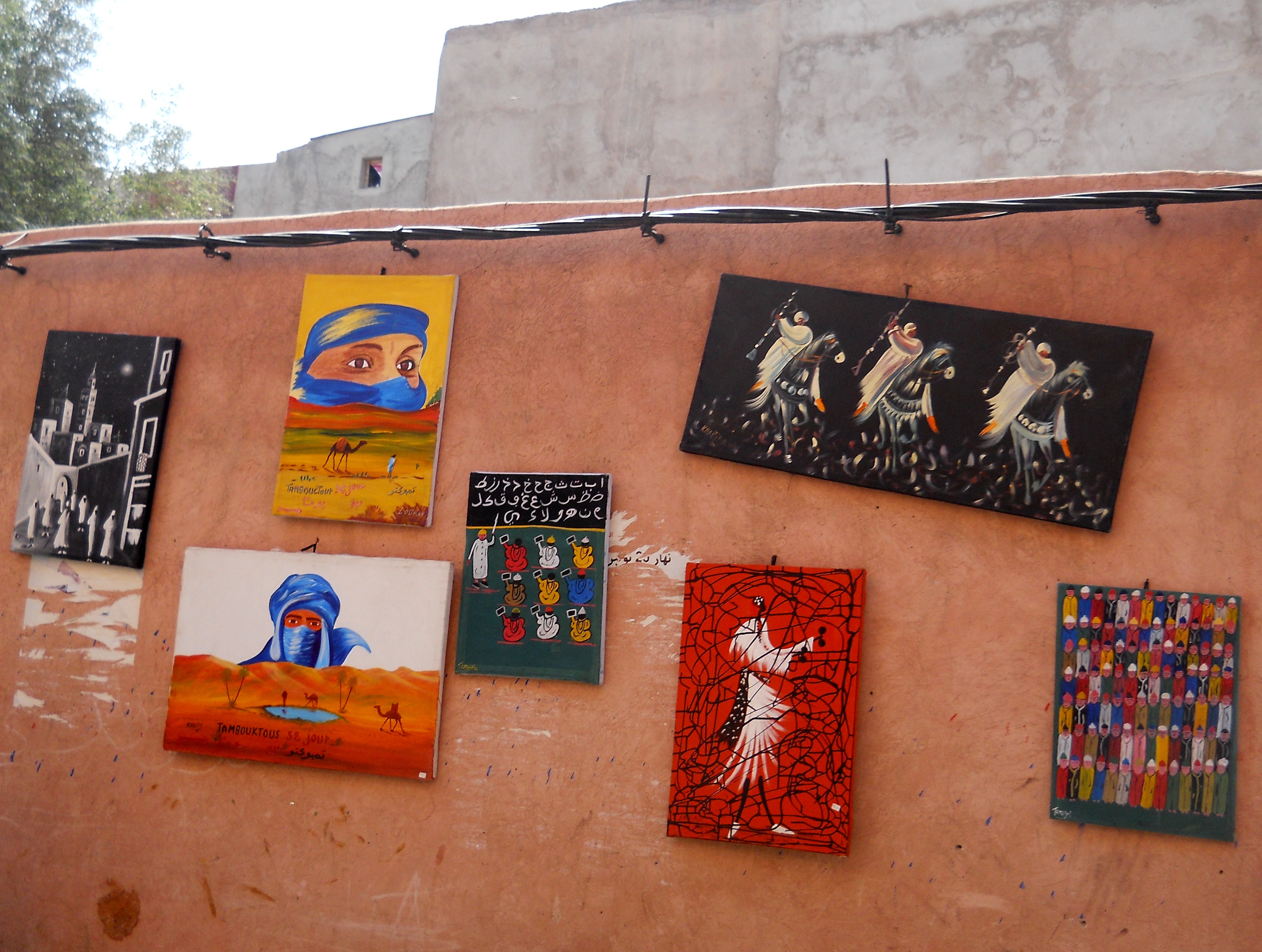
The caléche was a little stuffy; the red velvet seating, hot from baking under the midday sun, smelled musty and historic, like a museum interior. The stuffiness and the heat got the better of us, and we were both feeling dozy by the end of the hour. Out of the city centre, we clip-clopped past the ramparts – ancient city walls, pink and hugely thick – and into the Nouvelle Ville district, where traffic was calmer, roads were wider, and a little greenery adorned the salmon-coloured walls. The colonial architecture and big, fancy hotels were a far cry from the narrow, dusty streets we’d been getting used to.
After the caléche ride, we wandered down to the Kasbah district in search of the Badi Palace. We never actually found it. Marrakech is confusing and once again, my guidebook map proved itself useless! What we did find were the Saadian Tombs, built by Sultan Ahmed el-Mansour el-Dahbi in the 16th century. You enter through an incredibly narrow passage – single file, please – between high walls. Apparently, the tombs were walled up by one of the successors of el-Mansour, in a bid to forget his predecessor, and were ‘re-discovered’ by aerial photography in 1917.
A pretty interesting history, but I’m sorry to say the Saadian Tombs were a little bit of a disappointment for me. I’d seen pictures before going and thought this was going to be a huge complex of tombs with breathtaking architecture. That’s not to say the tombs aren’t beautiful, because the intricate carvings, mosaic-tiled walls, and pink-brown marble pillars are lovely. It’s just a little underwhelming; the complex is quite small, the rooms you can see into generally look the same, and beautiful carvings only excite me for a short amount of time!
After a short walk looking for the Badi Palace, we somehow ended up at the Bahia Palace instead. One palace is as good as another, we decided, so we headed on into La Bahia for a look. The rooms of this large, one-story mansion, spread around a central courtyard, are completely bare. The palace was looted after the Grand Vizier died, leaving the rooms starkly empty but still opulently decorated, an interesting contrast. The gilded, inlaid woodwork ceilings are pretty impressive, as are the latticed, woven and carved surfaces on every wall and archway, with turquoise and gold embellishments. The halls look sadly empty without furnishings, and it’s hard to conjure up any real sense of grandeur in spite of La Bahia’s décor.
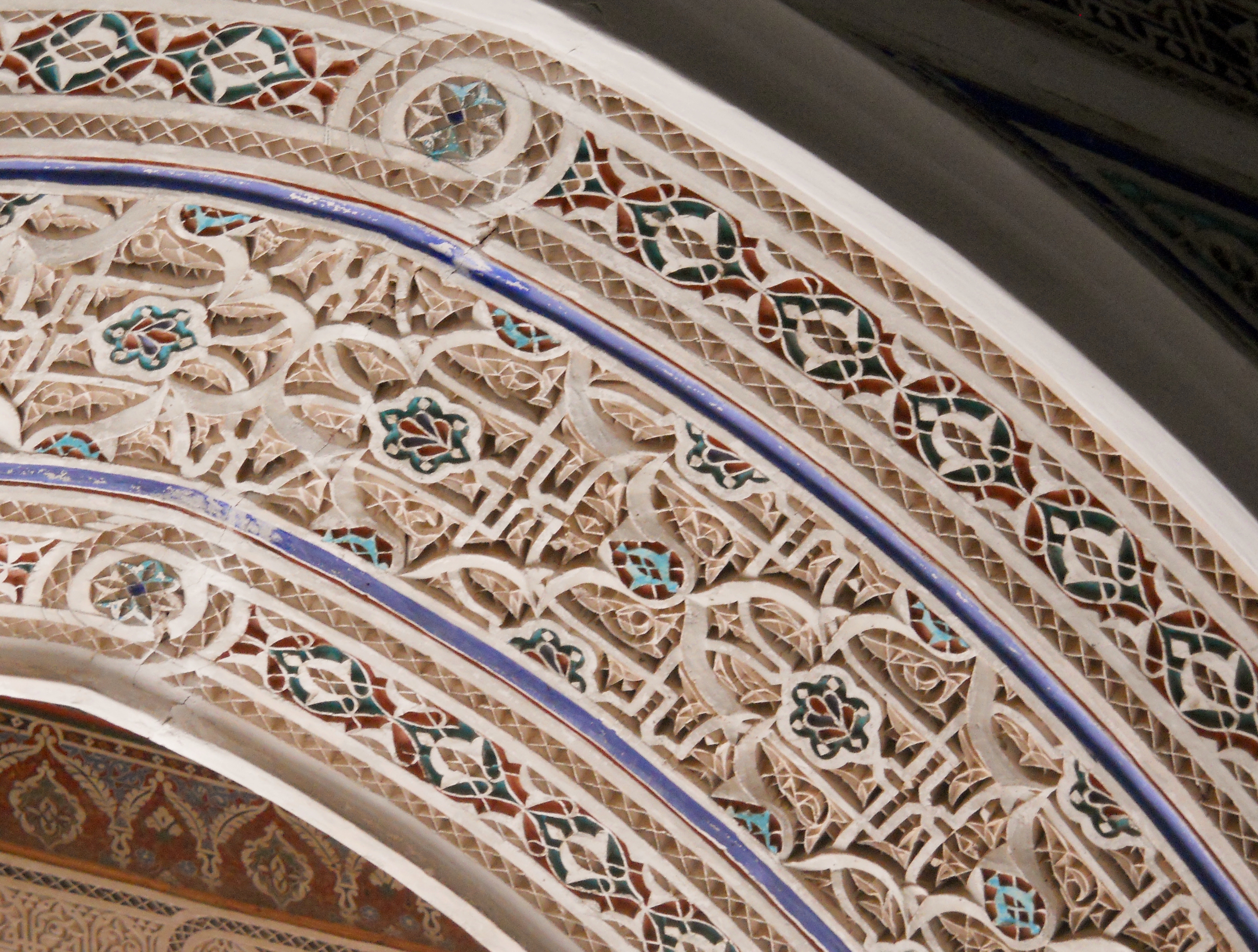
Worn out from sightseeing, we decided to head back to the riad. The quickest way on the map was through the souqs. I can’t tell you why logic didn’t kick in and overrule that decision based on the experiences earlier that morning. Sadly, it didn’t, and we strolled foolishly into one of the alleys leading away from the Djemma El Fna. Then into another alley, and then another, and we chose left, then right, then left again, trying to follow our increasingly diminished sense of direction. Before we knew it we were lost; not charmingly lost in an exciting country, but utterly, couldn’t re-trace our footsteps if we wanted to, possibly never getting out of the souqs, lost. The multiple times we asked the way to Rue El Gza we were led or pointed in completely different directions. Even when we did finally find ourselves back on the main road, we somehow took another wrong turning and got ourselves lost again.
A kid claiming to know exactly where our riad was offered to guide us, even after our insistence that we had no money (only slightly true). I would have given him a bit of cash, but just like the night before he didn’t really know the way and led us in circles until two of his friends (who we’d already passed twice) laughingly agreed to lead us. When we finally arrived back at the riad, taking what I now know to be a much longer route, I refused to give them any money. We didn’t ask for their help and we told them we had no money. They got a bit cross, but thank goodness for Khalila – the riad manager – who chased them away with an aggression much bigger than her tiny frame.
We’d left the main square (about 20 minutes from our riad) around four o’clock. We arrived at the riad at twenty past six. So not the best end to a long, hot and tiring first day!
After showers, we had a good dinner at Restaurant Amalay in the Nouvelle Ville. I’ll do separate reviews for all the food. The cool evening air relaxed us a bit, as did the food, but generally the first day in my memory is a heady blend of excitement, stress, and confusion.
Information
Caleche Ride –Dh 200 for one hour (negotiation required). Caleches are available on the Rue Moulay Ismail, near the Djemma El Fna.
Saadian Tombs – Dh10 per person. Rue de la Kasbah, near Kasbah Mosque.
Bahia Palace – Dh10 per person. Rue Riad Zitoun el-Jedid.
Day Two in Marrakech
21 March 2012
We decided to take the second day easy, after the stress of the day before. After a late breakfast, we walked to the Nouvelle Ville of Marrakech, where we spent the day. The wider roads have the unexpected effect of making the traffic seem more intense; four lanes of cars, mopeds and donkeys squeeze into two lanes, overtaking, undertaking, and endlessly honking. It’s the presence of pavements that makes the Nouvelle Ville a truly relaxing experience; a welcome break from constantly leaping out the way of mopeds which will speed down any alley, however small or far from a real road it may be.
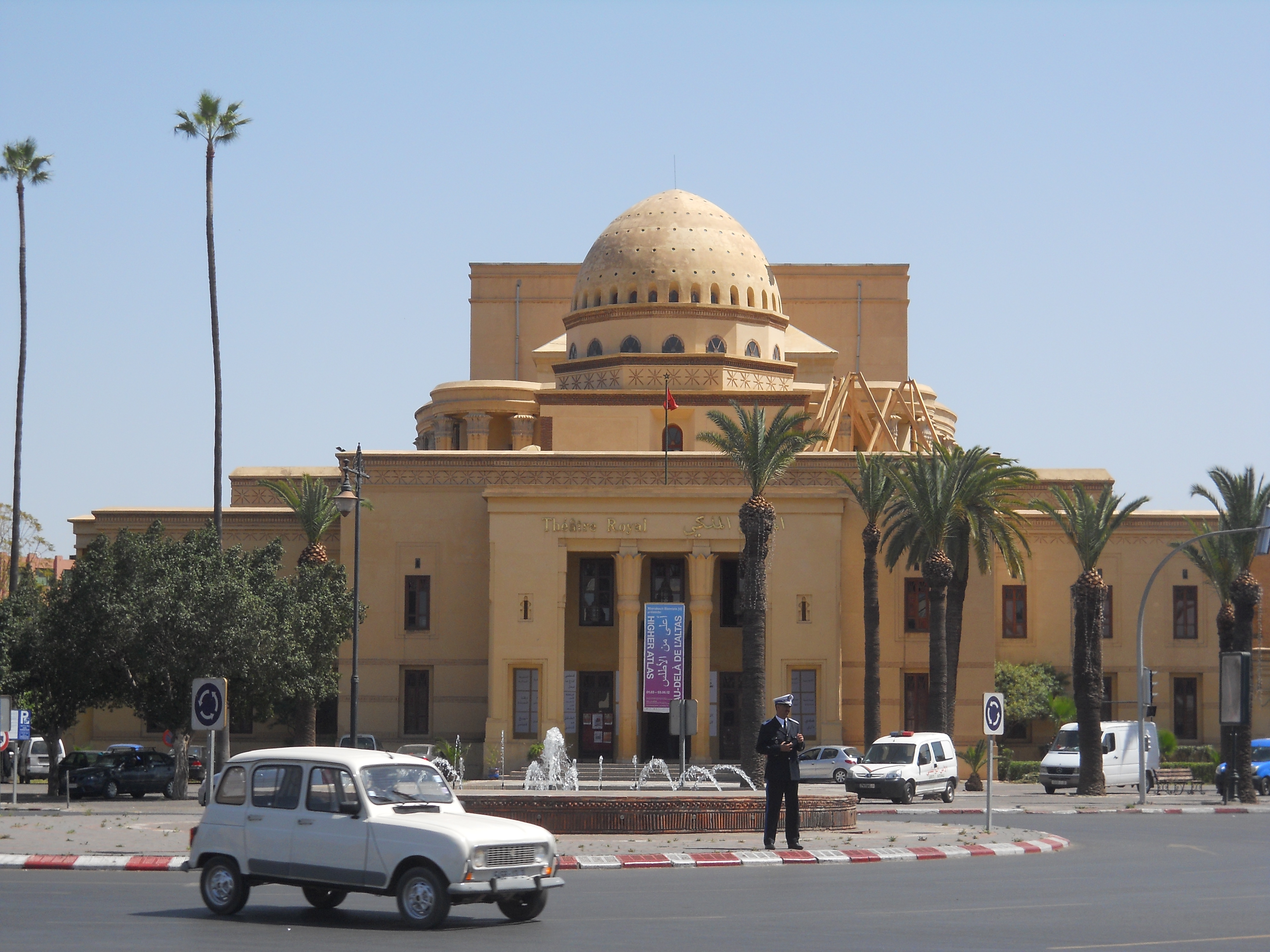
Les Jardins Majorelle
After the errands were all run, we hopped into a taxi to Les Jardins Majorelle. These were barely a ten-minute walk from the train station, but we paid Dh10 for the journey all the same (and had to push for that price). Tourists will always pay more for a taxi in Marrakech!
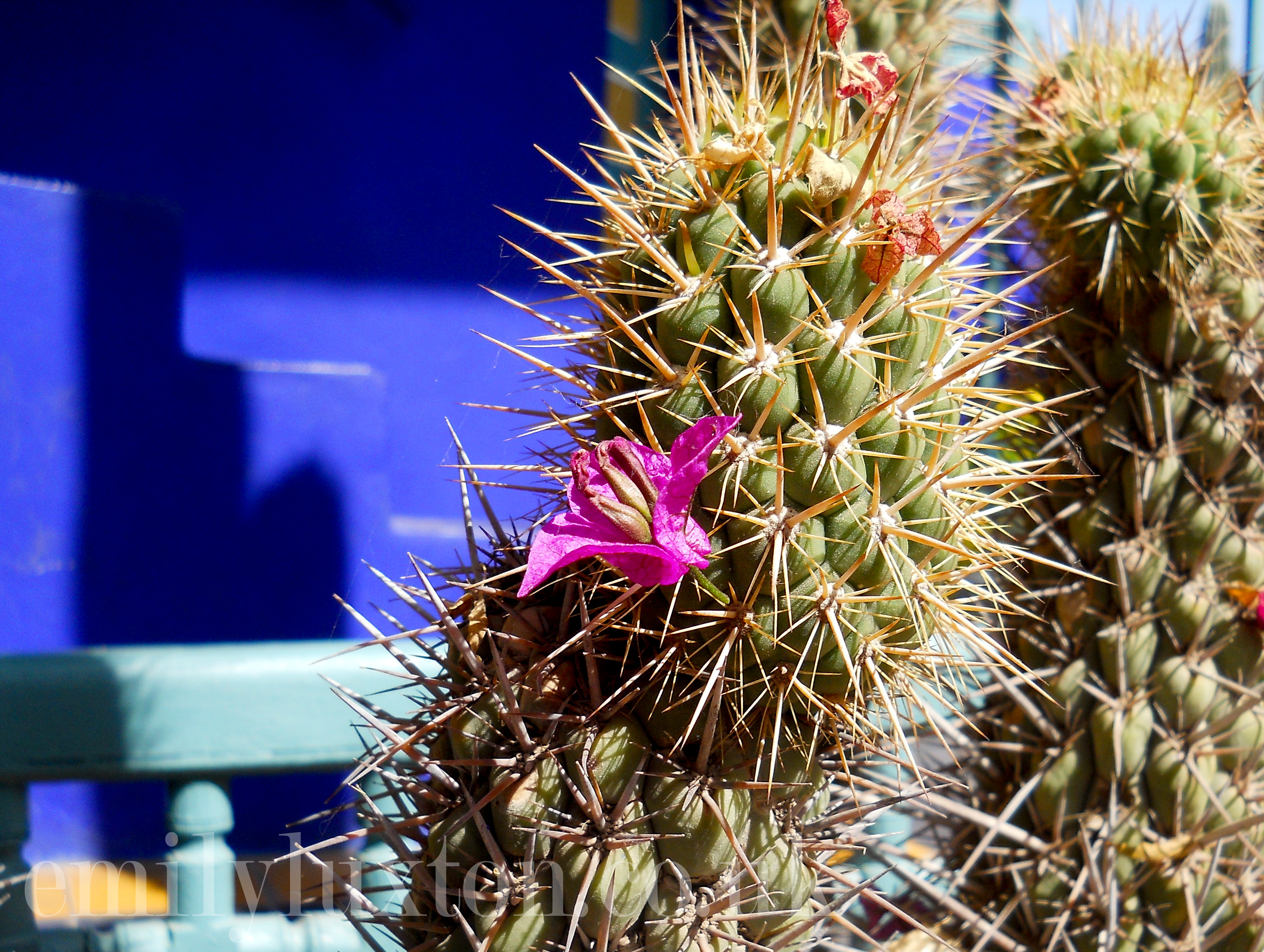
As soon as we were out of the taxi, we were approached by a man who seemed to be offering excursions (from a roadside trestle table and a board pinned with place names). He told us the gardens were closed until three, but that we were lucky because a market was on at a nearby mosque, a chance for non-Muslims to view the mosque which only comes around once a month. He began to lead us there, chatting about the various handicrafts which would be available. As soon as we said we didn’t want to buy anything, he stopped leading us and suddenly remembered that the gardens were open after all. Mysterious.
Les Jardins Majorelle were a perfect way to unwind; cool, shady paths winding alongside huge pools filled with fish and turtles. It cost Dh50 each to enter (less than £5) and we spent a good hour there hiding from the scorching midday sun and enjoying the intense colour scheme. Everywhere you look, the green of the plantlife and cacti is punctuated by a vivid blue wall or a fluorescent yellow flowerpot, interrupting the calm of the fauna like a crazy mirage. Please pop back to my previous post for a bit more detail on the gardens and some of my photos.
Spellbound at Les Jardins Majorelle in Marrakech
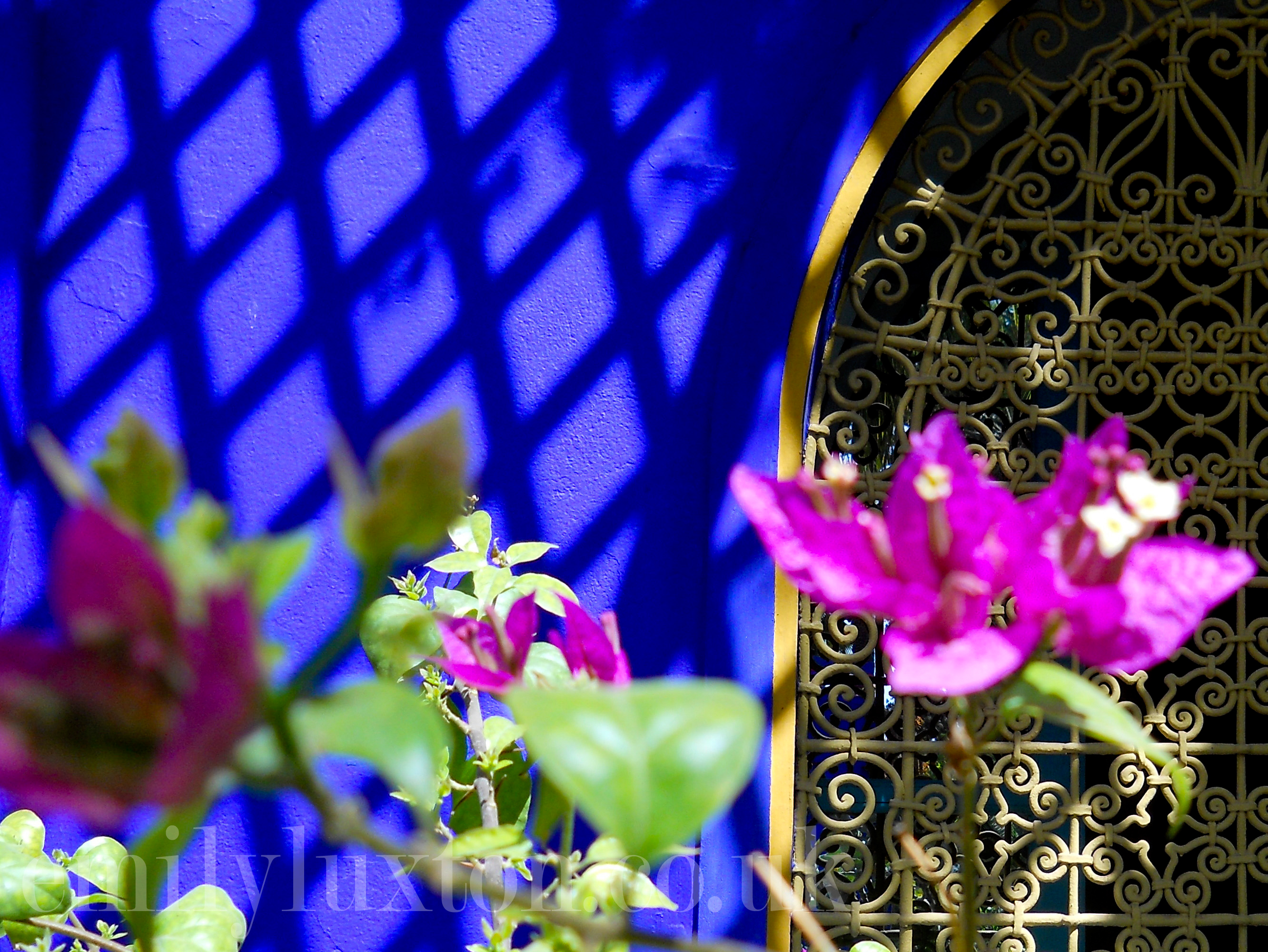
When the pink and terracotta walls of the red city start to overheat your senses, visit the Majorelle Gardens to reinvigorate yourself. With its cooling colour palette, green pools and shaded walkways, this is the perfect place to chill-out in Marrakech. The idea of visiting a garden may sound a little dull, but these exquisite are deco gardens are a far cry from the neat English flowerbeds I’m used to.
Designed by French artist Jacques Majorelle in the nineteen twenties, Les Jardins Majorelle still look incredibly modern. The uber-bright colours and bucket-loads of blue Majorelle paint (an intense shade of primary blue a little like cobalt, trademarked by the artist) look like the set of a glamorous fashion shoot. It seems hardly surprising that the gardens were bought by French fashion designer Yves Saint Laurent in 1980, who ensured they were well cared for and who added a museum housing a large collection of Islamic Art and North African artefacts. Laurent’s ashes were scattered here when he died in 2008, and a modest memorial to him can be found in a shady corner of the gardens.
Les Jardins Majorelle are a beautiful place to explore in Morocco. Dominated by a bright blue-and-yellow villa, coconut palms and thick shoots of green bamboo line winding pathways. In huge green pools you’ll see bright flashes of streaking orange goldfish, or watch turtles lazing in the sun around the edges. The gardens provide some much-needed downtime for all your senses; a soundtrack of gentle birdsong makes a gorgeous change to the roar of traffic and squeal of moped tyres. Flowerpots in striking shades of neon yellow and orange complete the colour scheme, breaking up the cool blues and greens, so that round every corner is a vivid new surprise.
If you’re in Marrakech, make sure you check out this gorgeous oasis of colour – if anything just to give your eyes a break from the monotony of pink-on-pink.
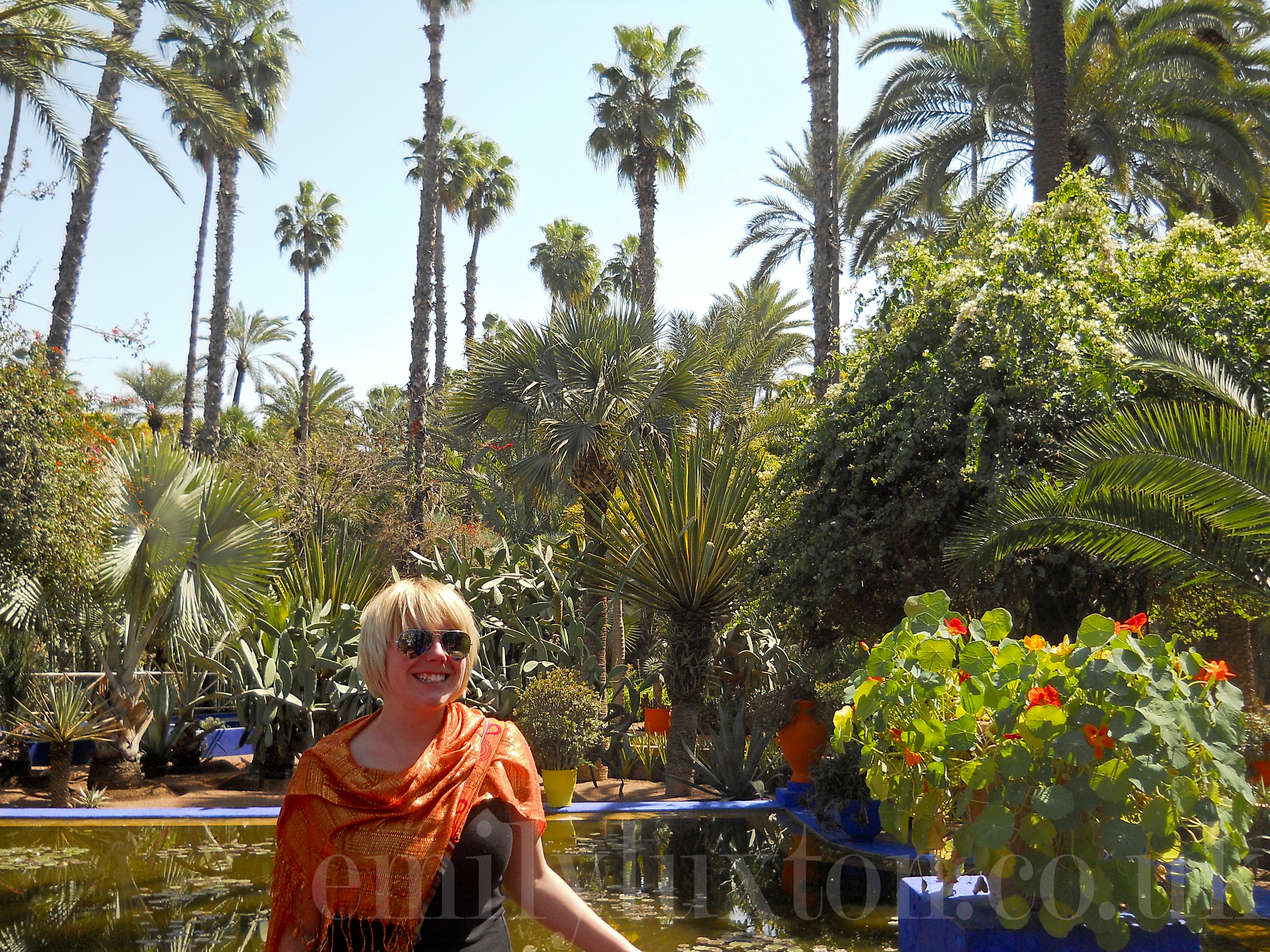
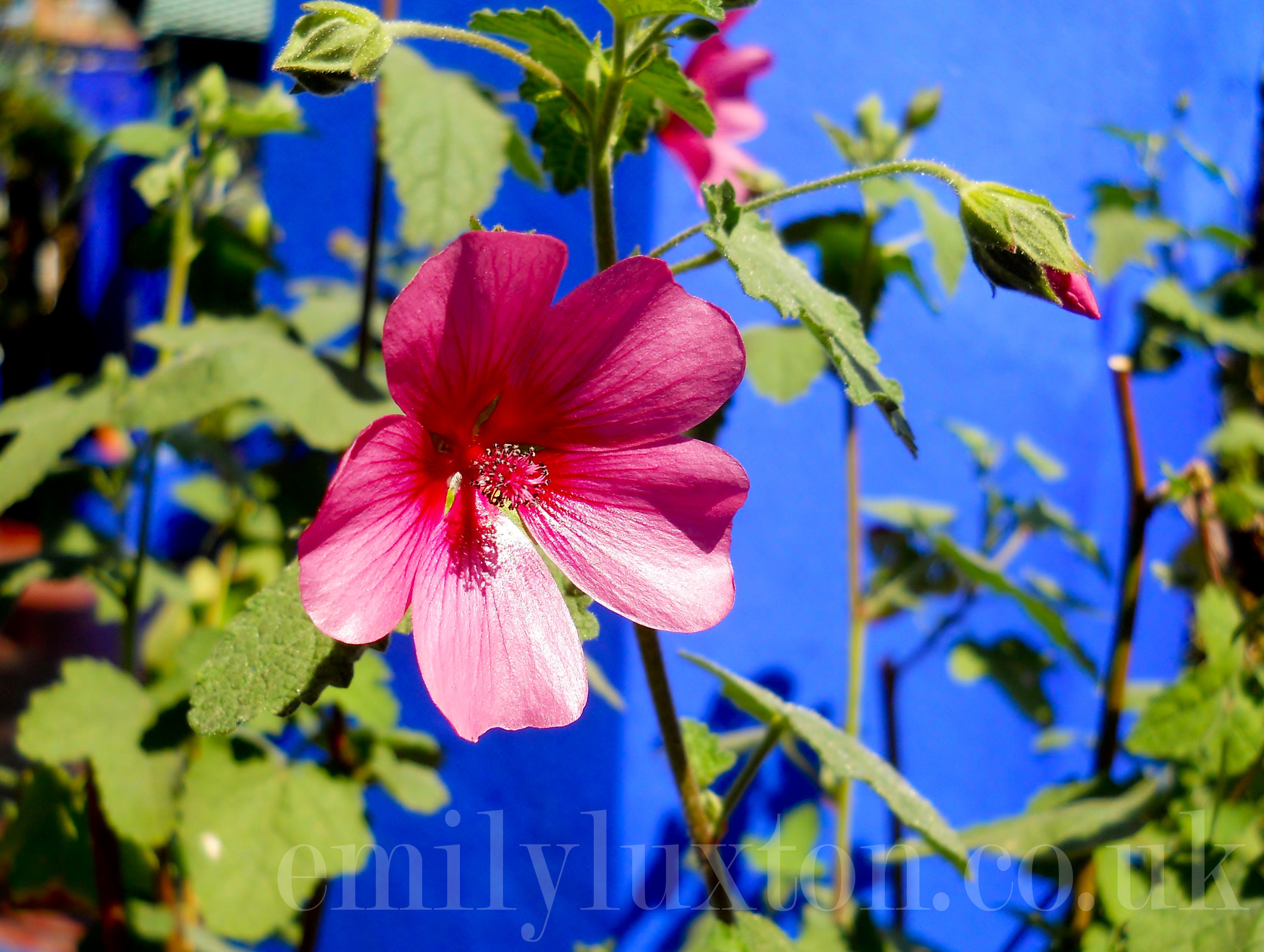
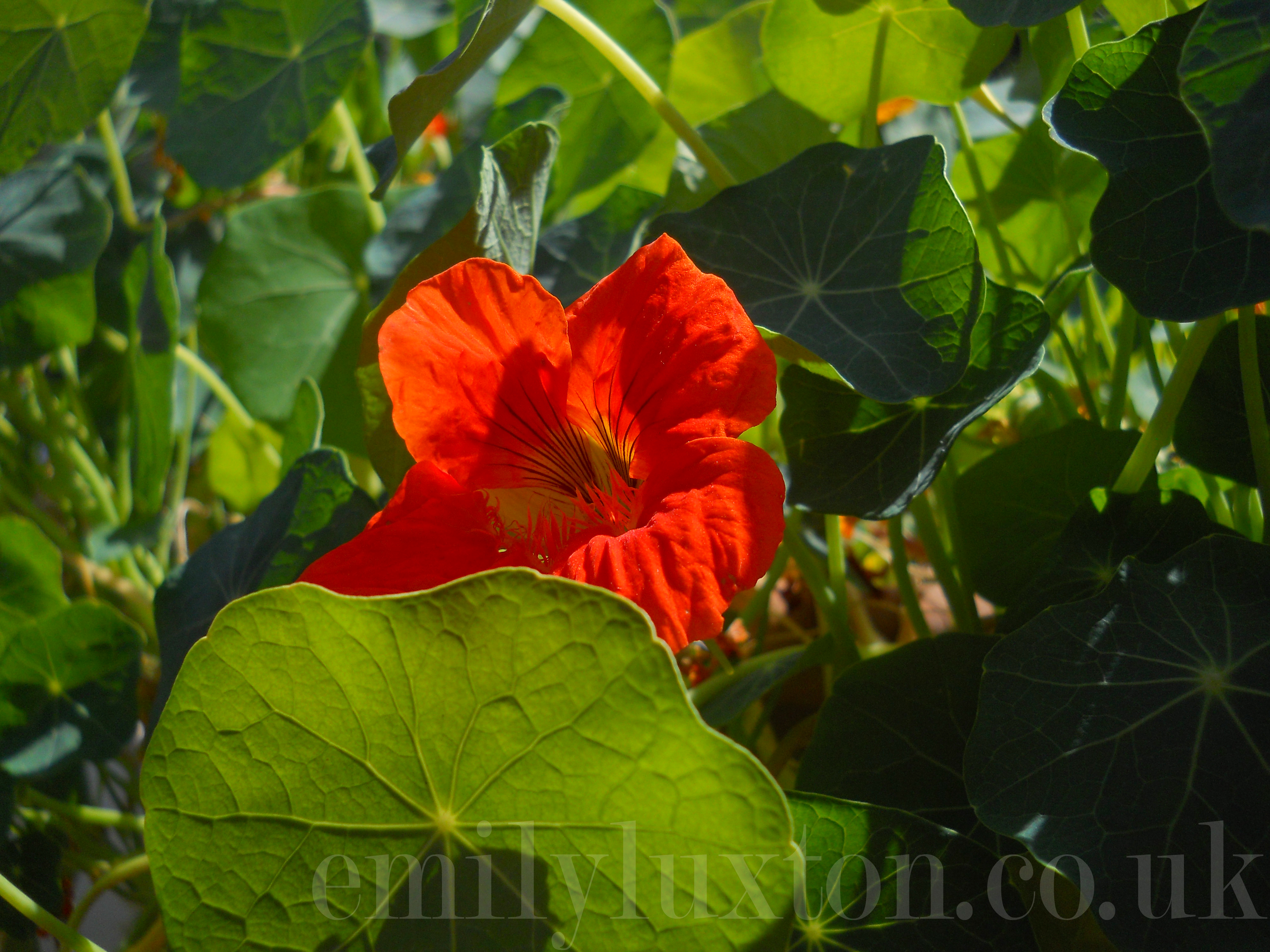
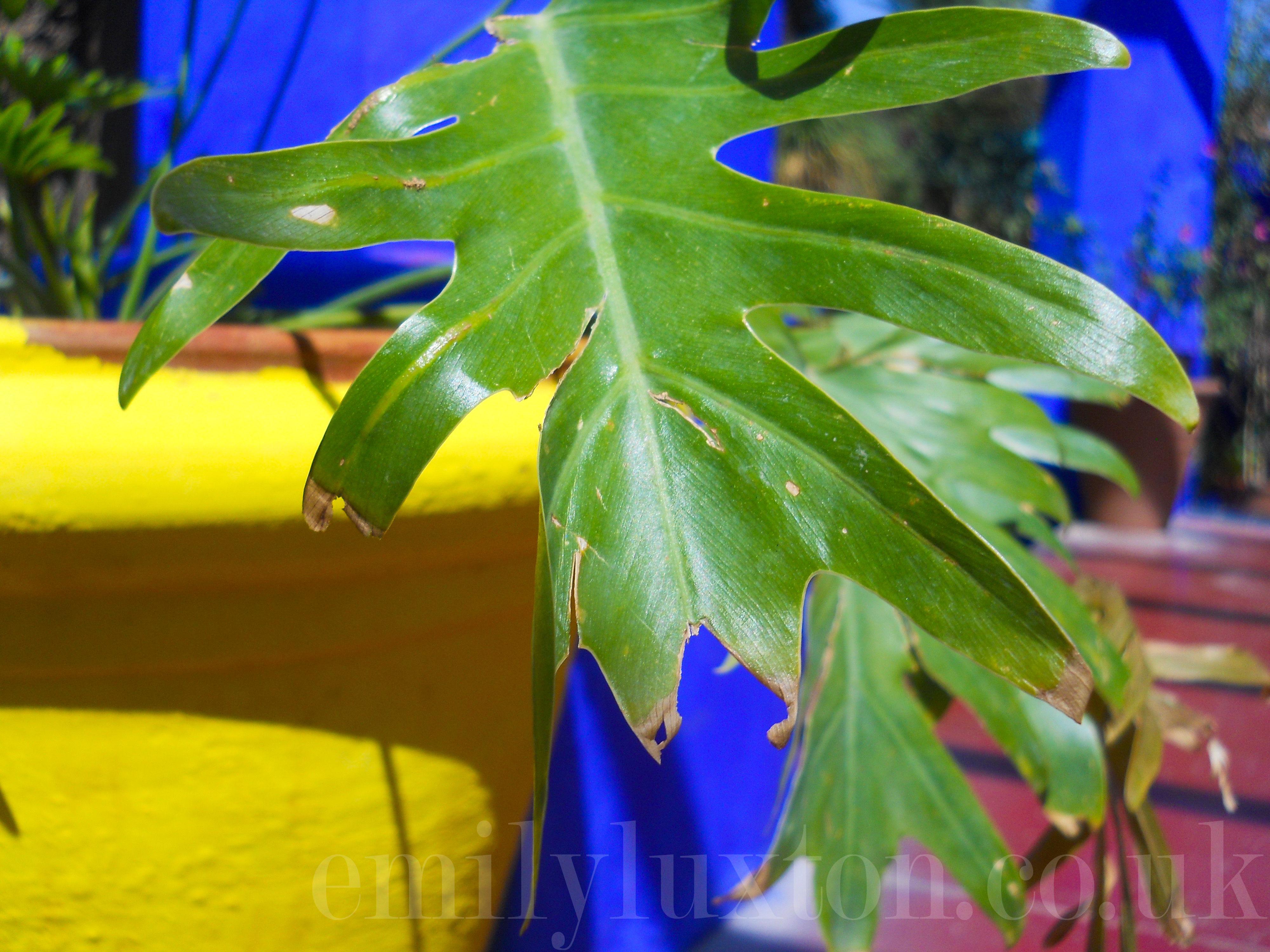
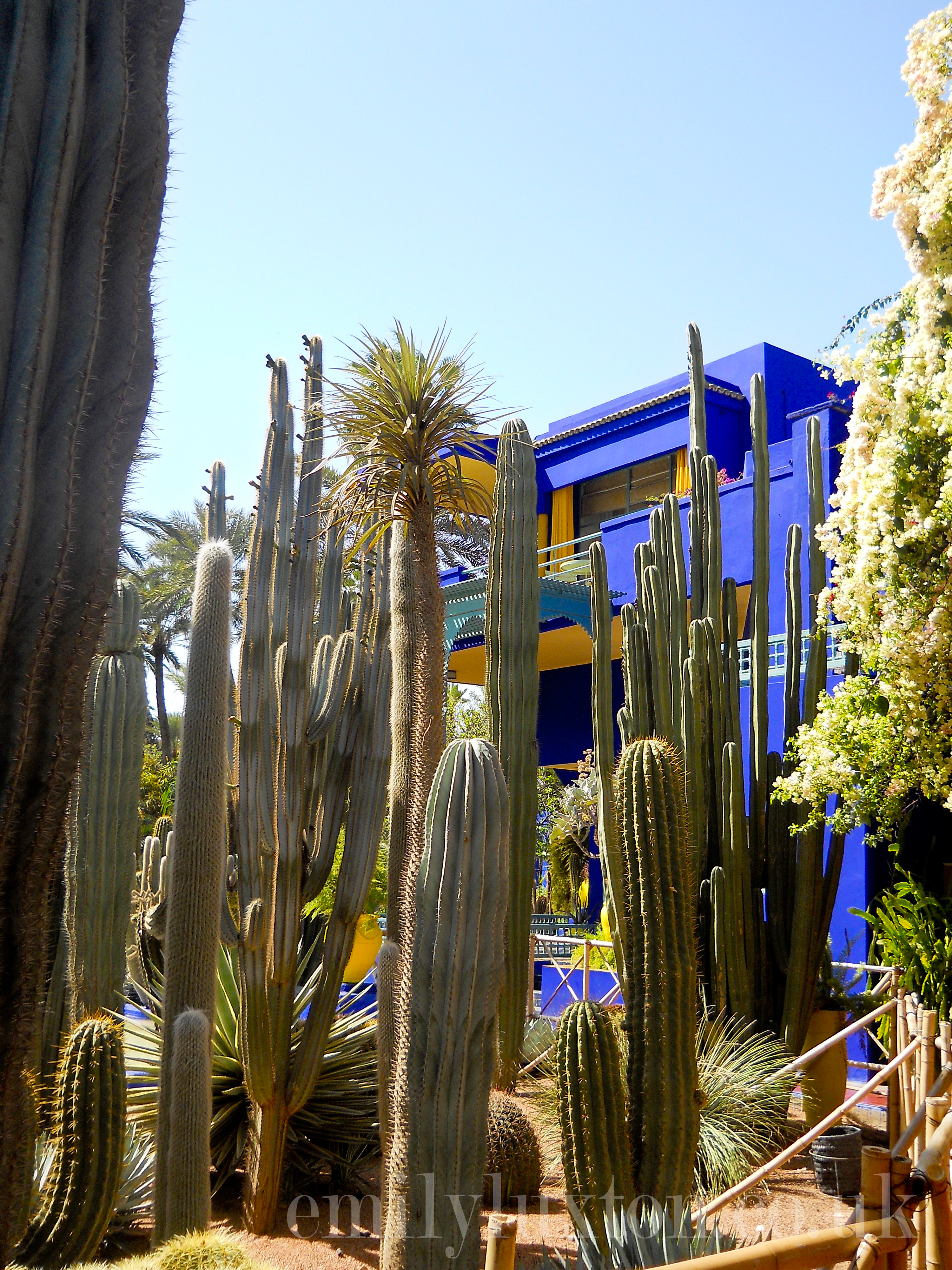

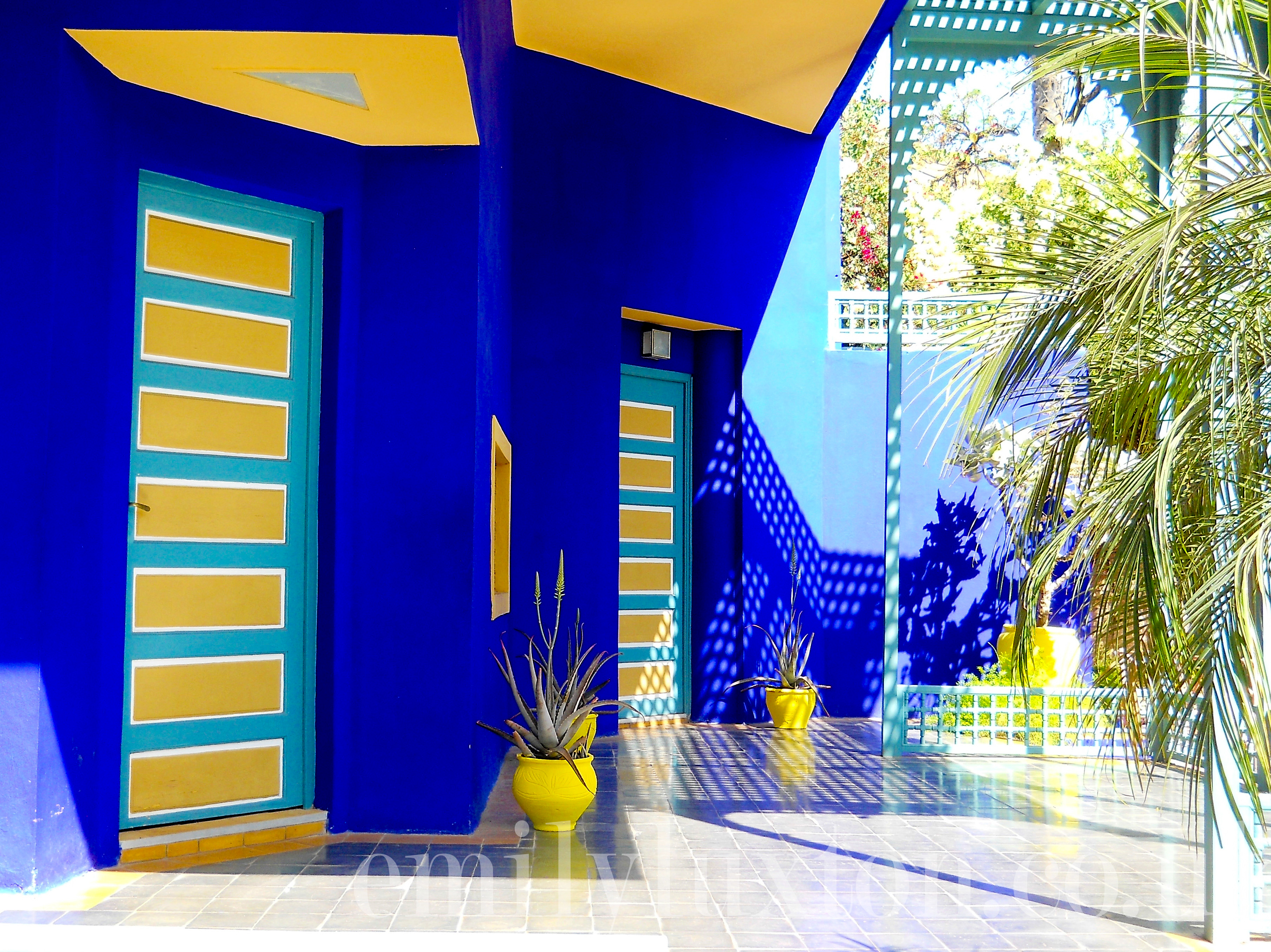
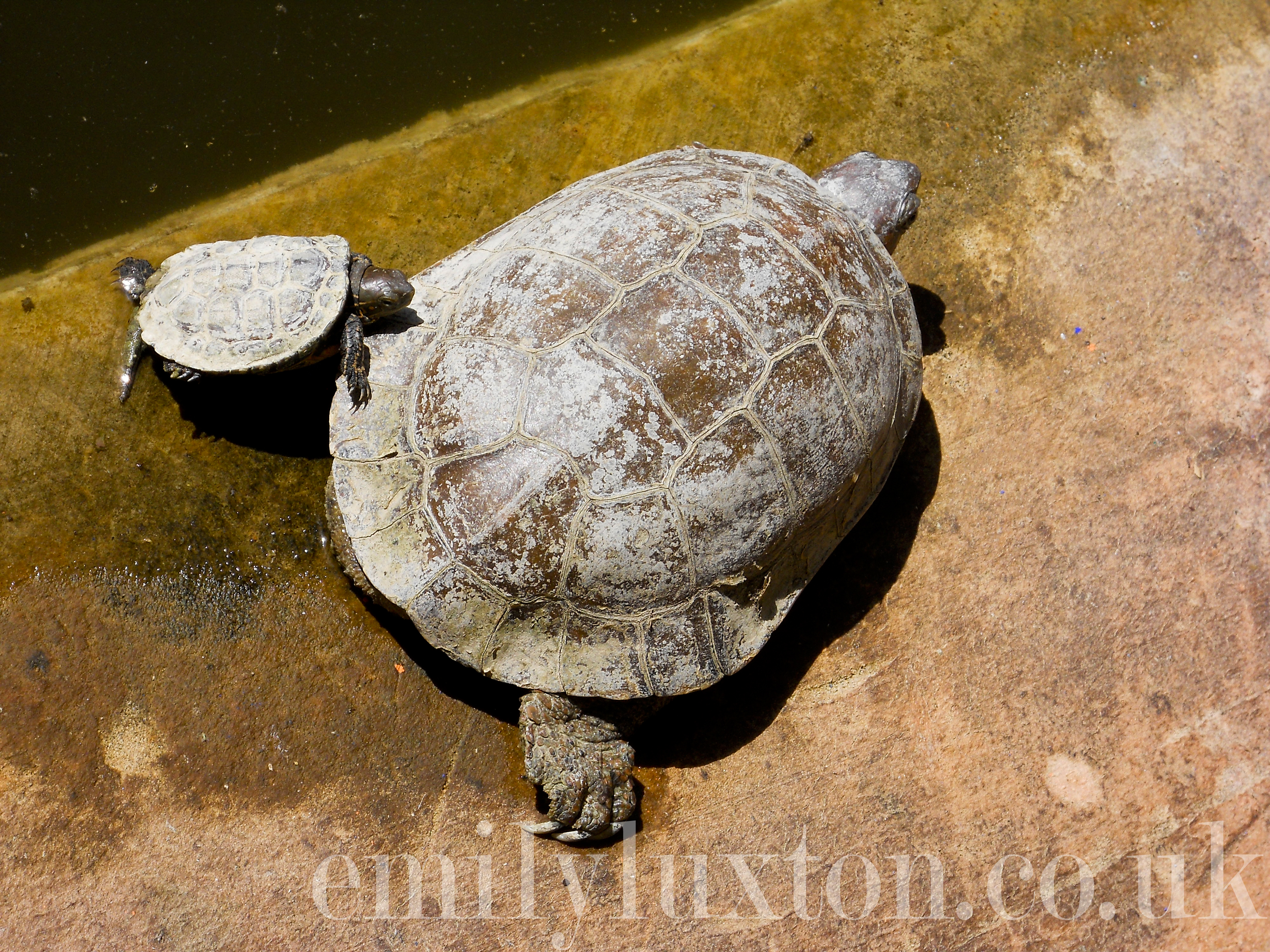
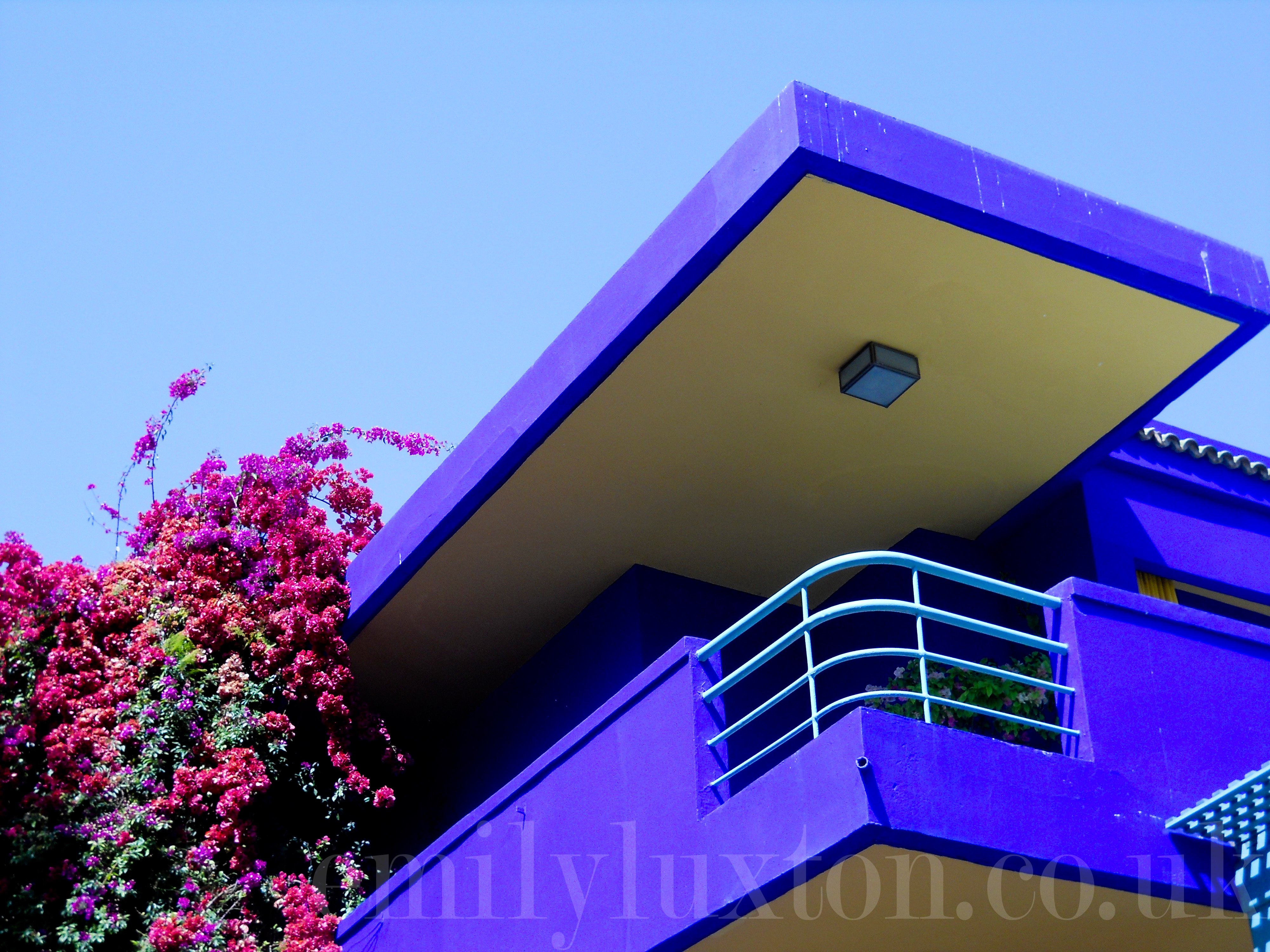
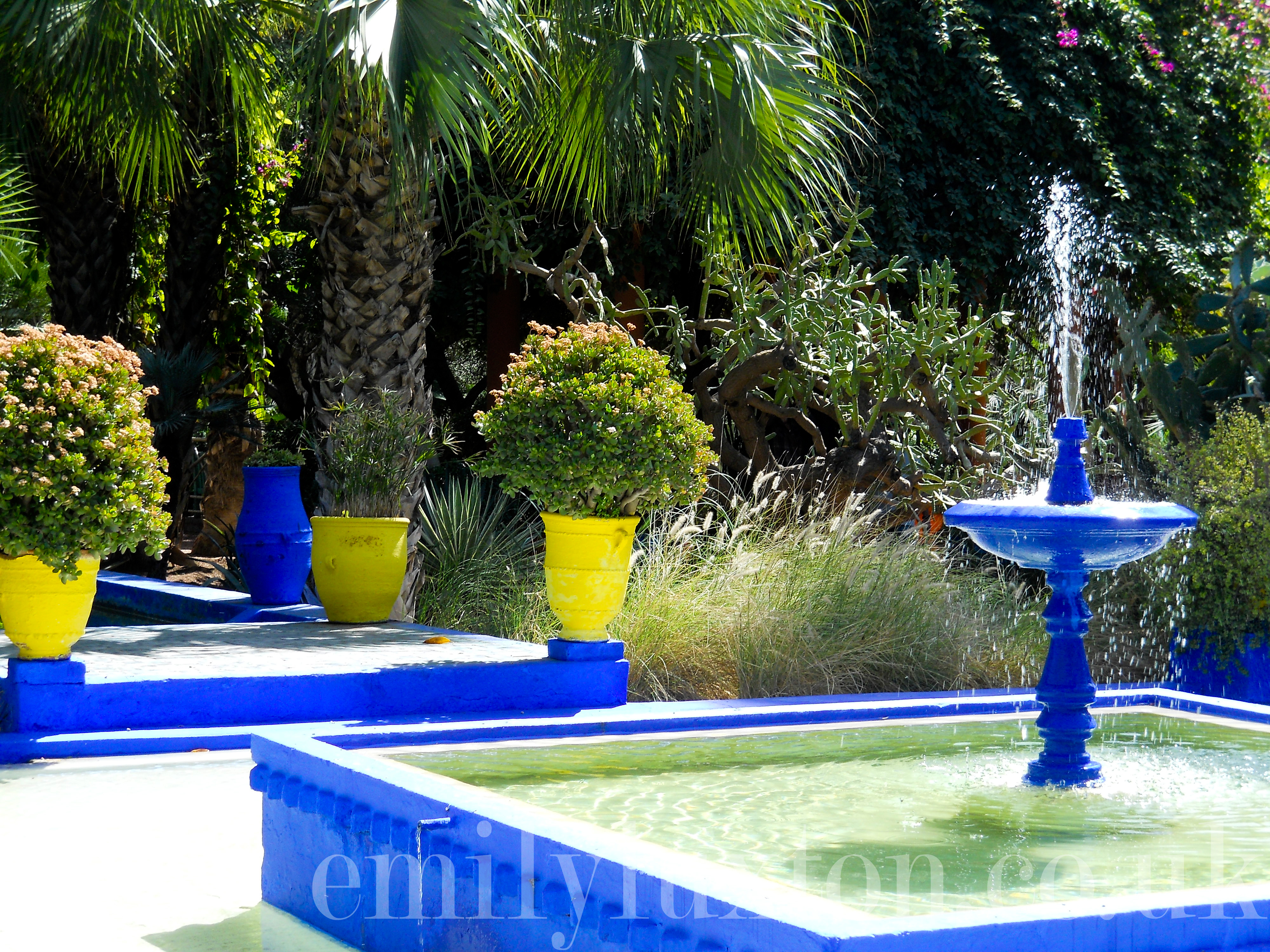
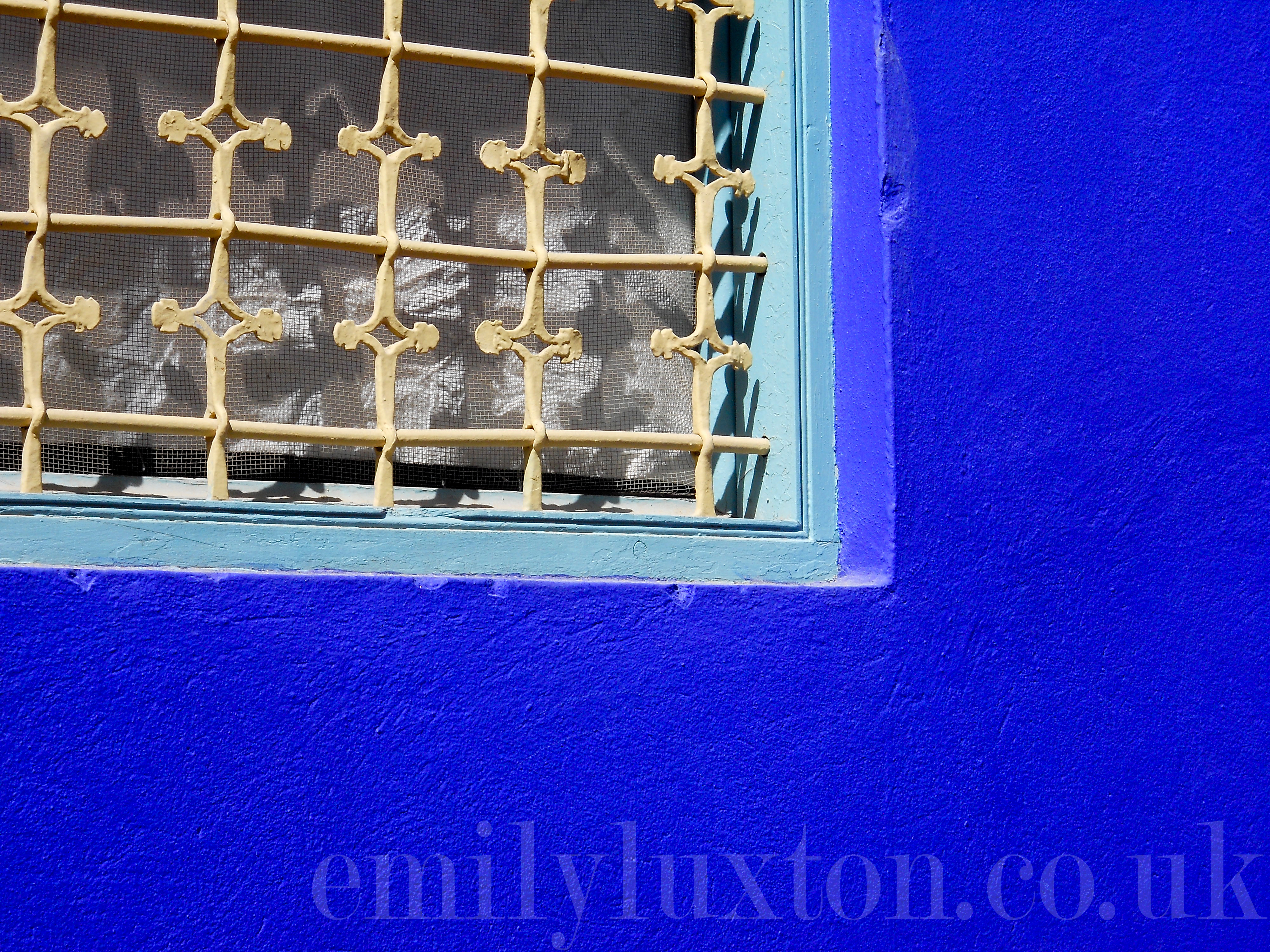
Exploring Marrakech New Town
After that, we took a slow walk down to Rue de la Liberté, a quiet road in the heart of the new town, which looked more like a cosmopolitan corner of Paris than a street in Marrakech. This little road is home to a fantastic array of art galleries, antique stores with kooky window displays, and tiny little boutiques selling jewellery, fashion, or Moroccan handicrafts (a tad pricier than the souqs but with all the comforts of air-con and fixed prices).
In amongst the trendy art scene is the super chic Kechmara, where we stopped for lunch on the roof terrace. We found ourselves surrounded by more greenery; leafy climbing plants and blossoming trees block out any view of the city outside and create a lovely sense of seclusion. I will do a full review of Kechmara separately – as with all the food – but this was a perfect stop for lunch and one of my favourite places we ate in Marrakech.
Wanting to relax in the sun and rest our feet, we ordered cocktails (Dh80 each), but these were absurdly strong. Sam’s ‘Marrakech Iced Tea – a minty take on the Long Island classic – tasted like spiked Listerine and although the fruity flavour of mine was delicious, I still couldn’t finish it. Cocktails here are definitely for getting drunk rather than relaxing during the afternoon! This is actually a pretty cheap place to get lunch; there are light snacks or a discounted menu of the day option for a lot less than the meals we went for. The friendly, English speaking staff and English menus make it perfect for tourists, too.
l’Ensemble Artisanal
After lunch, we walked down to l’Ensemble Artisanal. This is a complex of stores and workshops where you can watch Moroccan handicrafts being made. Entrance is free, prices are fixed, and I found I could browse without any of the sales pressure I’d experienced in the souqs. We visited in late afternoon, and even though there were quite a few visitors around it was so quiet that I felt like I was disturbing the peace every time I laughed. The shops are cool and dark, and after walking in out of the bright sunlight I found myself squinting at treasure troves piled high with silverware, or shoes, or leatherwork.
We watched women making huge rugs by hand, an incredibly laborious process which can apparently take around a month to complete. Individual pieces of wool, around an inch in length, are looped over and around the taught strings of a loom, with the ends poking out on one side so that on the other side a solid wall of colour begins to build up. Other colours can be introduced to make intricate patterns. I had a go at knotting a few pieces of wool and really struggled with it. The lady I ‘helped’ was unbelievably fast, but I could see that it would still take weeks to finish. I should mention that we did have pay Dh10 each for the privilege of having a go, something I wasn’t expecting, but I didn’t mind as the ladies were very friendly.
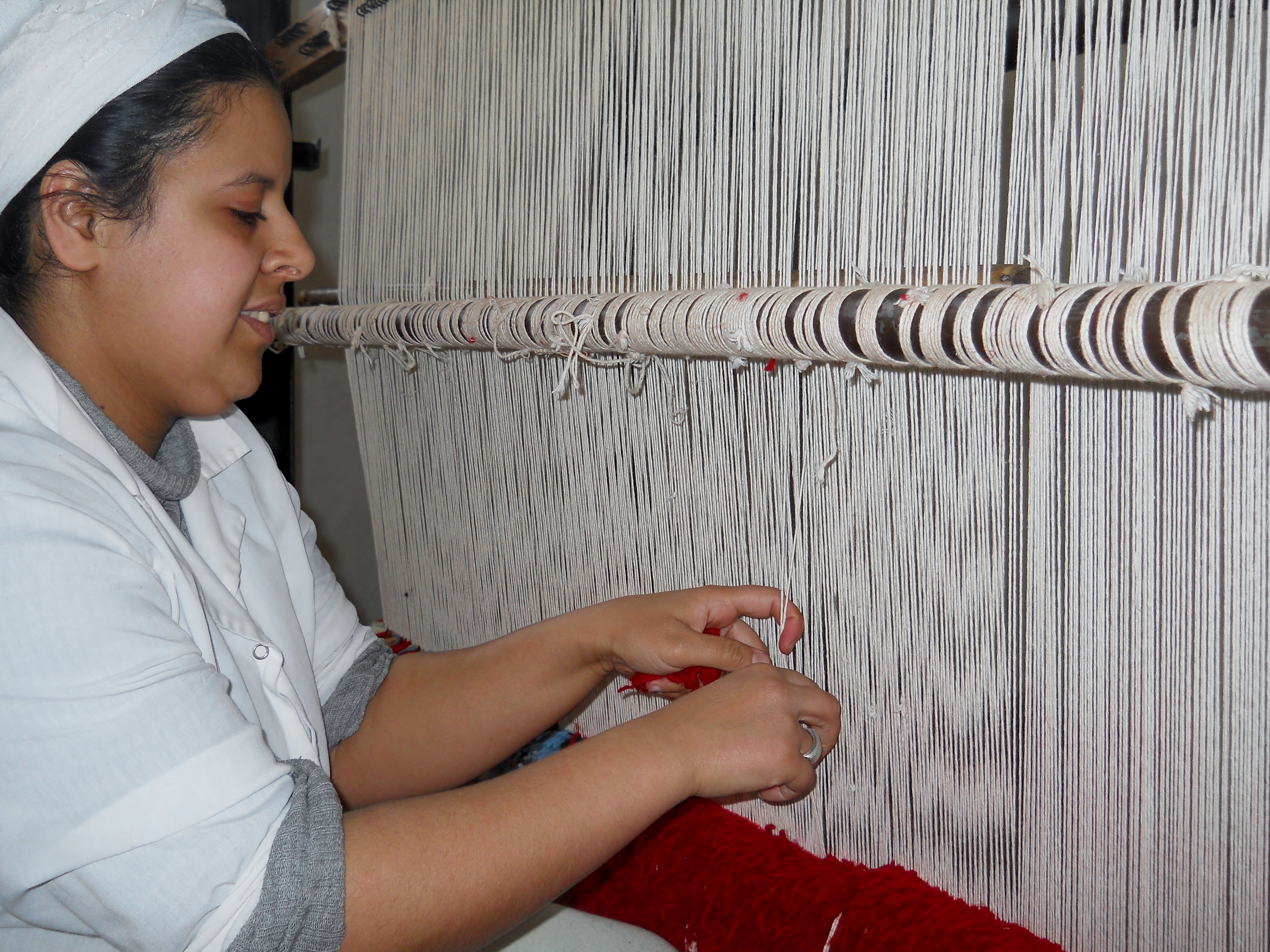
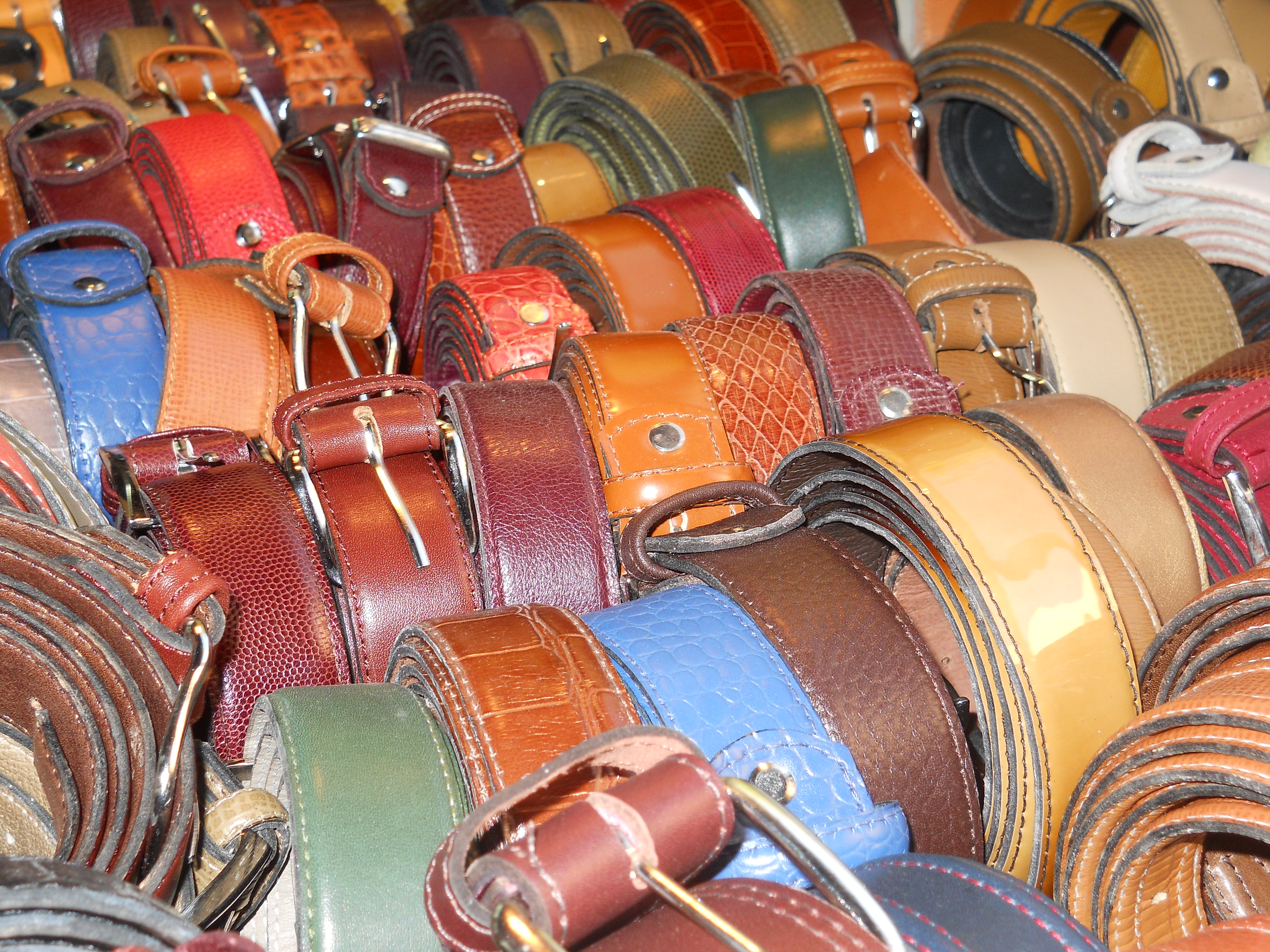
Cyberpark
We sat in the Cyberpark across the road for a while and enjoyed some more greenery. The cybercafé and free Wi-Fi seem to have made this park a bit of a social hub for Moroccan teenagers, but it’s still a pretty peaceful place to relax and unwind. We chatted to an old man for a while who said he wanted to practice his English.
He marked the best places to visit on our map, told Sam he should marry me as I’d make a good wife (we got that a lot), took a few photos and eventually harassed us for money. White people seem to have an unfortunate reputation as walking wallets in Marrakech, and lots of industrious locals will try their hand at offering a service or some knowledge (such as directions) and then requesting payment. It’s a bit of a culture shock; in England we’re a bit old fashioned and stick with the time-tested method of agreeing on a price before we give away the thing we’re selling!
Djemma El Fna
As the day began to slip away, we walked across to the Djemma El Fna and sat on one of the roof terraces overlooking the square and watched the sunset behind the Koutoubia Minaret and the lights come on around the square, which was now full of food stalls.
The Djemma El Fna is so atmospheric at dusk, smoke rolling over the white canvas food tents, storefronts bursting with glowing lanterns, people squatting by small fires on the floor, and kids chucking light-up toys four stories into the air. The air was heavy with the smells of spices and barbecued meat. It was a clear day, so we had incredible views across the rooftops and to the Atlas Mountains, and heard the minarets across the city strike up the scratchy whine of the call to prayer.
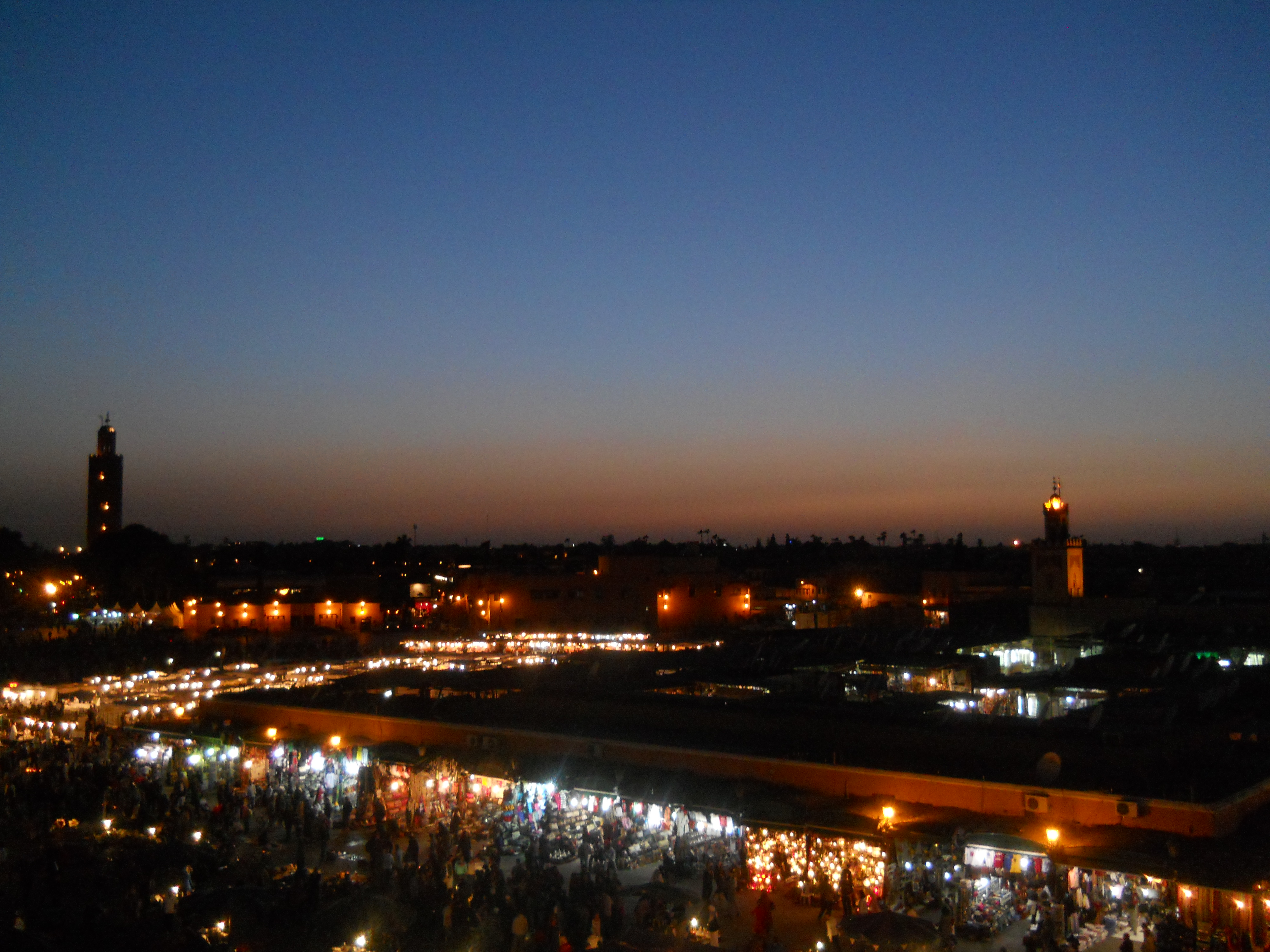
Dinner at Djemma El Fna
We wandered into the stalls and immediately got grabbed by the staff of Rachida Majid’s. It’s very hard to say no to a round of applause! The techniques to get passers-by to stop and eat at one particular stall range from offers of free mint tea, to jokes of “air-conditioned seating”, to one shout of “come and have a butchers” in an absolutely spot-on cockney accent!
We sat down to bread with olives and tomato and chilli sauces, Moroccan salad, calamari, and mixed barbecued skewers with pepper and onion, beef, lamb and chicken. Bucketloads of delicious al fresco food, right in the heart of everything; surrounded by thick smoke and the sizzle and spit of roasting meat, mingled with cries of “hello, hello, excuse me, good eats, good price”. Eating in the Djemma El Fna is a real buzz and my only regret was that I wasn’t hungrier; I longed to stroll through sampling food from every stall but I was full to bursting by the time we’d finished at one! Our whole meal, including bottled water and free mint tea, came to Dh215 between us – the cheapest we ate while we were away.
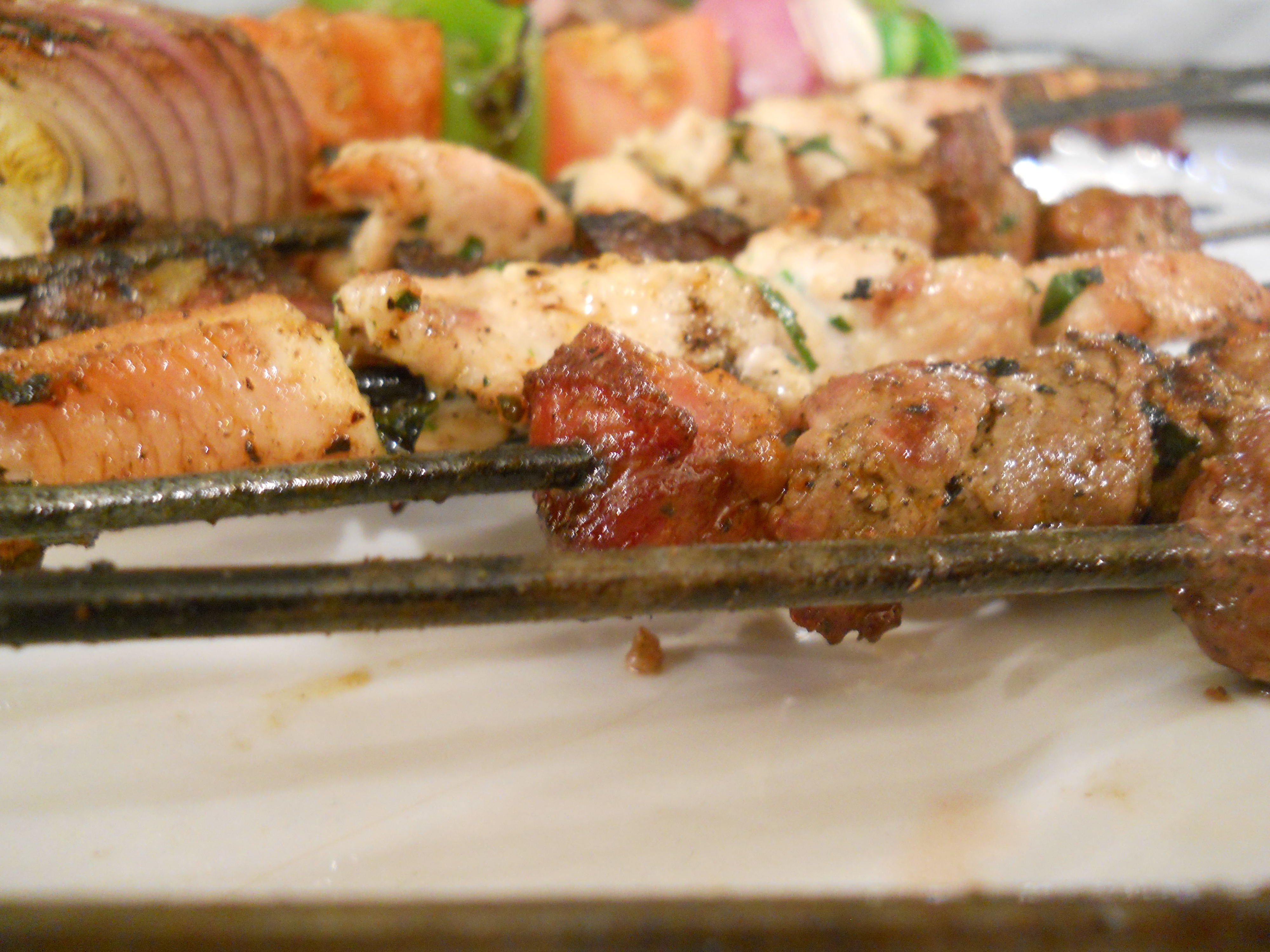
This was easily my favourite day in the city, so much relaxation followed by delicious food in a real party atmosphere.
Escaping Marrakech with a Day Trip to Cascades d’Ouzoud
22 March 2012
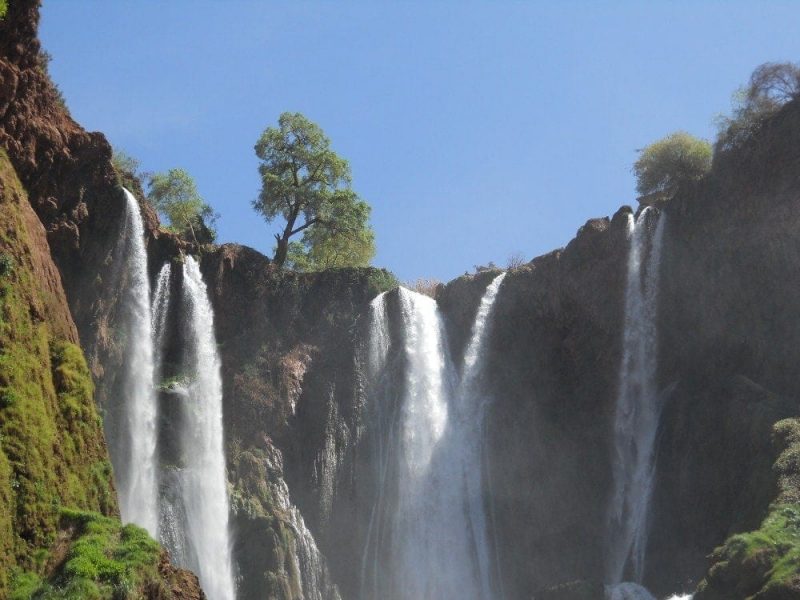
The Ouzoud Falls are located in the Azilal district in the Atlas mountains around 150km northeast of Marrakech.
These beautiful falls are over 120m high, with several jets of water merging into one larger stream towards the base. At the bottom, rainbows can almost constantly be seen playing in the mist. Ouzoud is a berber name referring to the many nearby olive trees.
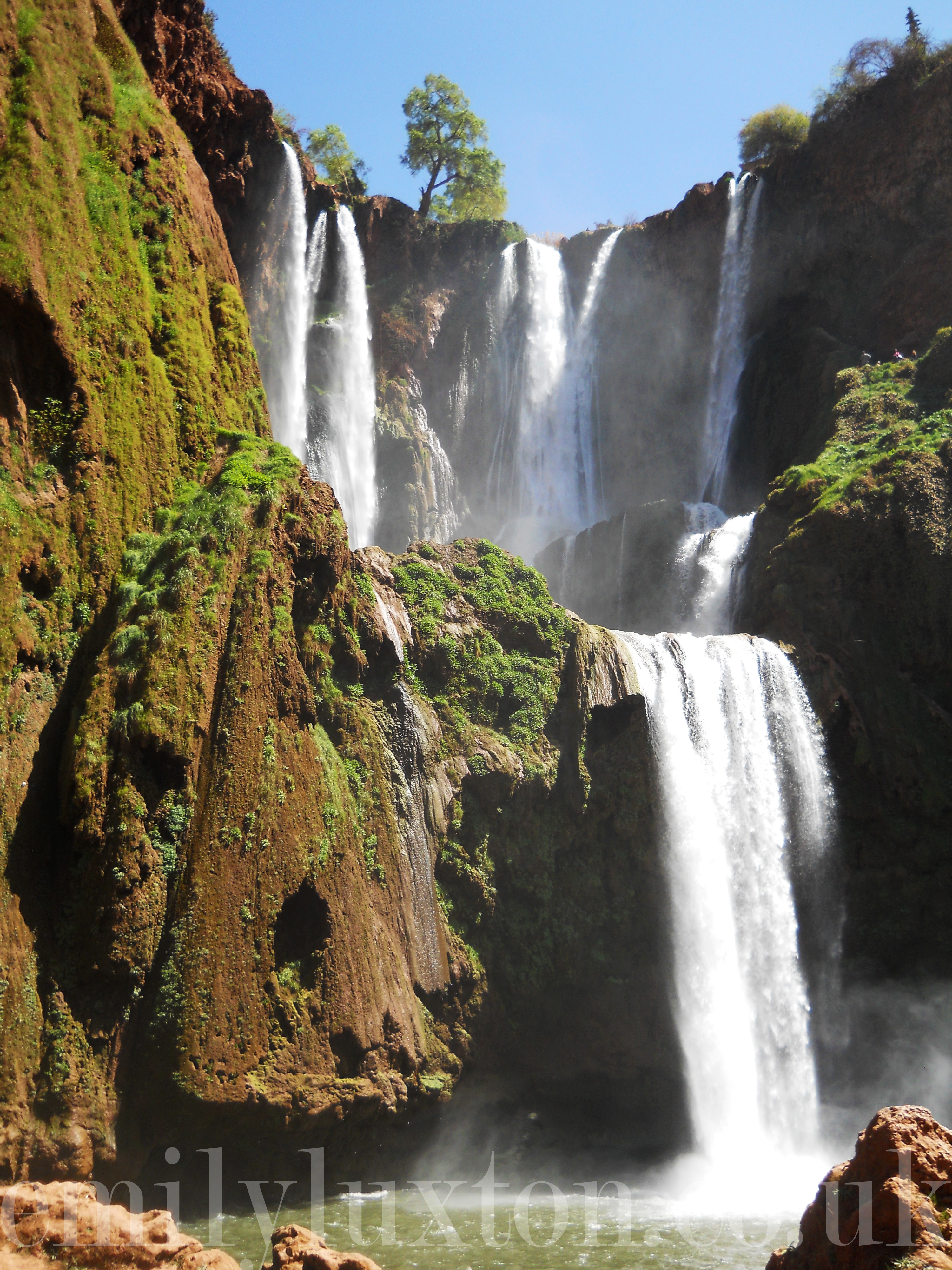
Day Trip to Ouzoud Falls
When it comes to getting out of Marrakech, there are a host of excursions and day trips to choose from. Morocco is an enormous country with a rich and diverse topography, so it seems a shame to stay in just one place.
Everywhere we looked in Marrakech, someone was offering excursions, and not all of these looked too genuine. I was pretty glad we booked ours in advance, through Expedia, so that I knew the company, Sahara Tours International, could be trusted. I also get the impression that, surprisingly, we got a cheaper deal by booking in advance, so in general I’d recommend it.
We had a fairly early start, meeting the minibus at 7:30am at the Djemma El Fna. Our small group was made up of nine British tourists, plus the driver and Youssef, our guide. It was nice to spend a bit of time with other English speakers, and swap stories about our experiences so far. Youssef was very friendly and spoke perfect English – far better than anyone else we met in Morocco – and gave us a very informative tour as we left Marrakech.
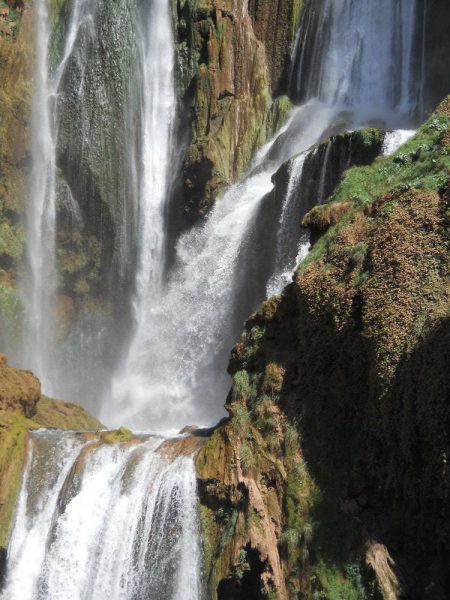
Climbing into the Atlas Mountains
We had a long drive – about 150km – with some amazing views. At first, there were long, flat plains on either side between two rows of distant mountains; on the left low and earthy, on the right higher, more jagged and snow-capped (these forming the High Atlas mountain range). We passed huge expanses of farmland, which was on the whole still being farmed in traditional ways.
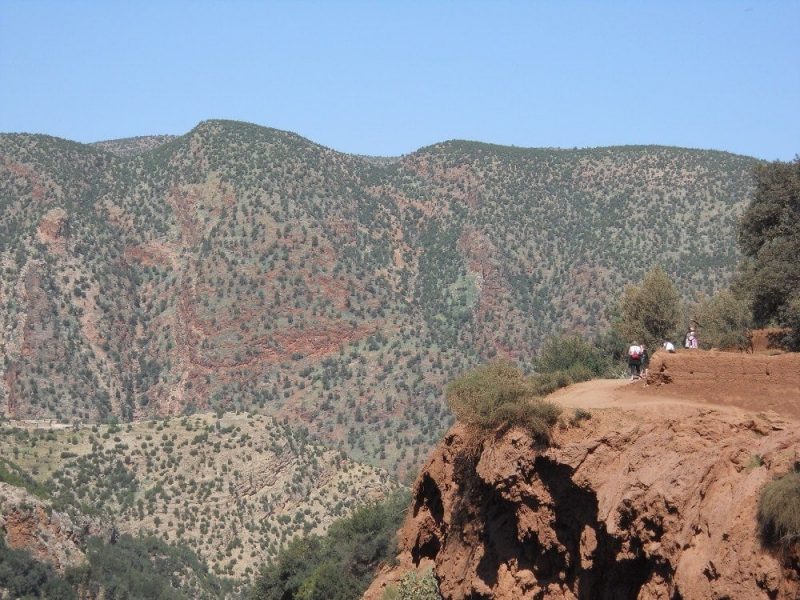
Boys rode on donkeys loaded either side with huge wicker baskets stuffed with hay. Men in wide-brimmed straw hats tied under the chin worked the land with hoes, or bent right over weeding or harvesting so that they disappeared into the long grass. I never saw any machinery in action, although in one field I watched a man tilling the land by hand directly opposite a showroom of shiny new tractors.
As we began to climb higher into the mountains, the landscape around us changed. Winding mountain roads were bordered on the one side by sheer drops, on the other by steep cliffs of red clay or slopes covered in dark green forest. All the while the snowy peaks of the High Atlas loomed like blue ghosts in the background.
The Walk to Ouzoud Falls
Around three hours after leaving Marrakech we arrived at a small cluster of shops and riads which have sprung up at the start of the trail to the Ouzoud Falls.
We walked down a few steps, round a corner and suddenly there were the falls, much bigger and more thunderous than I’d expected; several jets of water ploughing their frothy way over the edge and down over one hundred and twenty meters.
The stark edge and sheer drop made my knees weak, but the view was incredible. Clear blue skies, rolling green and brown hills, and glittering white water tumbling down in overlapping streams. I stood still, enjoying the hot sun and the light relief of the breeze on my skin, and stared out at this scene of stunning natural beauty, listening to the gentle chirruping of birds and the whisper of trees in the wind.
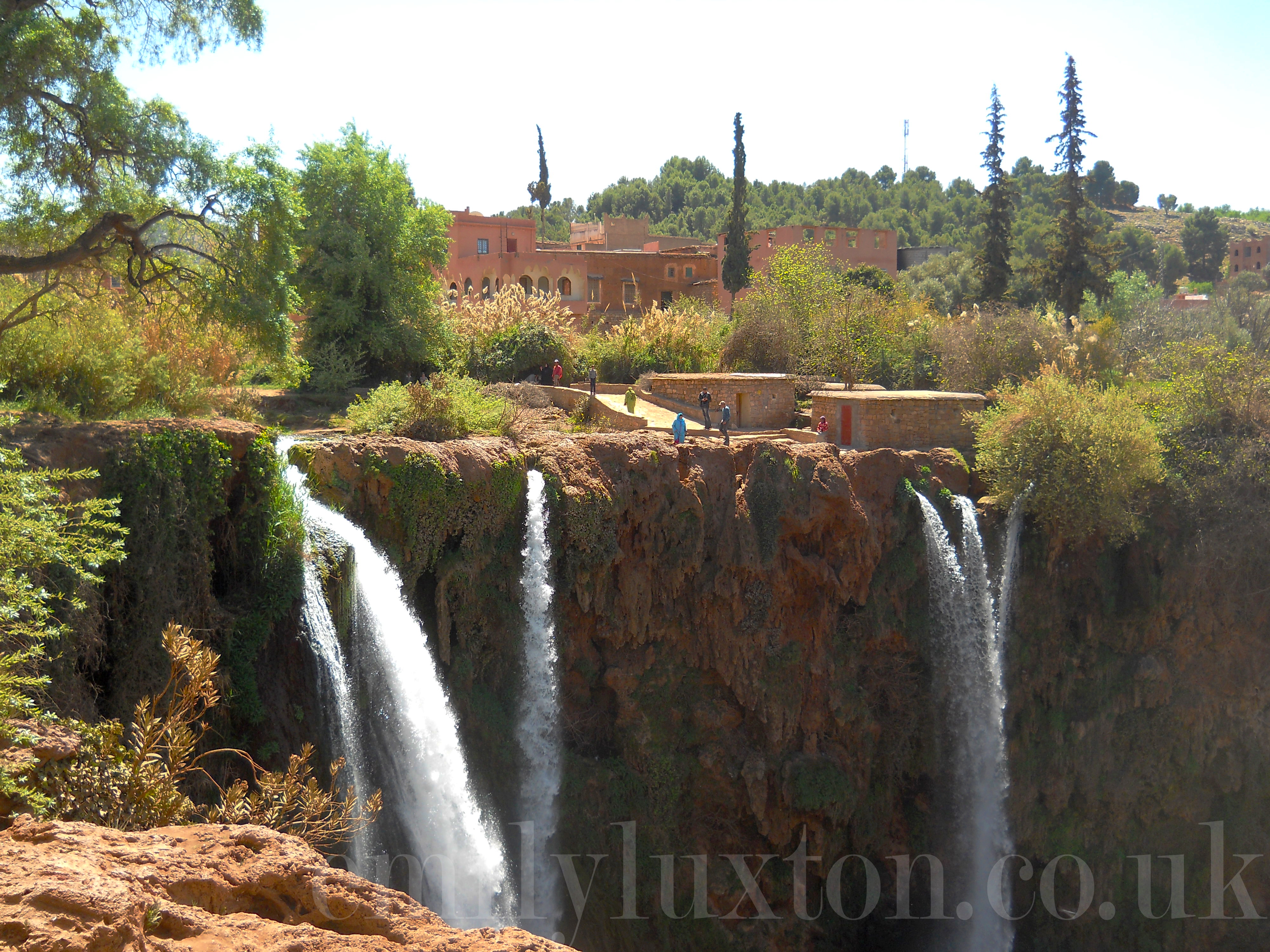
We walked back the way we’d come to go upriver a bit and cross a bridge, stopping in the shade for a lesson in irrigation, with Youssef drifting frequently into often obscure tangents.
He interwove his speech with details of how land and property is split between a family once the father dies – with one eighth going to the wife and one son receiving a share equal to two daughters – or about the rules for taking second wives.
Visiting an Argan Oil Collective
Youssef showed us a female Argan Oil co-operative to see how the oil is made. The women crack open the argan seeds using a rock, then grind the almonds in a manually powered stone mill.
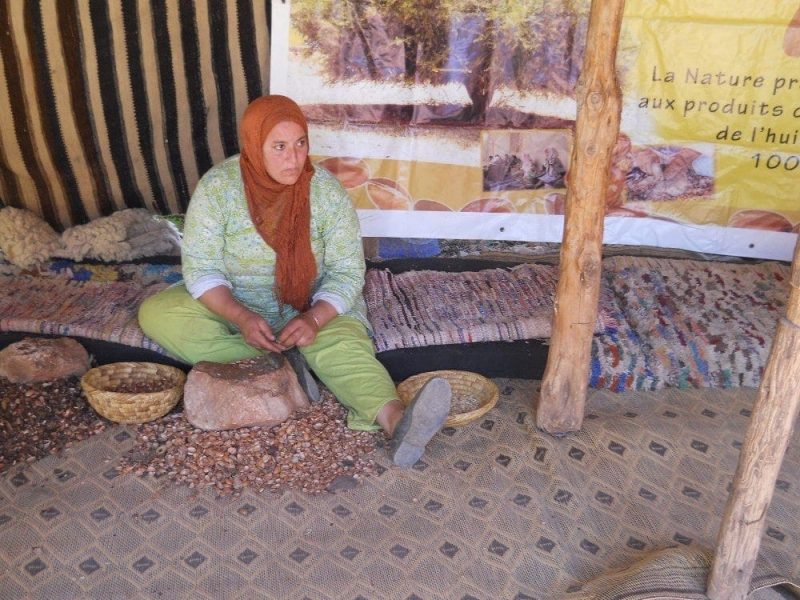
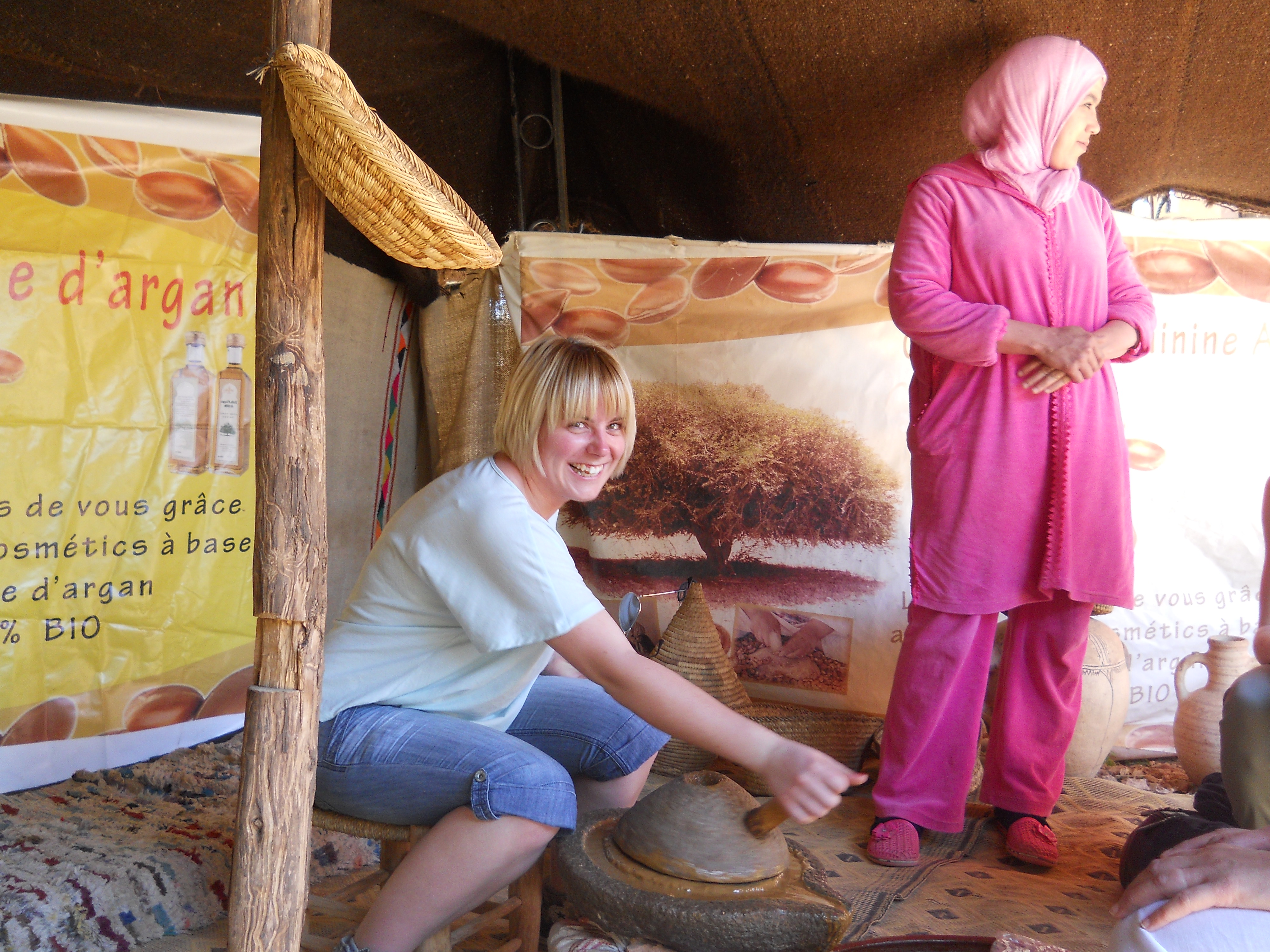
I had a go on this, it’s extremely tough work and my arm ached after a few minutes. The whole process is incredibly long and laborious; it takes around thirty kilograms of argan fruit and eight hours of hard work to produce one litre of pure oil.
After the demonstration, we tasted some of the oil with bread. My favourite was a sticky, crunchy paste made with argan oil, honey and almonds, which tasted like peanut butter. I also bought some argan oil lip balm for Dh60, which worked wonders for my sunburnt lips.
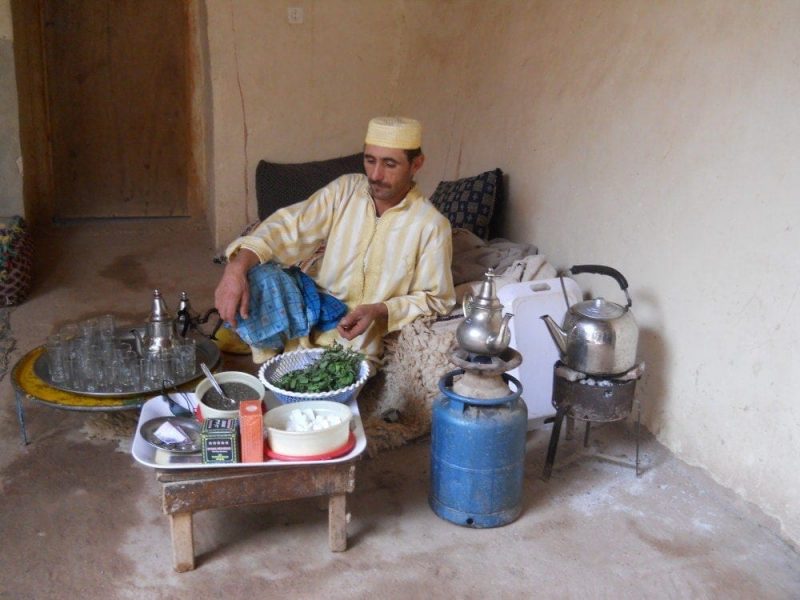
We also went inside a traditional Berber house. The temperature outside was around thirty degrees but inside the house, it was dark and very cool. This is down to the hugely thick clay walls of the house, which apparently also keep the interior warm during the very cold winters.
The layout was similar to a riad but with no garden in the small central courtyard: Youssef explained that the presence of a garden in a riad is to bring nature into the city, but that this isn’t needed in houses in the country which are surrounded by natural beauty. That is especially true of the houses here!
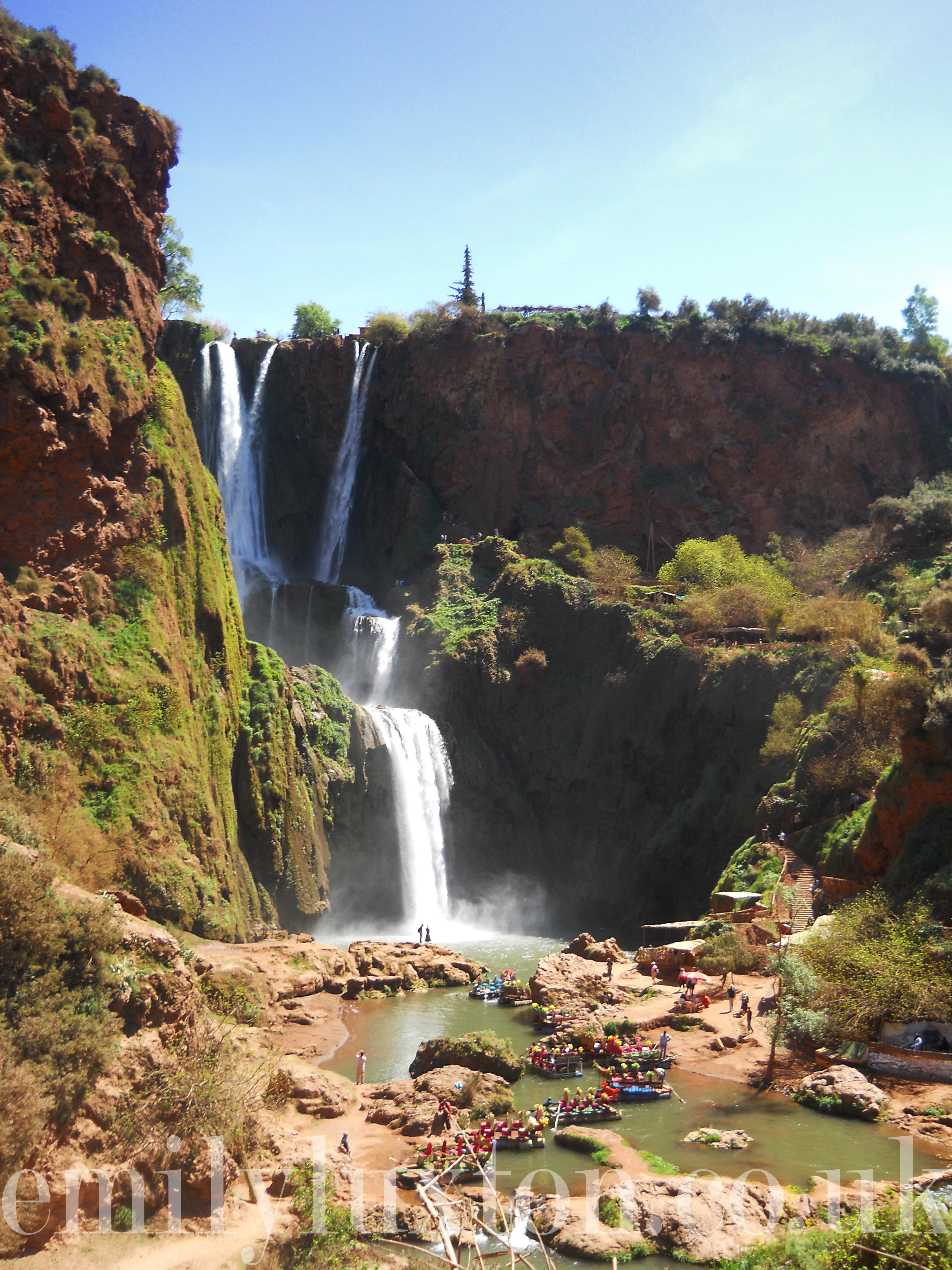
Down to Ouzoud Falls
We walked along the river where frogs, basking in the muddy shallows, struck up a loud chorus of ribbiting. We were then able to view the falls from the other side, definitely an even better view than before. The beautiful mountain scenery has simply been hacked in two, leaving a huge gorge with sparsely forested red slopes. The roar of the churning water drowned out all other sounds.
After that, we took a long walk down a twisting path of dried mud, which was fortunately shaded by many trees. It was very dusty and slippery, and every few minutes from somewhere in the front we heard Youssef call back “mind your feet”.
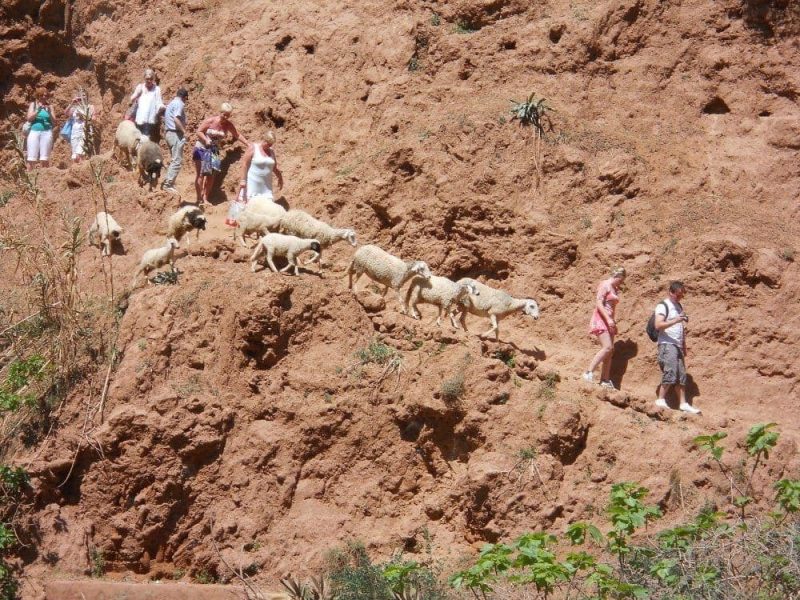
At the bottom, more shops and cafes have sprung up along the river in the shade of the Cliffside. Lots of boats – rafts of plastic barrels and wooden seats with extravagant floral decorations – gathered at the shore to take tourists to the very bottom of the falls.
We didn’t bother with a ride as you can get close enough on foot. We crossed the river again over stepping stones and some fairly rickety improvised bridges, stopping repeatedly to take photos. Behind us, a herd of sheep had come down to the river by the same path we had, and were leaping effortlessly over rocks and around other tourists to get down to the shore.
Lunch with a View
We stopped for lunch about halfway up the opposite side of the gorge. The ‘café’ was more of a pit stop where several tagines smoked away on a huge grill by the side of the path, and a small patio with some shabby plastic garden furniture faced the falls directly.
The light wind brought the occasional misty spray of water to our faces, and from our fantastic vantage point, we could see the pale rainbows which are an ever-present fixture at the bottom of the falls.
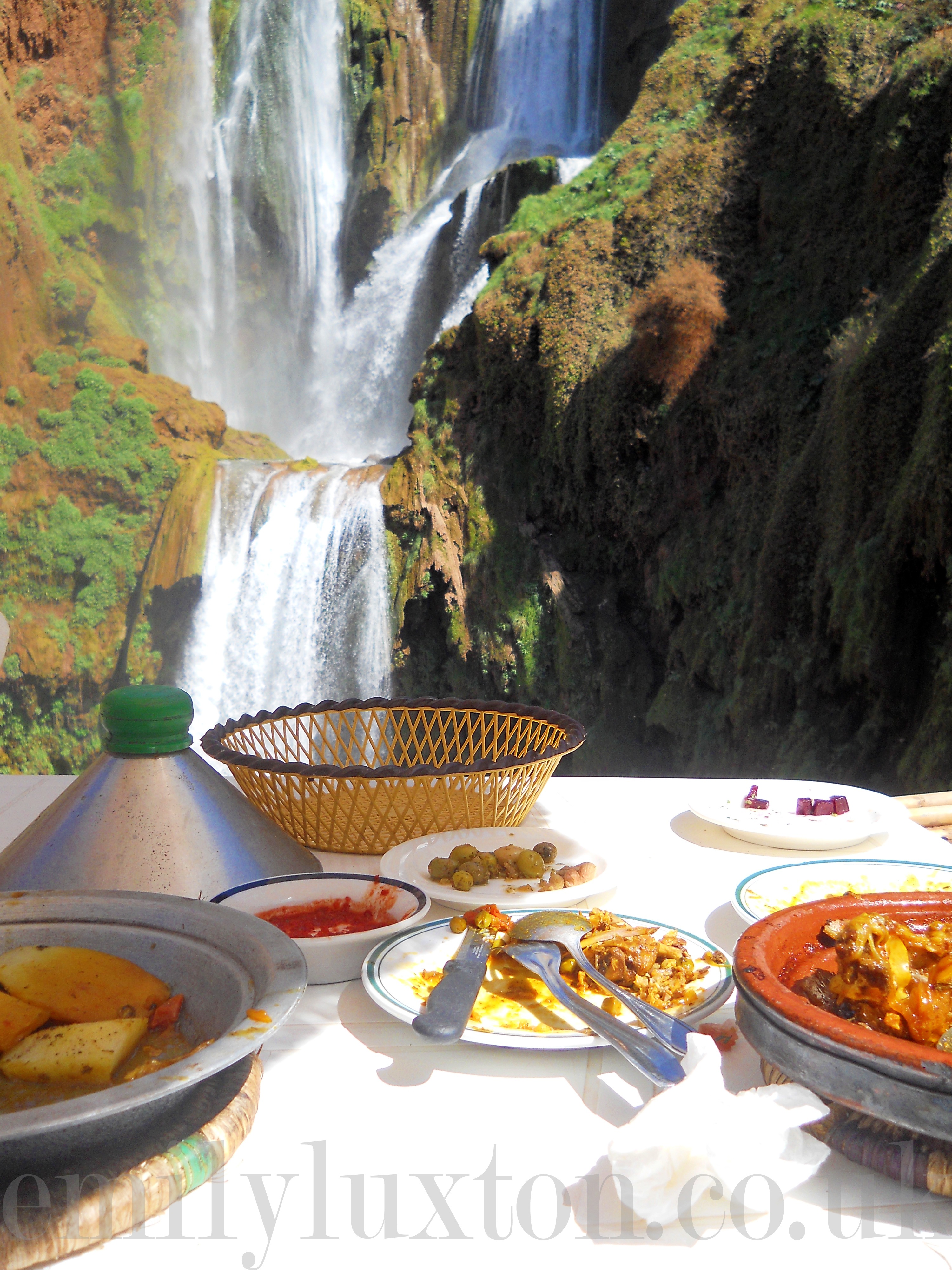
The friendly owner brought us bottled water, plates of small salads, chicken tagine with carrots, potatoes and onions, oranges for dessert and mint tea, all for Dh110 each.
Although it was slightly strange to be eating such hot, hearty meals in the baking sun, the flavours of the tagine were somehow summery, with the sweetest and softest carrots I’ve ever tasted. This was the nicest place I’ve ever eaten lunch, the food was delicious, the view was stunning, and the constant rushing sound of the water seemed to cool my senses.
As we climbed the remaining steps – difficult now with our full bellies- we encountered a family of Barbary Apes. Many were just sitting in the shade of the trees, but the younger ones were racing about and play fighting, and a few ran up and patted my bum, looking for food. They seemed very used to human company and were so cute to watch as they tumbled about together.
In spite of the long, uncomfortable drive home, this was a fantastic trip with a friendly and professional tour company. This was definitely one of the highlights of my time in Morocco. I’d very strongly recommend a day trip away from Marrakech to anyone visiting, as the city can be a bit overwhelming and a trip to the great outdoors can be so invigorating. I’m also very happy to recommend Sahara Tours International, who organised a brilliant tour and were a pleasure to deal with.
Tips for Visting Ouzoud Falls
Check the weather for Azilal, the surrounding region of the Ouzoud Falls, before leaving so you have an idea of what to wear. This area is not high up in the mountains, so isn’t cold. When we went in March the temperature was around thirty degrees, very clear and very hot.
Take lots of suncream, a hat, a bottle of water, and a light jacket if there is a forecast for rain. Try not to take too much else with you as you don’t want to be carrying a big bag around in the heat. I believe that in summer you can swim in the river, so take swimwear if you want to.
You won’t need much money with you, just enough to cover lunch. There are souvenirs on offer from shops along the river’s edge and also the shop at the argan oil co-operative we stopped at had a lot of really nice products. If you want to buy argan oil in Morocco, this is a better place than the souqs as you ensure the producers get paid directly.
Wear trainers. This isn’t a serious trek, so you don’t need fancy footwear, but some steep slopes – which do get a little muddy – are involved so you’ll wants shoes with grip and no flip-flops. I wore an old pair of converse (threw them away afterwards to save suitcase space!) but I think I would have been fine in a pair of those cheap plimsoll-type pumps.
Cover up. The villagers around the Ouzoud falls are used to tourists, but it’s still respectful to keep your arms and knees covered if you’re a girl. I wore long shorts and a loose cotton t-shirt and didn’t feel at all conspicuous, plus my shoulders were protected from the sun.
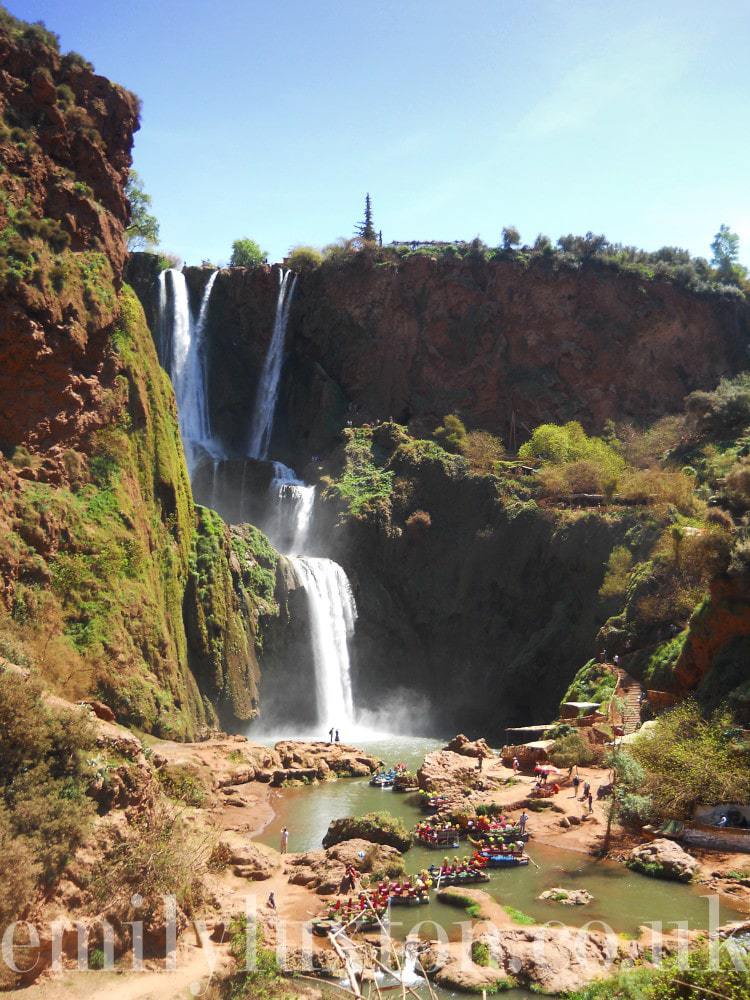
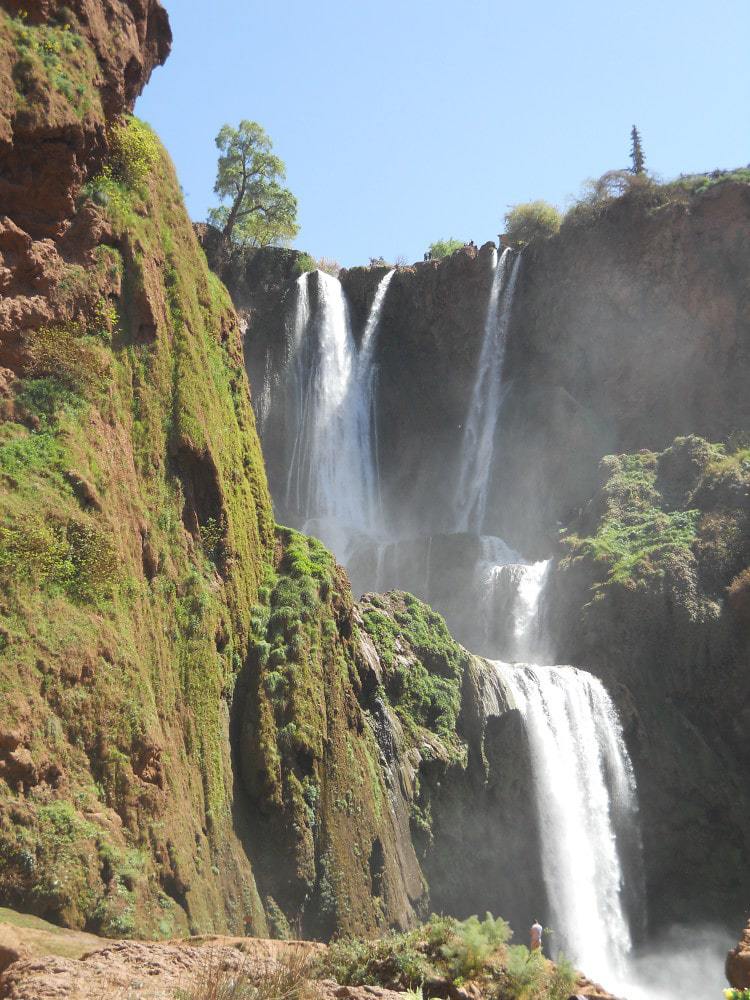
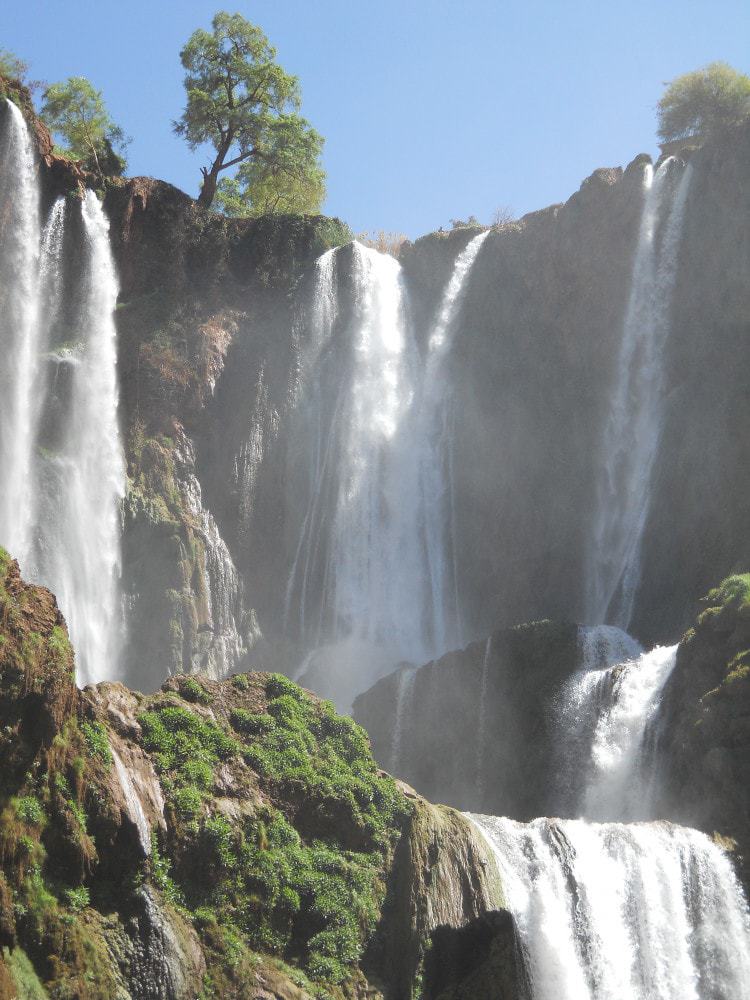
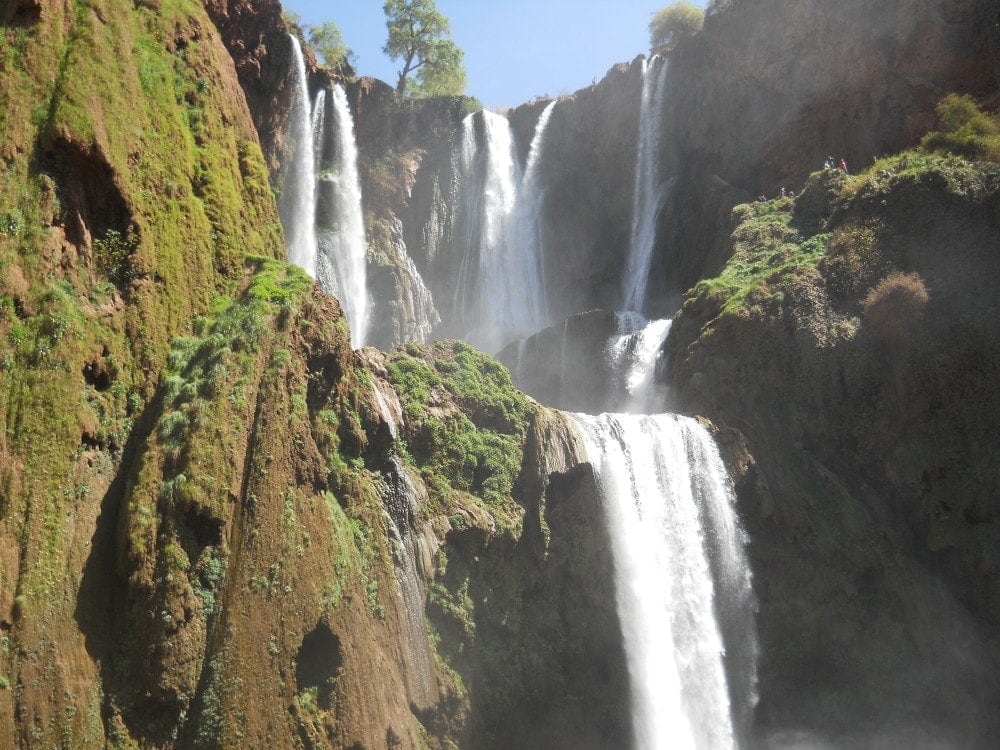
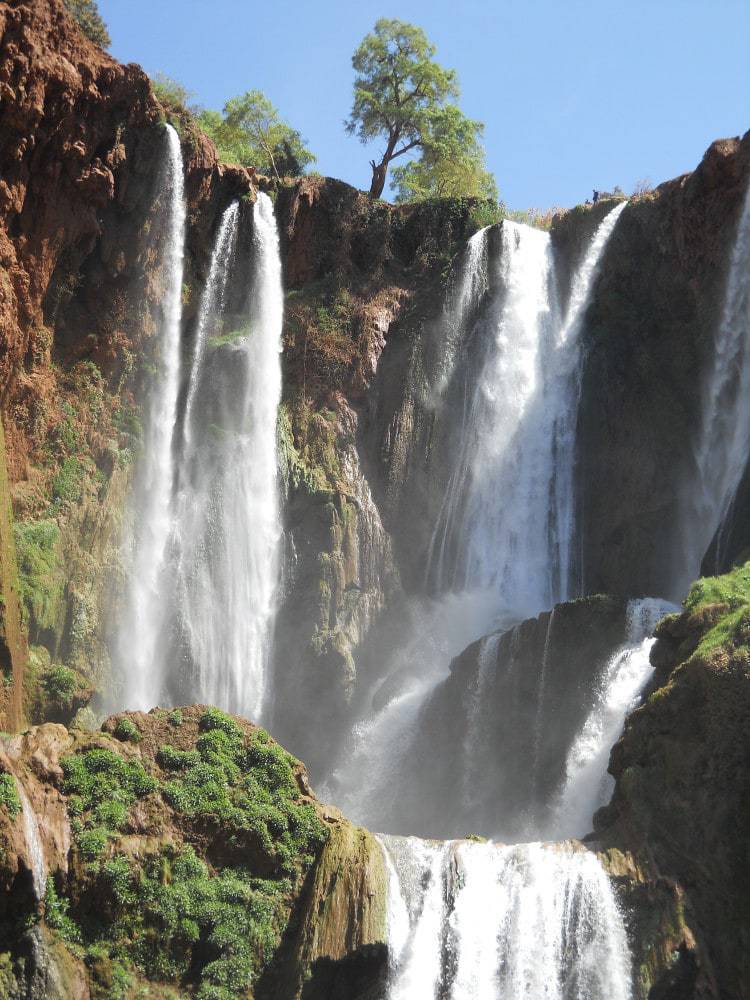
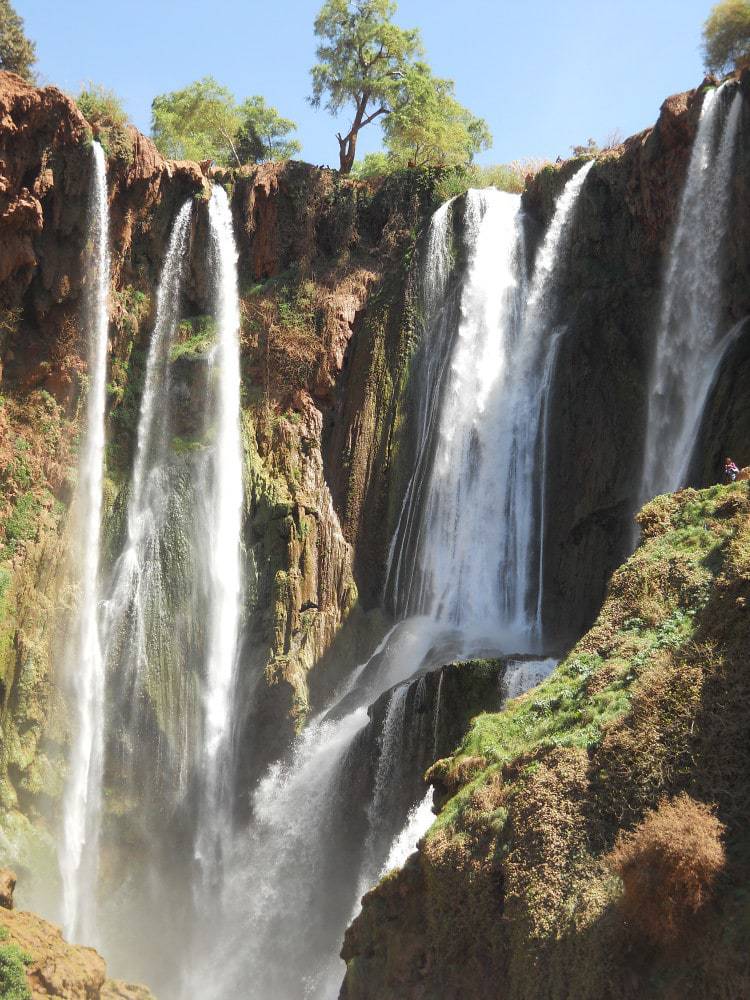
Last Day in Marrakech
23 March 2012
Ali Ben Youssef Medersa, re-visiting the souqs, and Jardins Harti
Our last day in Marrakech was cooler and a little overcast, which was welcome as we were still feeling a little overheated from the day before (see my previous post about the Cascades d’Ouzoud). We left our riad around half-eleven and headed straight down the Rue el Gza to the souqs, dodging donkeys, carts, mopeds, sheep and whatever else decided to use the narrow, covered road as a freeway. Having found our bearings, we were more confident than the day before and found that the souqs are far less stressful when you’re not trying to get somewhere specific.
By accident, we came across the Ali Ben Youssef Medersa (I don’t think we’d ever have found it if we’d been trying). This Islamic college, no longer in use, is the largest of its kind in Morocco and a fascinating historical site. We paid Dh50 each for entry and had a look around. Built in the fourteenth century, the religious school has survived the years incredibly well. Inside are narrow white-washed corridors with tiled floors, and panelling in a heavy, dark wood. The interior is cool and dimly lit, with still, stifled air that had the historic smell found in museums and churches. We poked our heads into the dormitories and shuddered at the thought of seven people crammed into the tiny, cell-like rooms, with bare walls and floors, and often no window. Some had a ladder build into the wall which led to an overhead sleeping area in the ceiling – just a few feet high – which was utterly black. I read that up to nine hundred students would have shared the one hundred and thirty rooms and a single bathroom; I tried to picture them bent quietly over the Koran by candlelight, and wondered what they would make of today’s tourists posing for funny photos in their cells.
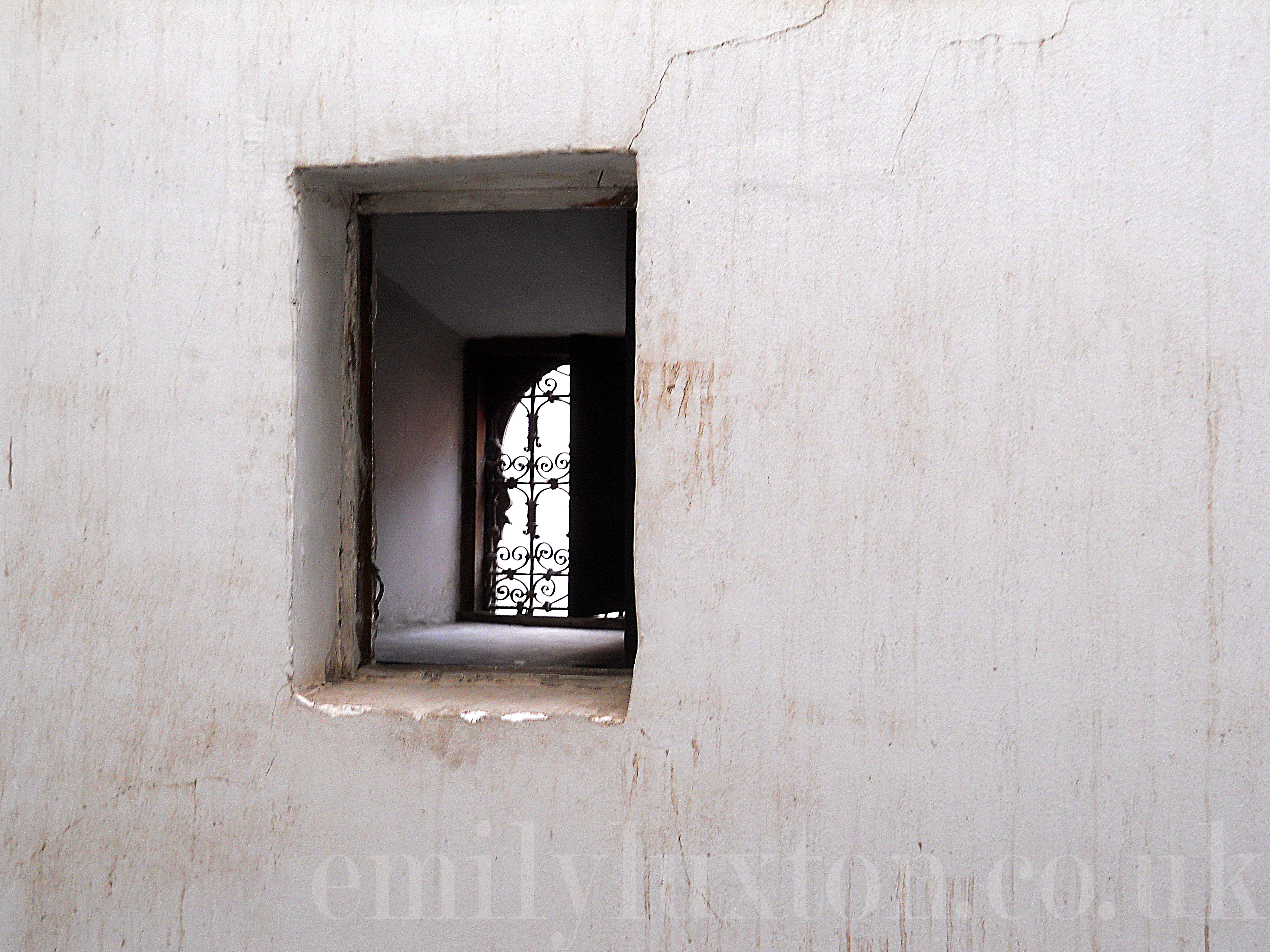
The outdoor courtyard is the most impressive aspect of the Medersa, a large, clear space with a rectangular central pool. The surrounding walls, in a pale terracotta shade, are richly carved with geometric patterns and Arabic inscriptions, with pink marble pillars and intricately carved cedar panelling around the top. Turquoise mosaic tiling circles the walls around the bottom, matching the blue-greens of the pool and creating a lovely, cooling effect.
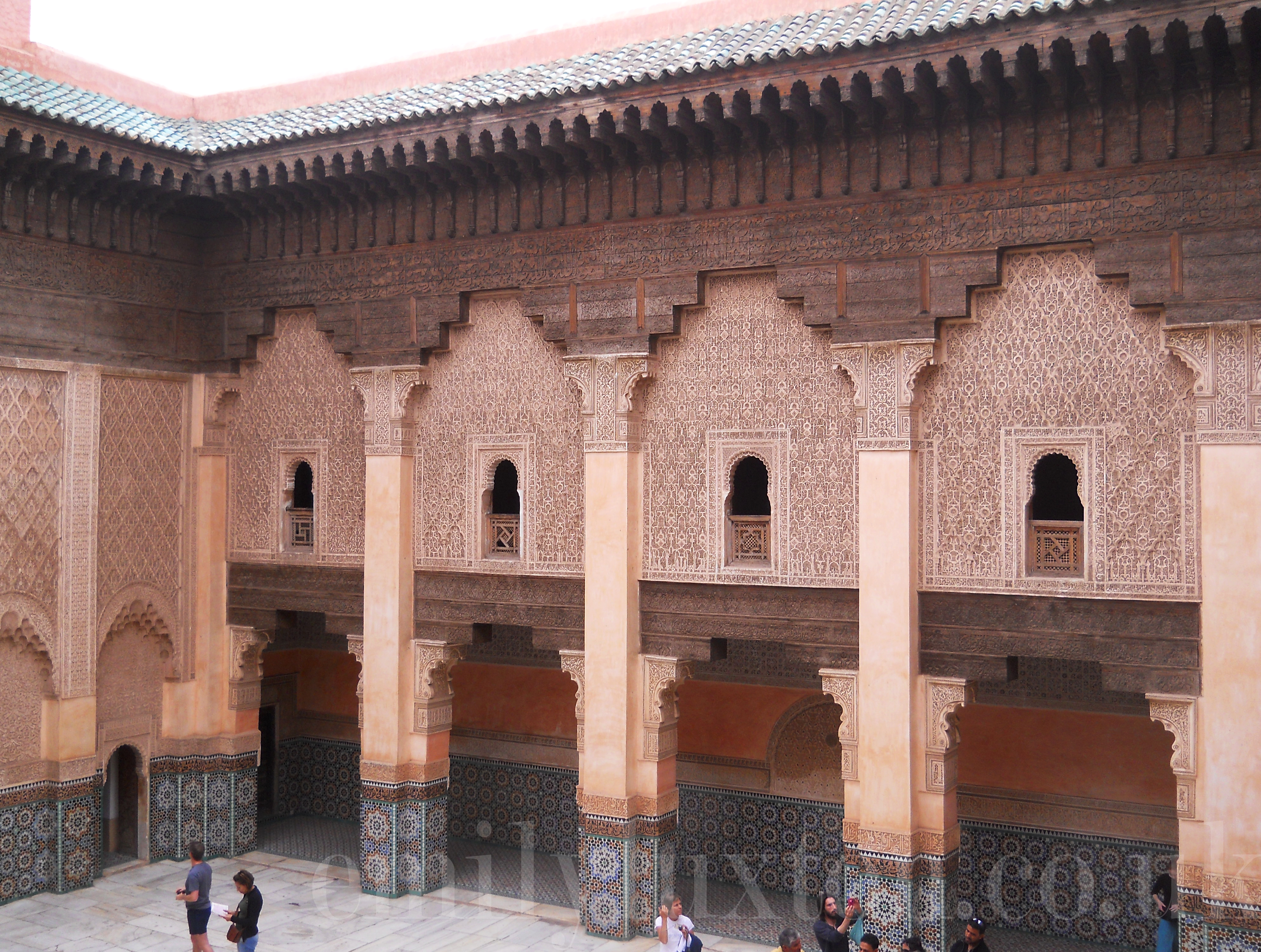
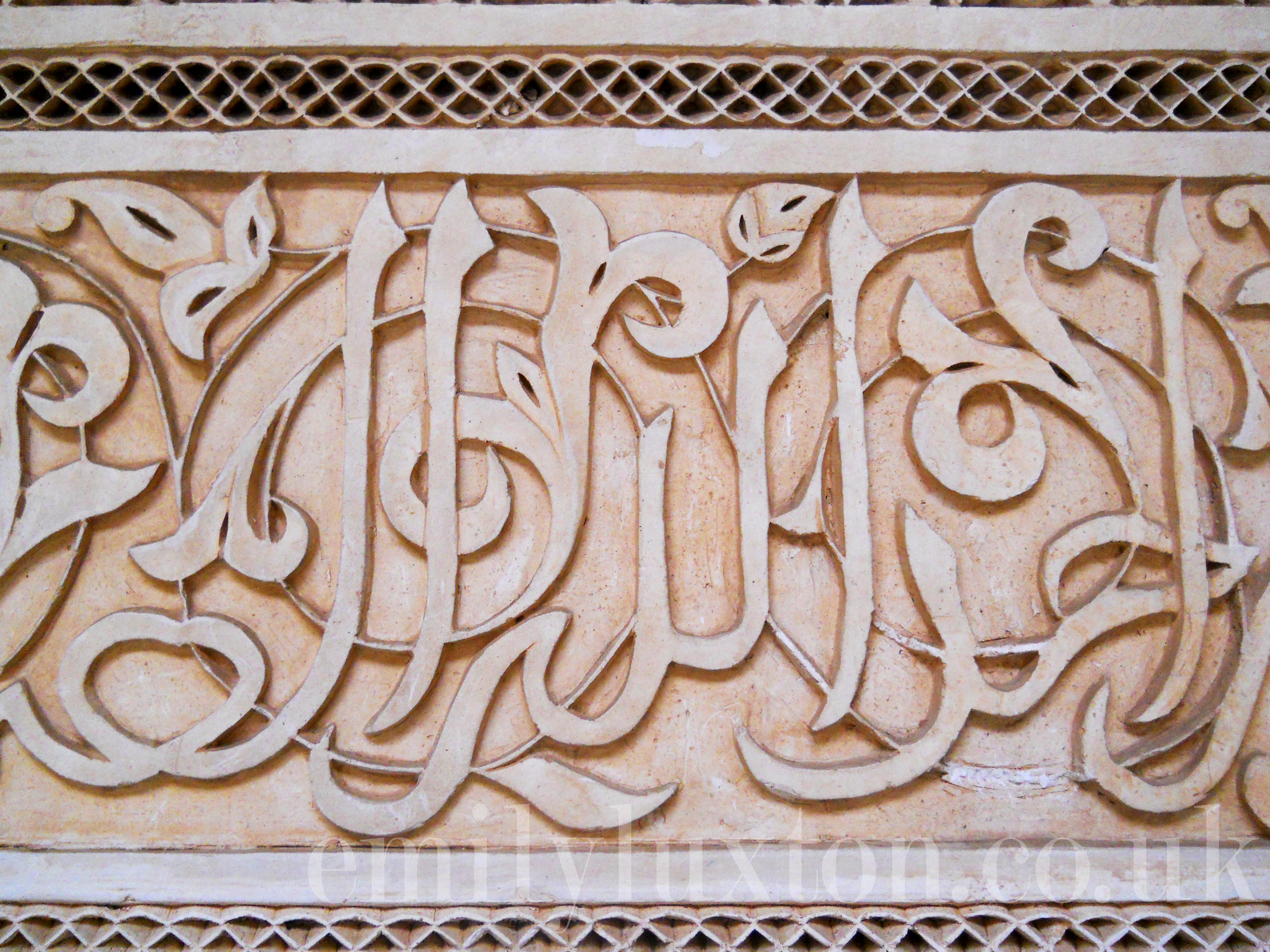
After leaving we walked slowly around the souqs, looking for souvenirs and gifts. I bought some amber – a sweet-smelling perfume sold in crumbly soap-like bars – from an apothecary which was lined from floor to ceiling on three walls with huge glass jars. The store owner switched on a light behind the jars of dye and sent a dazzling display of colour across the dusty shop floor; vibrant magentas, yellows, and indigos which come as a surprise in the darkness of the souqs. The smells of the spices were amazing; so rich and warm that my mouth watered for tagine.
We wandered into an Aladdin’s cave of wonders, where piles of silver tea sets, decorated treasure chests, sparkling bejewelled jewellery boxes and hookah pipes created a genuine maze in of the shops interior. Dazling stained glass and carved bronze lanterns bobbed overhead, meaning that we had to stoop to move around. Sam haggled relentlessly for a shisha pipe, getting the price down to Dh450 from Dh900.
Emerging into the clear space of the Djemma el Fna, I felt that we were finally on top of Marrakech, having fully mastered the arts of haggling, navigating the souqs, and keeping hold of our money in the face of opportunistic ‘guides’. Dodging musicians and henna ladies, we headed for the terrace of the Cafe Glacier on the far side; our favourite place to watch the comings and goings of the square without the frequent harassment. Over a cheap lunch of pizza and coke (Dh80 each) we watched a nearby group of snake charmers hustling, and tried to work out if the ape-handlers were cruel. Most of the apes seemed happy enough in spite of the chains and small rabbit-sized cages, and cuddled and played with their handlers affectionately.
In the afternoon, it rained for about an hour; thick, heavy drops which felt alien in the warm air. Ignoring the distant rumble of thunder we walked to the Jardins Harti in the Nouvelle Ville. After the stunning Marjorelle Gardens, these were a little disappointing. The Harti gardens are somewhat lacklustre and seem to contain more pathways and empty spaces than plants. Luckily, they were free, and I imagine that on a sunny day this might be a pleasant place for a walk.
With the darkening sky threatening another downpour, we called it a day a little early and jumped into a taxi back to the riad. All in all, a fairly gentle, easy-going final day in Marrakech.
Morocco – Day Six – The Sahara
24 – 27 March 2012
On Sunday morning we woke up late, still stiff from the day before and utterly disorientated. Visions of dirt tracks and narrow alleys in the darkness swam before my eyes from the night before. Wandering outside, we found the quiet courtyard of our hotel, brimming with rose bushes and smelling sweet under the already baking sun.
Breakfast – huge helpings of warm bread and jam, cakes and pancakes with honey – was served on the patio by the pool. The honey in Morocco is amazing; sweet and tangy with an after-taste of oranges, and goes splendidly with a glass of freshly squeezed orange juice. The pool, a streak of vivid blue between Hotel Mamouche’s painted yellow mud-and-straw walls, looked cool and inviting. We were the only two people on the patio, which was silent except for the trilling of small, darting birds from hidden nooks in the walls.
The view from our room – a few run-down houses made of straw-stuffed mud walls – gave no hint as to what our surroundings were. After breakfast we climbed up to the roof terrace to have a look around and get our bearings. The view that suddenly faced us was a big shock. In front of the hotel was a flat, dusty plain, littered with patches of black sand and otherwise utterly empty. Beyond that, completely within a tangible reach, stood the Erg Chebbi dunes. This wind-swept patch of the Sahara, one of two such dunes in Morocco, was by far closer than I’d ever expected. In a rippling line, wave upon wave of perfectly smooth orange hillocks, the dunes of the actual Sahara sprouted out of the horizon like a mirage. The sand was a pale yellow-orange colour, like sun-bleached red paint, and glowed as though lit from within.
It was an arresting sight, and it was a long time before we could put away our cameras and tear ourselves away from it. Seeing the Sahara has been on my bucket list for a long time, right up the top with things like the Northern Lights, or sunrise from the top of Mount Fuji. It made my head spin to be so near, so physically close to something which seems so completely far away and other worldly.
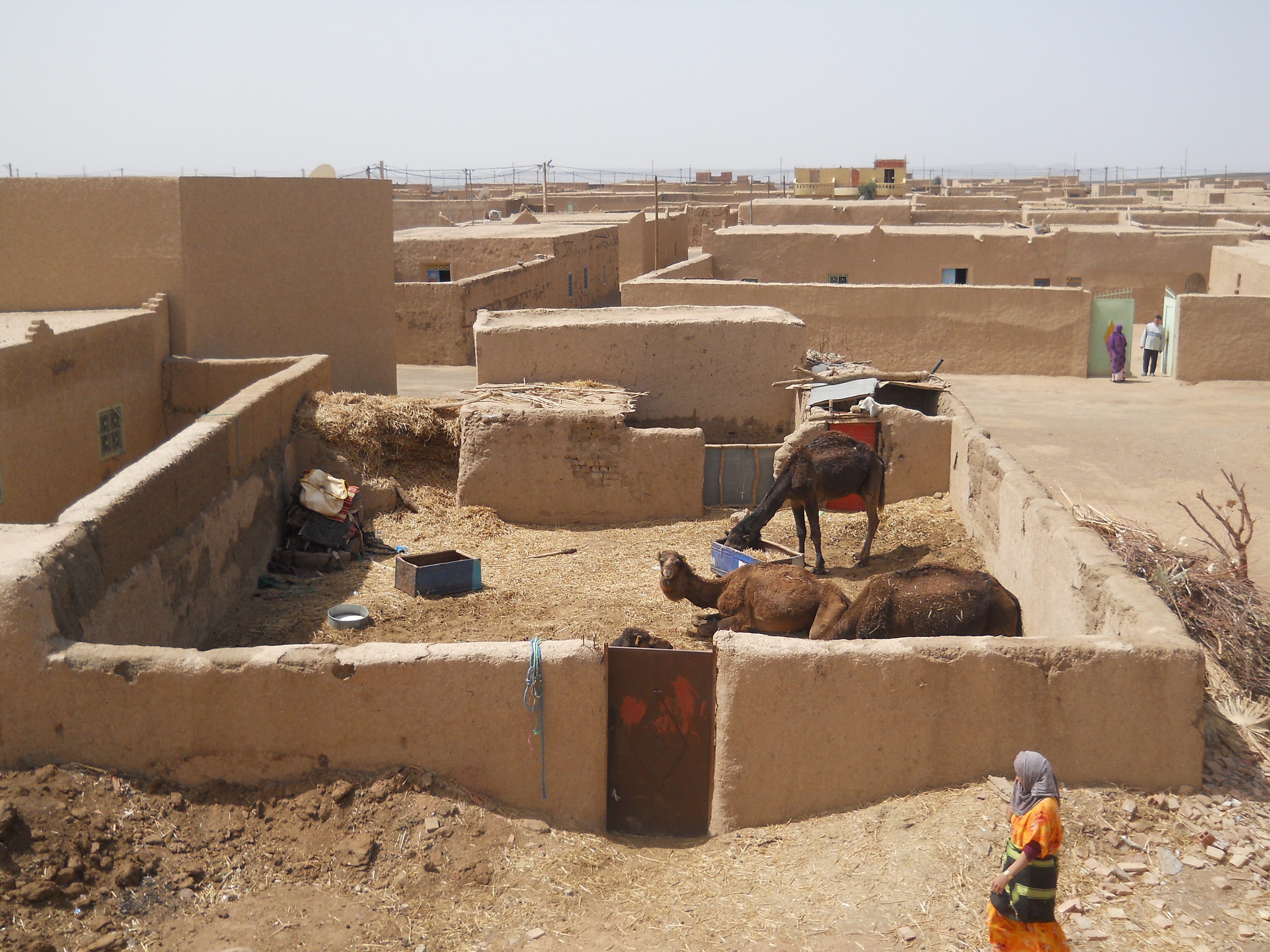
Hotel Mamouche is right on the edge of Hassilabied, a small village close to Merzouga. Mamouche and the handful of other hotels are the only buildings above one story, and everything is the same uniform shade of pinkish beige. The houses are all built in a similar style; a low, one storey square building with a flat roof, alongside a square courtyard of about the same size circled by walls the same size and colour as those of the house. This pattern repeats over and over, and viewed from above looks a little like a maze. In a lot of the courtyards, camels or sheep lazed alongside bundles of hay. Low brays hung in the silence of the town, and the air had the musty farmyard smell of dried mud and animal fur.
The pace of life in Hassilabied is a million miles from Marrakech. The village is nearly silent, and work is slow and leisurely. We watched a woman take a group of camels for a lazy walk around the house. A young girl stood outside breaking wood into sticks for a fire, tossing the smaller twigs aside aimlessly. In the distance, I heard the sound of a single moped, or quad bike, far too loud and fast for the sleepy afternoon.
The walk to the foot of the nearest dune took less than fifteen minutes. Along the way, a group of boys of around eight to ten, dressed in baggy rugby shirts and tatty jumpers (even though it was around thirty degrees) surrounded us. “Hello! English? How are you?” they called in a sign song, before holding out home-made woven bracelets in their grubby little fingers, offering their “best price” just like any Marrakeshi salesman. I sighed and said “no thank you” over and over, feeling a little sad. These children were the same age as my nephews and they were out working in the heat instead of in school, or playing.
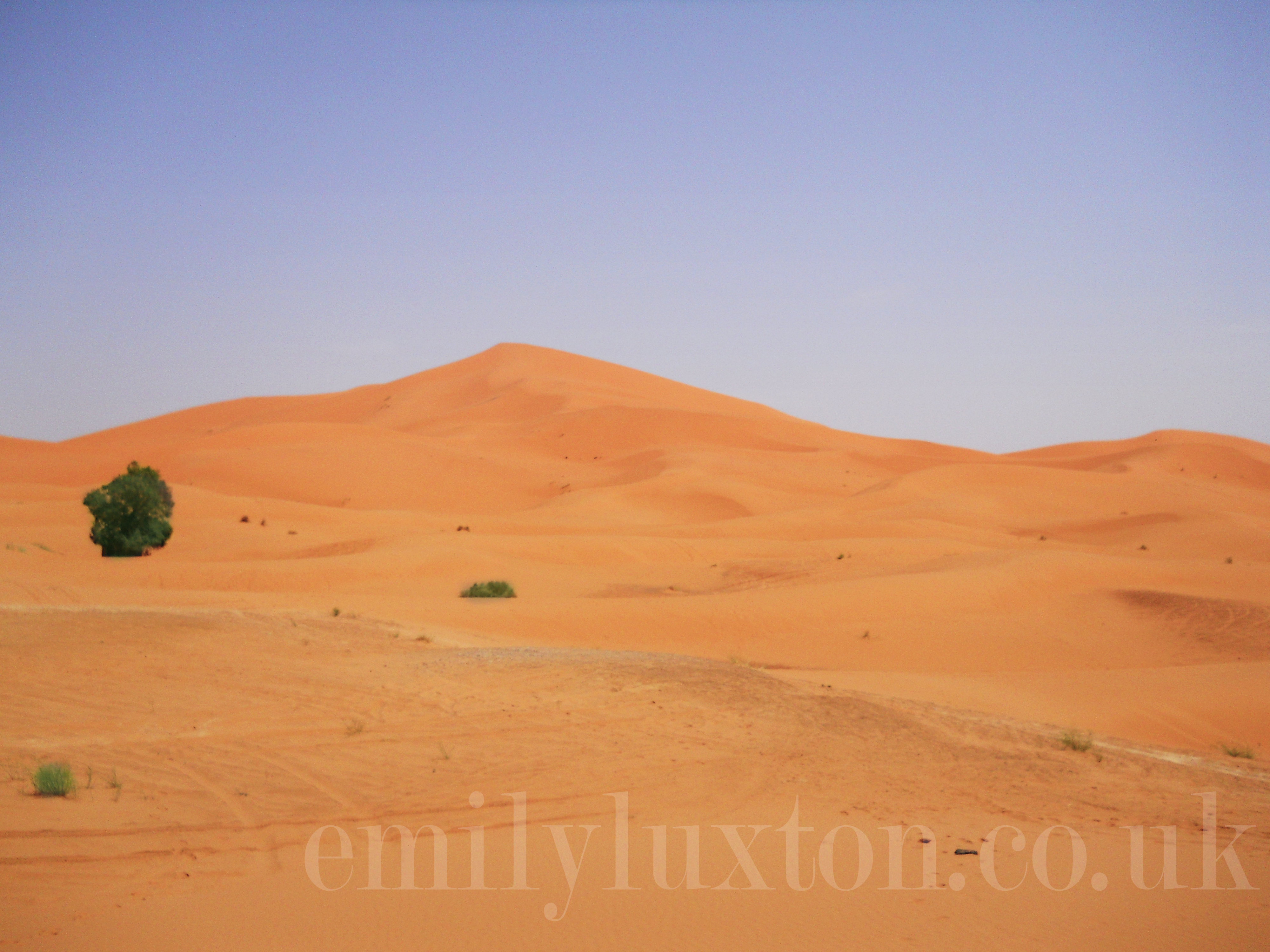
We clambered onto one of the lower hills at the foot of the dunes, our feet slipping and sinking in the soft, loose sand. Once on top, though, the sand was firm and spongy underfoot, like packed earth. The sun was baking and my skin felt scorched. Huge red ants scuttled about at our feet, and a few other bugs with pincers or spiked tails like a scorpion’s. I felt unable to stand still when the ground was so alive. Dung beetles, slow-moving and glowing a phosphorescent blue, ambled slowly along leaving a pattern of footprints in their wake, little woven flecks of dark shadows on the orange sand.
Sam and I looked at each other and grinned. We were stood on the edge of the Sahara desert! Gazing around at that rich, golden landscape under the creamy blue sky, I felt that I was further away from home than I’ve ever been before.
READ MORE: How to Plan a Desert Trip in Morocco
Camel Trek and Camping in Merzouga, Morocco
25 March 2012
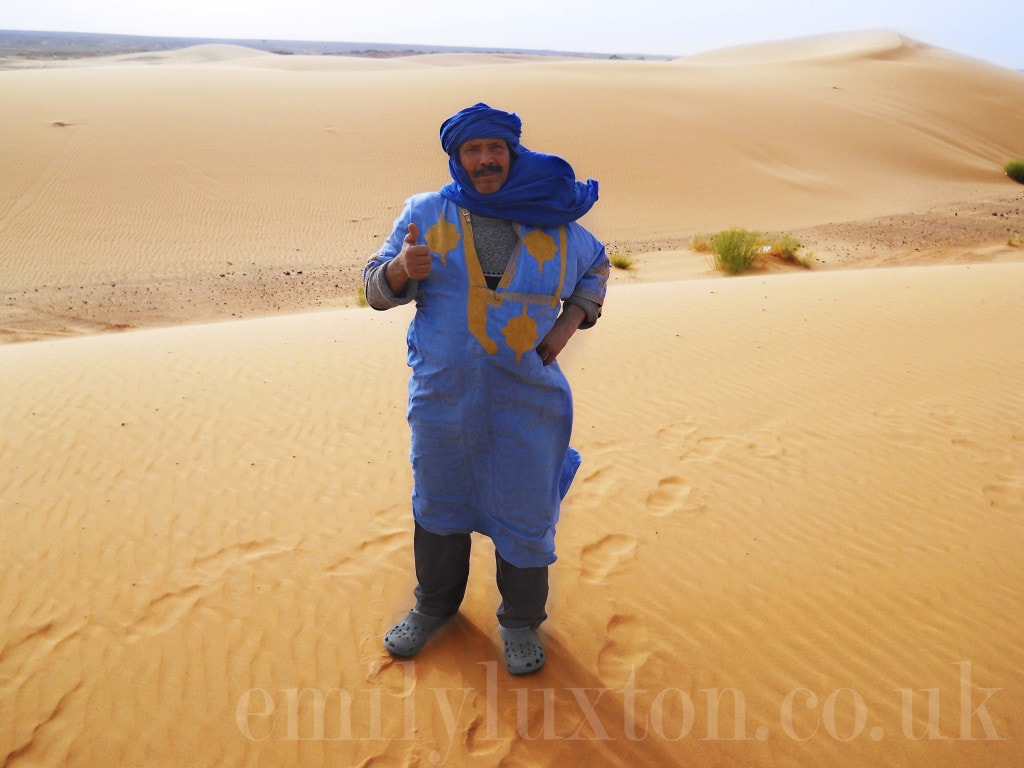
Hassan was an aging berber with a beaming smile under a bushy moustache, a couple of missing teeth and glinting black eyes. We met him at 4am, bleery eyed and blinking in the dim dawn light outside our hotel, and his cheeriness felt like an assult. He showed us how to mount the camels while they were sat down, our legs spread wide across their broad backs, loaded either side with packs.
When the camels – affectionately nicknamed Jimi Hendrix and Bob Marley by Hassan – stood up, the motion was alarmingly jerky. We formed a small caravan with one other guy, a Brazilian who spoke English with an American accent, and headed into the dunes. The camels had dirty, matted fur which was nearly bare in some places, stank of dried mud and urine, and kept doing disgusting sprout-y farts. Perhaps their lazy, stoner look inspired the nicknames; Jimi and Bob plodded along quite happily, their eyes half shut, in spite of what must have been a heavy load.
Camel Trekking in Merzouga
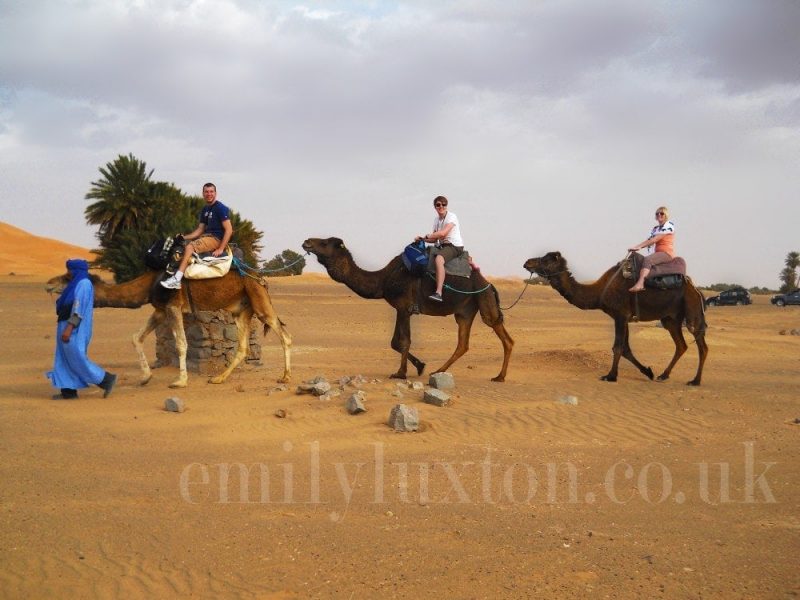
Camels are fairly uncomfortable, and moving along in single file is quite an anti-social way to travel. The scenery was beautiful though and the relative quiet meant I could look around at everything and was free to be a little introspective.
The wind picked up quite quickly as the sun began to sink down behind the clouds of the overcast sky. The breeze sent a smoky mist of sand swirling and eddying over the surface of every dune, like water vapour. Sometimes the sun would pick out the whirling clouds, light and golden against the deep, rusty orange of the dunes. At the peaks, the dust clouds poured off in a thick stream, before separating and disappearing against the grey-blue sky. As the wind got stronger, it sent stinging bites of sand against my bare skin, like pinpricks. I wished I’d brought two scarves so that I could cover my arms as well as having my face and neck protected by the scarf I’d wrapped around my head in a rough imitation of Hassan’s turban.
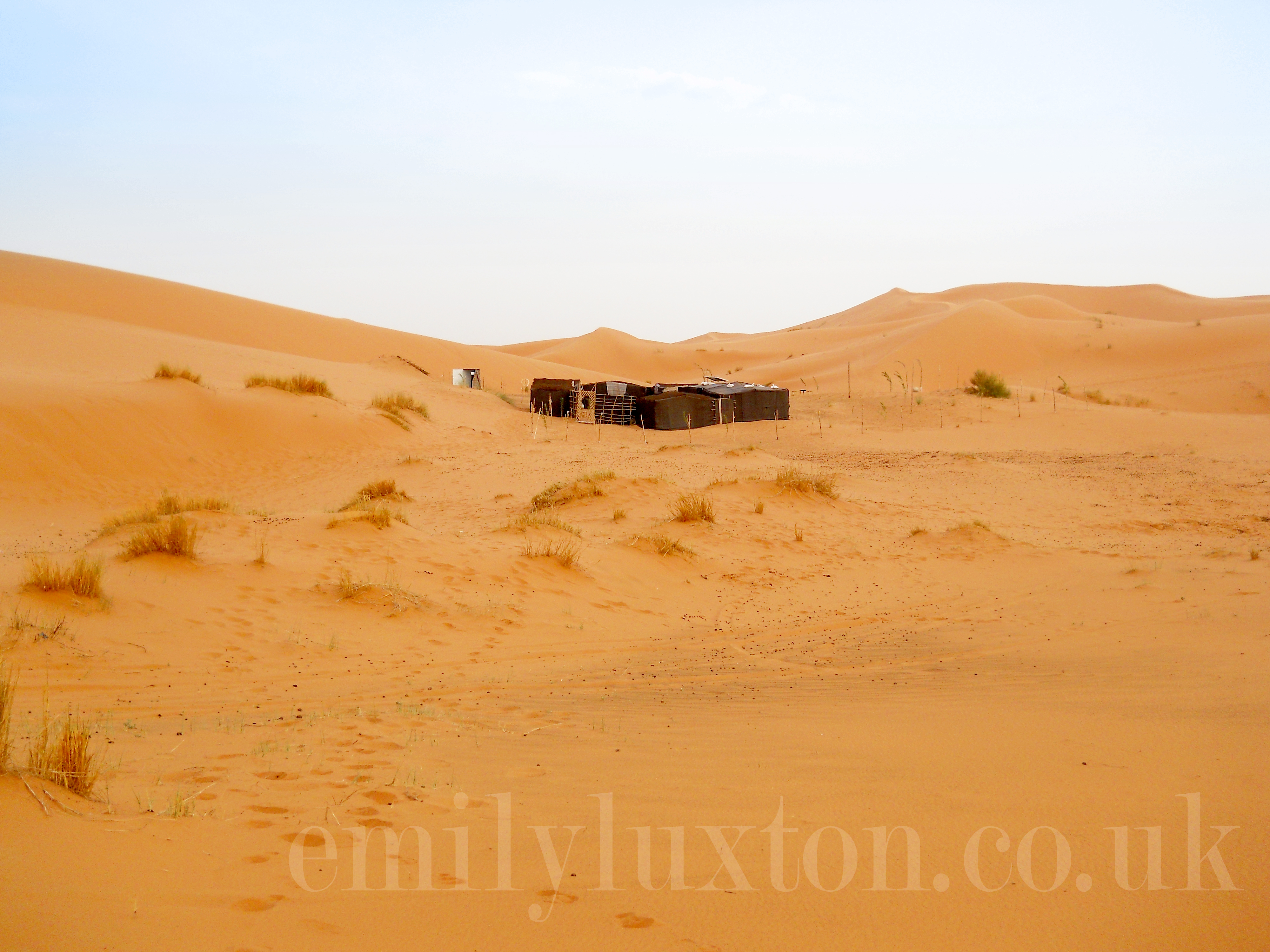
After an hour and a half of riding, my inner thighs were stiff and sore. We arrived at a berber camp; a square of rectangular tents made of a dark, felt-like material, protected from the wind by the high surrounding dunes. We climbed the nearest, on foot, to watch the sunset. The cloud cover was a little too thick, and it was very cold, so we came down again quite quickly and instead watched the stars come out from the base of the hill.
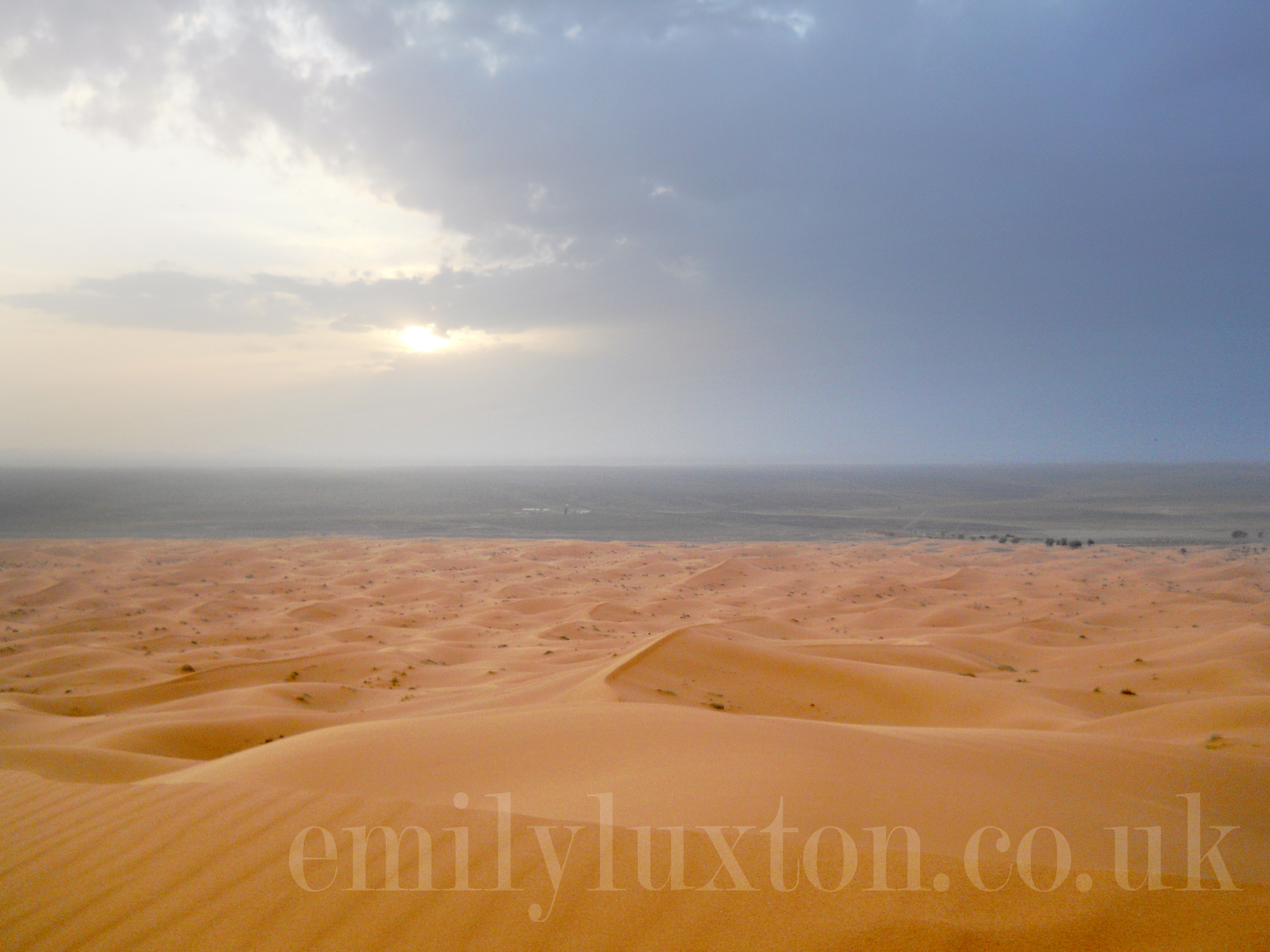
Desert Camping in Morocco
Inside the tents it was surprisingly warm; a thick mat made of woven plastic kept out the cold from the sand. An unseen assistant made us dinner in the ‘kitchen’. First came harrissa, a fiery tomato soup heavy with rice and cous cous. This was followed with “mouse tagine”, which I’m pretty certain was chicken with potatoes, carrots, tomatoes and courgettes. This was heartier than some of the other tagines we’d had, more like a winter stew, which was perfect for the cold of the desert and to refuel after the hard work of the ride.
Hassan played drums for us and put a tinny, scratched version of Bob Marley on his little stereo. We talked about the street entertainers in Marrakech; Hassan was full of stories about acts far weirder than any we’d seen. In patchy English, he described a man who stored a thick piece of wire in his nose, to pull it out and claim it as a nose hair, as well as another man whose act was to turn into a woman after eating a snake’s egg. Hassan was very funny and friendly, talking about his family, who live in the black desert behind the dunes (he pronounced it “doonas”). His favourite joke was to call camel poo “Berber chocolate”, but we couldn’t get him to eat any for us!
The bed, a mattress on the floor, wasn’t the comfiest I’ve ever slept in, but with four heavy blankets I was nice and warm. The wind outside had really picked up, howling and whipping through the camp and making a racket with anything loose it could find. It took us both a long time to fall asleep.
Waking Up for Desert Sunrise
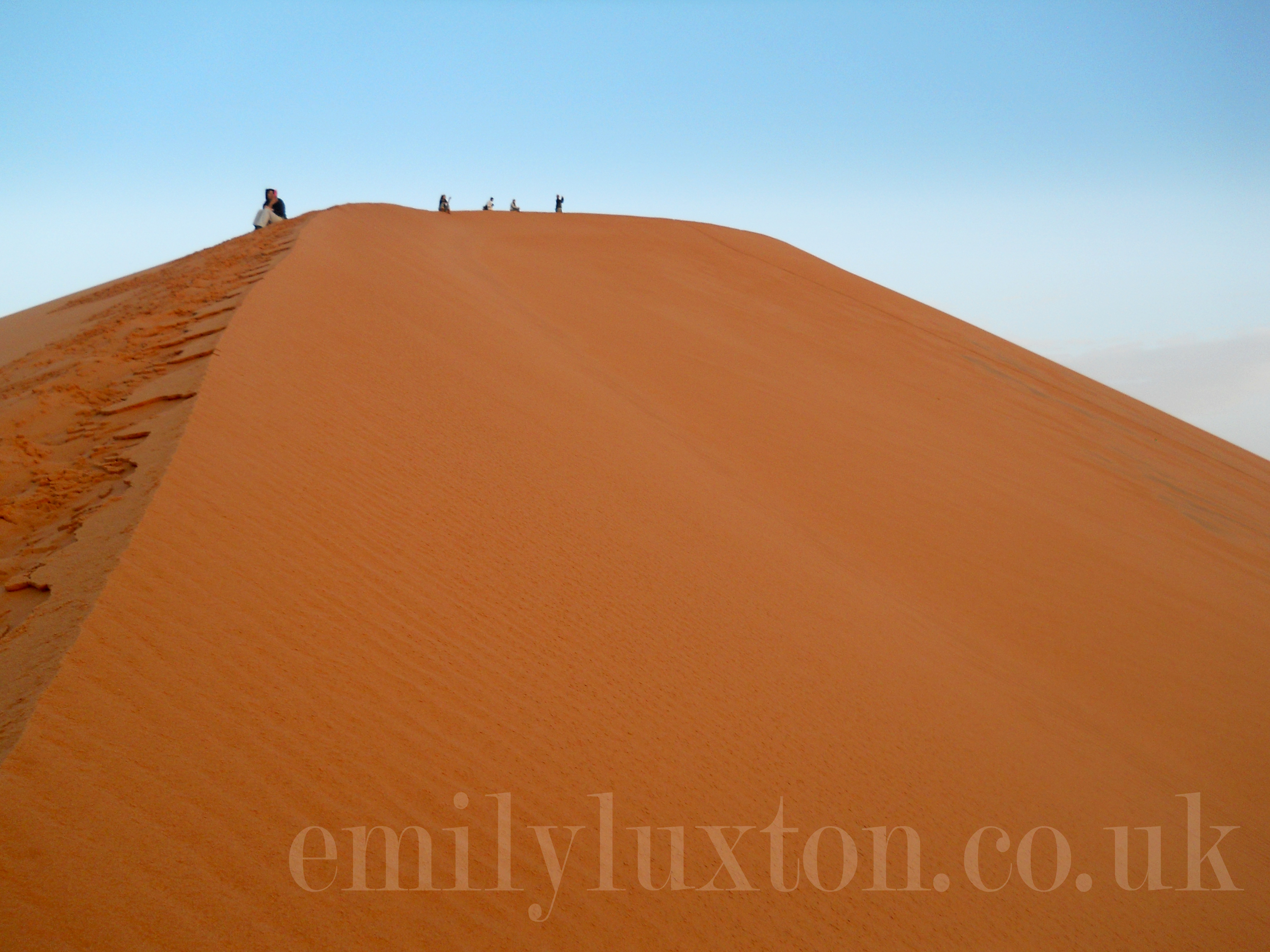
We woke up around six am. Stiff from yesterday’s ride and still half asleep we climbed the tallest dune to watch the sunrise. The wind had finally died down and the skies were clear, so we got an amazing view of the undulating dunes growing gradually lighter and more golden as the sun rose higher.
The low-angled light threw the nearer sides of the dunes into shadow, creating beautiful contrasts and patterns. We were both grumpy from a bad night’s sleep and early morning exercise, but the view was really worth it and, fortunately, could be enjoyed in silence. I couldn’t stop thinking that I’d probably never be there again, never see that sight again, which helped me ignore the general discomfort of early starts and camel rides, and really make the most of the experience.
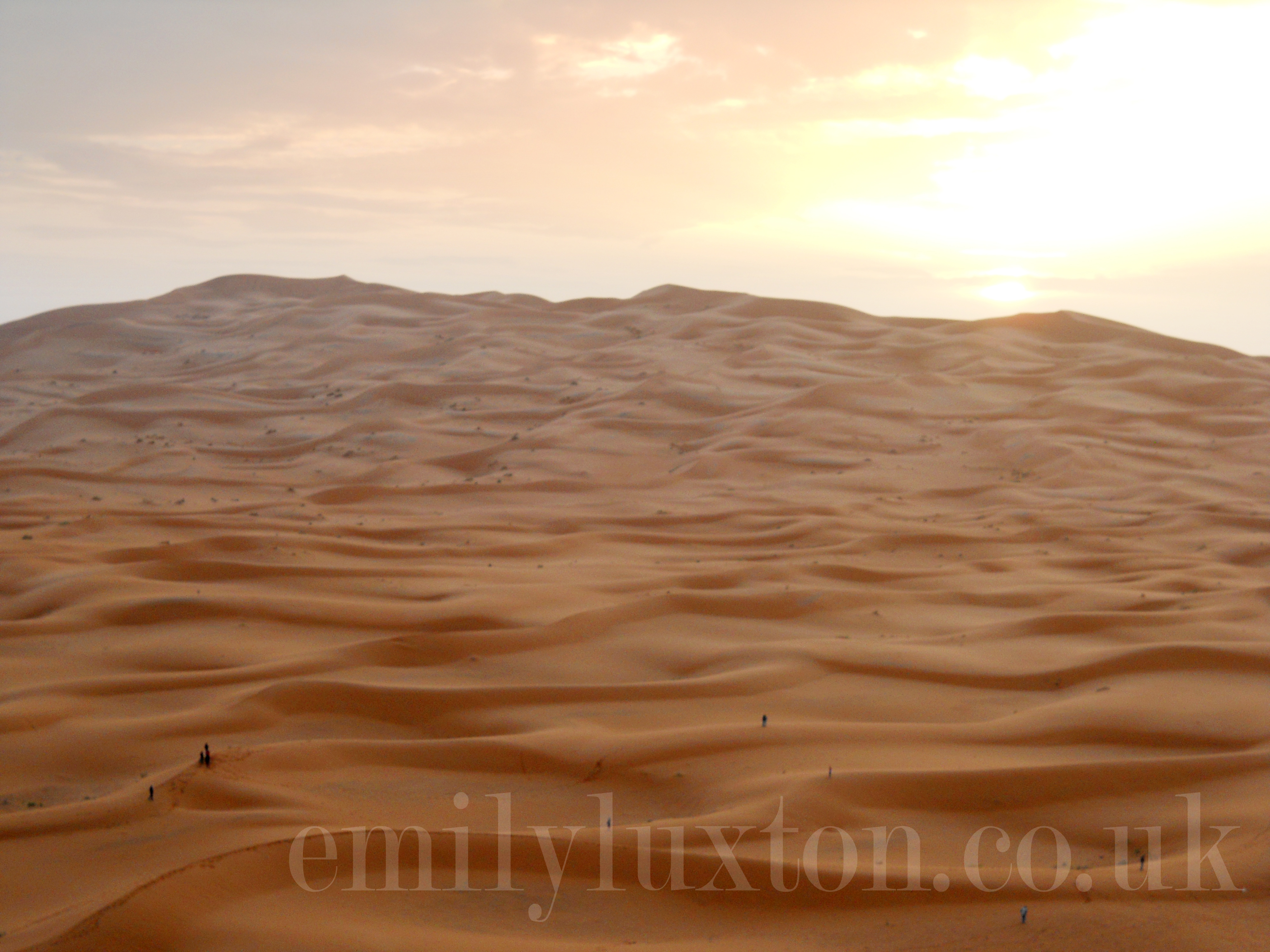
Sunrise Camel Trekking in Morocco
After a spot of “Berber whisky” (mint tea) we set off on the camels again. Bob Marley was even grumpier than me, and kept snarling and snapping at Jimi Hendrix. We were eventually moved to the front of the caravan to protect Jimi’s tail.
That morning, the skies were clear, and with no wind the dunes stayed flat and crisp, with none of the sand-smoke from the day before. The orange of the sand and blue of the sky made a beautiful contrast. The colour of the dunes is almost indescribable, more golden than orange, like a glowing amber.
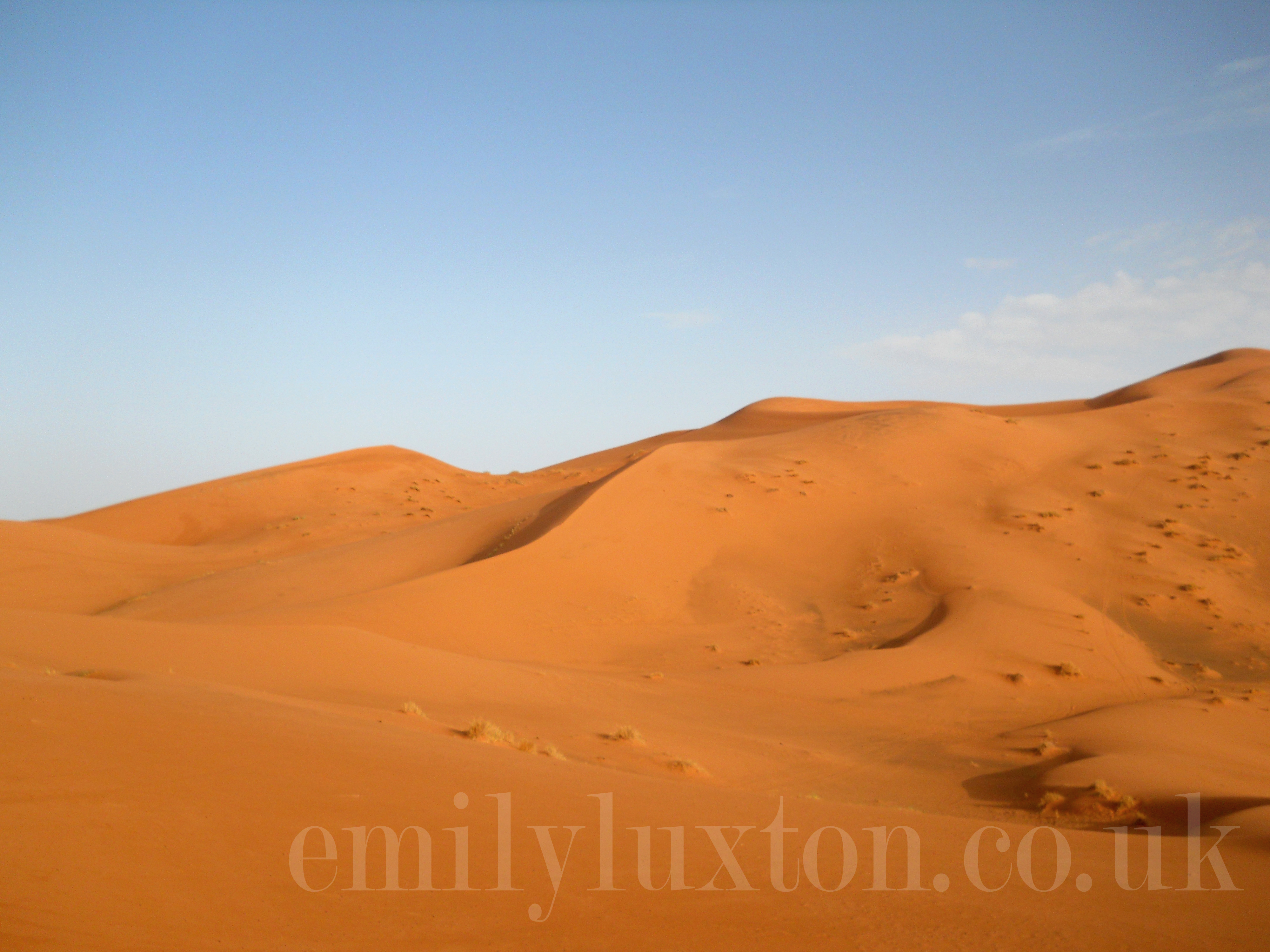
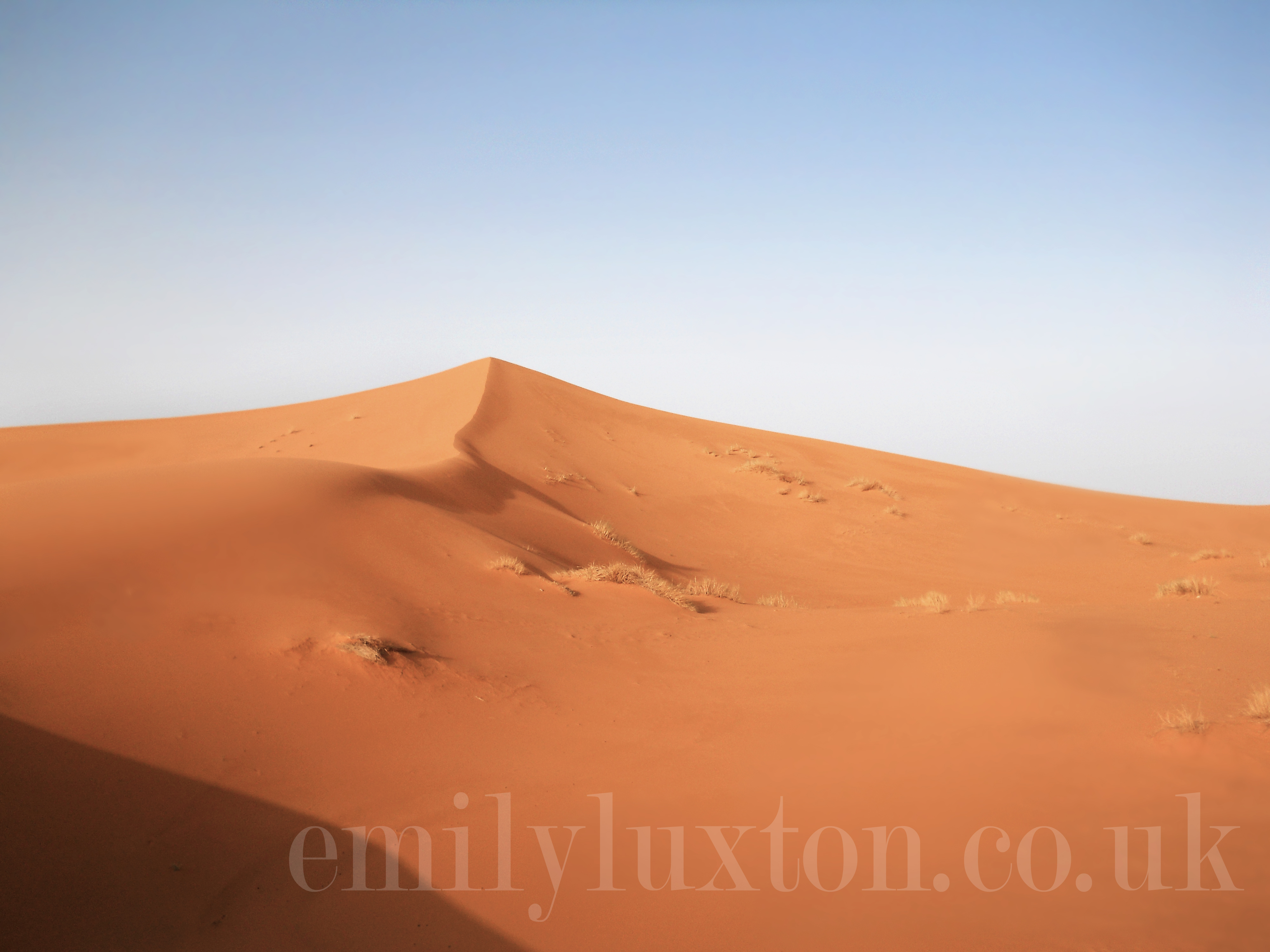
With no wind, the journey was much more easy-going and peaceful. The air was warm and fresh in the morning, and had that comfortable, almost edible beachey smell of warm sand. Hassan showed us how the dunes had changed shape overnight, new peaks had sprung up and old ones had diminished or stooped over. More talkative than last night, he kept shouting “lowk, lowk” (look) and pointing out interesting sites. Hassan showed us a “mouse house” and identified the tracks of mice, cats and foxes that had crossed the sand in the night; delicate patterns left behind in the
otherwise flat and untouched slopes of sand.
We got back at eight am, and it was already hot. After what felt like the best shower of my life, we had breakfast by the pool in the hotel. The whole experience was incredible, something I never thought I’d be able to do, and totally worth the twelve-hour bus ride and the aching legs and all the other discomforts. The highlight of my trip, my night in the Saharan dunes is a huge tick for my bucket list and one of those memories that will stay with me forever.
Information
READ MORE: How to Plan a Desert Trip in Morocco for all my tips on how to create a DIY trip to
If you’re looking for more adventures in Morocco, head to a surf camp like the one at Taghazout. The perfect contrast to a few days in the desert!
There are a lot of companies in and around Merzouga offering tours into the desert, but we booked ours through our hotel: Hotel Riad Mamouche – Ksar Hassi Labiad, Merzouga, Morocco.
Morocco – Day Ten – Final Day and revisiting Marrakech
29 March 2012
For our final day in Morocco, we took a taxi into Marrakech from our hotel in the La Palmerie (around Dh180) to revisit the city centre. Dodging snake charmers and henna artists in the Djemma el Fna like pros, we plunged into the souqs for one last shopping frenzy.
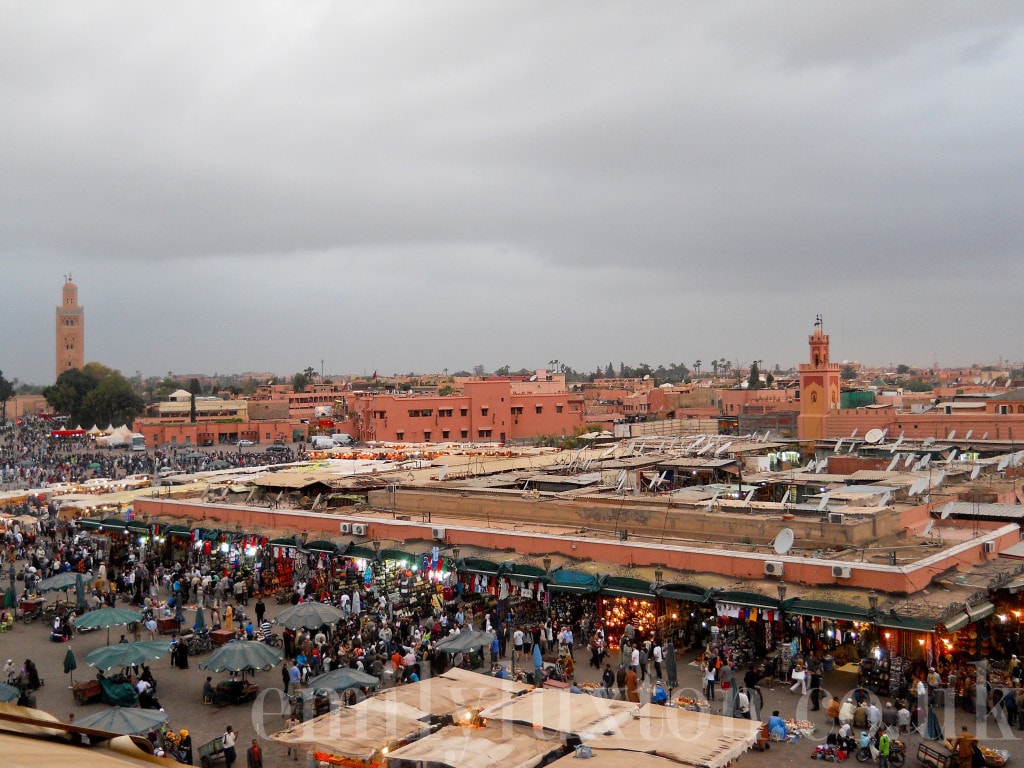
Even in bright daylight, the narrow alleys of the souqs are always atmospherically dim thanks to high walls and slatted wooden covers over the roads. I have talked about the souqs before, but they are a part of Marrakech that just keeps drawing you back and I can’t resist revisiting them.
Centuries seem to have collected here to sit stagnant in these winding streets; meat hangs from hooks outside a hole-in-the-wall butchers shop opposite a store jam-packed with electrical items. Scooters whizz past crowds with no thought for pedestrians, while at the same time donkeys are trotting along with heavily laden carts.
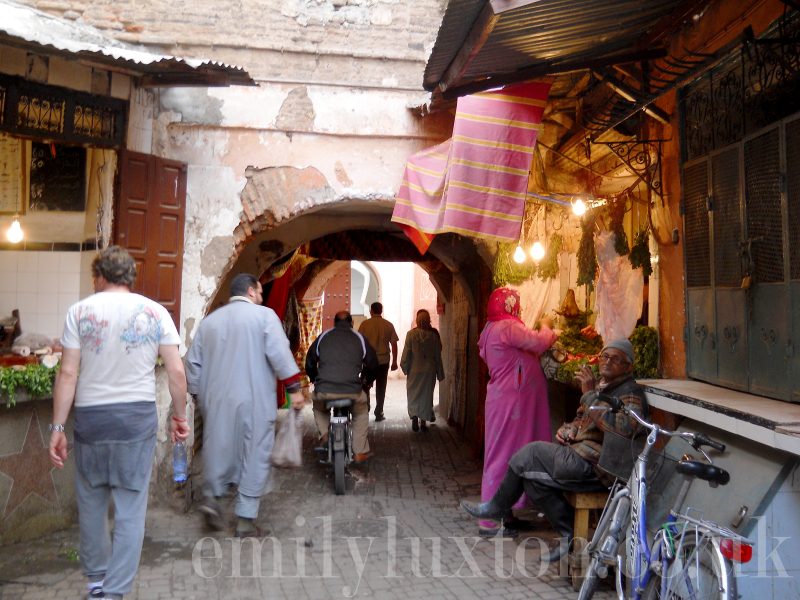
You can find everything for sale in the souqs. Just don’t try to actually find anything. Streets you just walked down will vanish when you retrace your footsteps, a shop you saw earlier disappears without a trace.
There’s something very Diagon Alley about this intricate maze where apothecaries stuffed with mysterious potions emerge from the darkness, and storefronts twinkle like Aladdin’s caves, bursting with glittering brass lanterns and teetering stacks of silver tea sets.
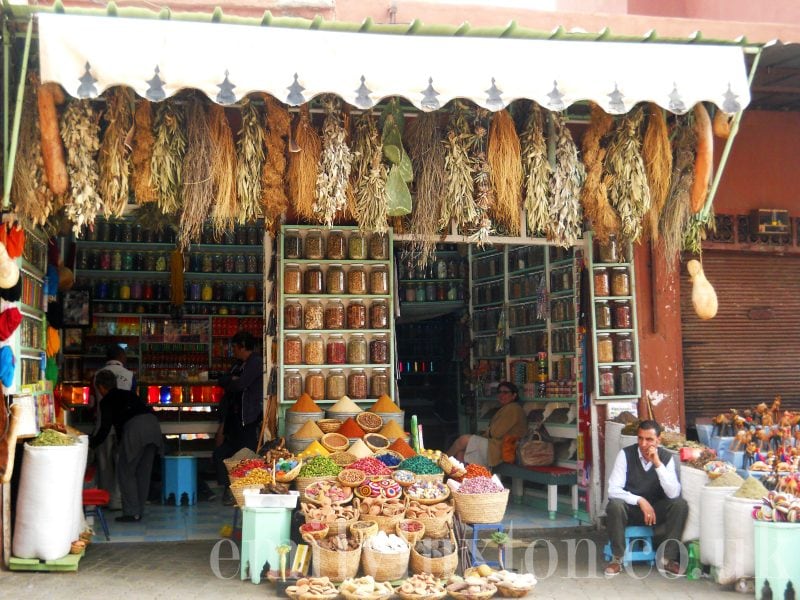
It’s all so jaw-droppingly fascinating that you won’t even notice the smells of raw meat, sweat, and decay. Besides, all that is overpowered by the white musk or amber that an eager salesman has rubbed on your clothes (“Berber Chanel Number Five”) or the mouth-watering flavours of tagine spices hanging in the air around a little cafe .
The souqs operate at a hectic pace. Cries of balek! (watch out!) pelt over the din of donkeys, hawkers, children, scooters and tourists as men nimbly weave round shoppers, dragging carts loaded with goods. Locals who seem born with an in-built souq navigation system race and jostle down the poky side streets, and even tourists don’t seem to want to stand still.
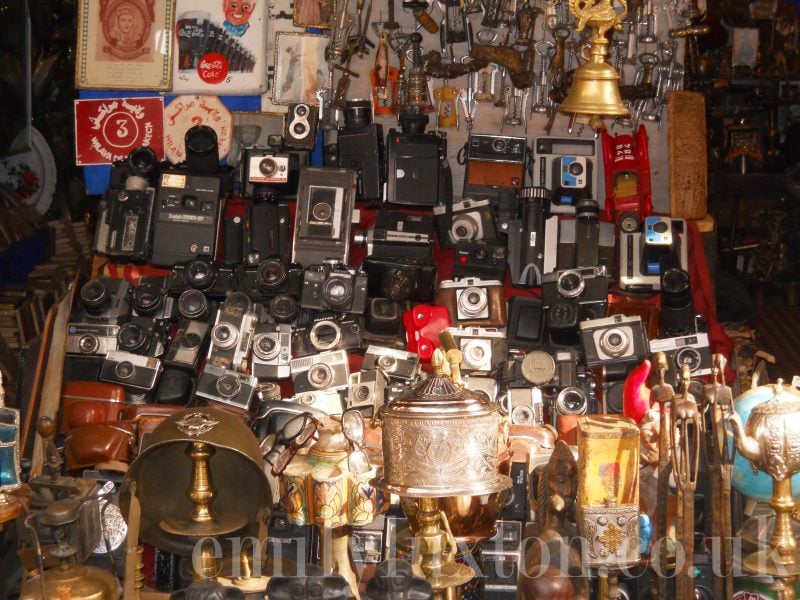
Funnily enough, though, actually buying something can be quite time-consuming. The process is dragged out like this…
You stop to look at something and a shopkeeper pounces out of the shadows, blocking off the entrance and cornering you in his shop. He asks if you like it, tells you how good it is, tells you why you need it in your life. You ask how much and he gives you a value three or more times the item’s worth.
You shake your head and give the price you’d like to pay. He laughs at your ridiculous offer, or shakes his head with an act of offence. He offers you a slightly lower price than his original, saying it’s a special price because he likes you. You stick to your guns and give the price you want to pay.
He says no, he couldn’t possibly, it’s far too low. You put the item down and start to walk away. He chases after you, asks for your best price. You give the price again. He offers something a little higher. You walk away again, he chases after you, grabs your hand and says ok, yes, you can have it at the price you want – but only because he likes you, it is far too low and he won’t make any profit now. You pay, he wraps the item, and you shake hands and walk away.
Now, the whole experience is fun, but I can’t help but wonder if maybe just having fixed prices would speed things up. And who knows, maybe they’d sell more.
READ MORE: Get some top haggling tips in this post!
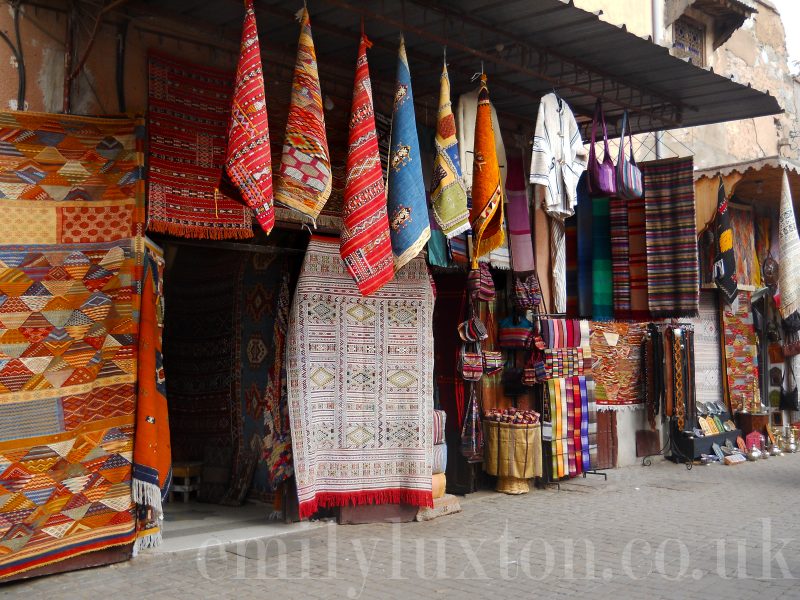
Clutching the souvenirs I’d bargained hard for, we headed back across the square to the roof terrace of Cafe Glacier, where we filled up on a late lunch and people-watched from the balcony.
Afterwards, we sat in the neat Cyberpark gardens – a favourite haunt of bored-looking Moroccan teenagers – and chilled out after a hard day’s haggling. After a man with a whistle kicked us out at closing time, we headed back to the roof terrace overlooking the Djemma el Fna and watched as night fell and the square came to life.
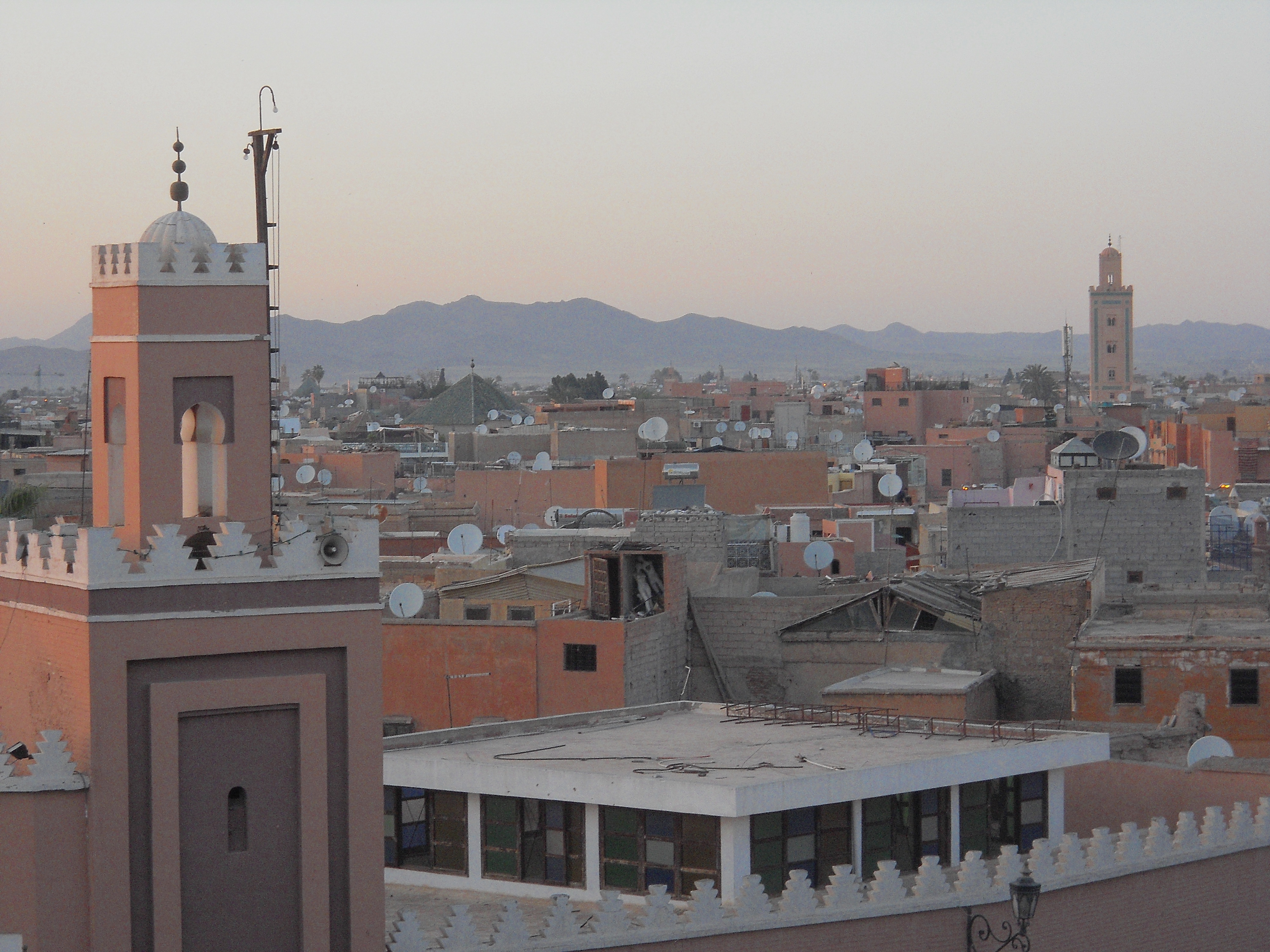
With nightfall, the wind picked up and the air got a lot colder, so we headed down to eat before we were actually hungry. As soon as we stepped into the cluster of stalls in the square, eagle-eyed touts spotted tourists and pulled us to the nearest stall.
Even if eating on a full stomach was a bit of a chore, I couldn’t help but enjoy the delectably soft lamb with couscous, or the barbequed skewers which came hot off the grill in a cloud of smoke.
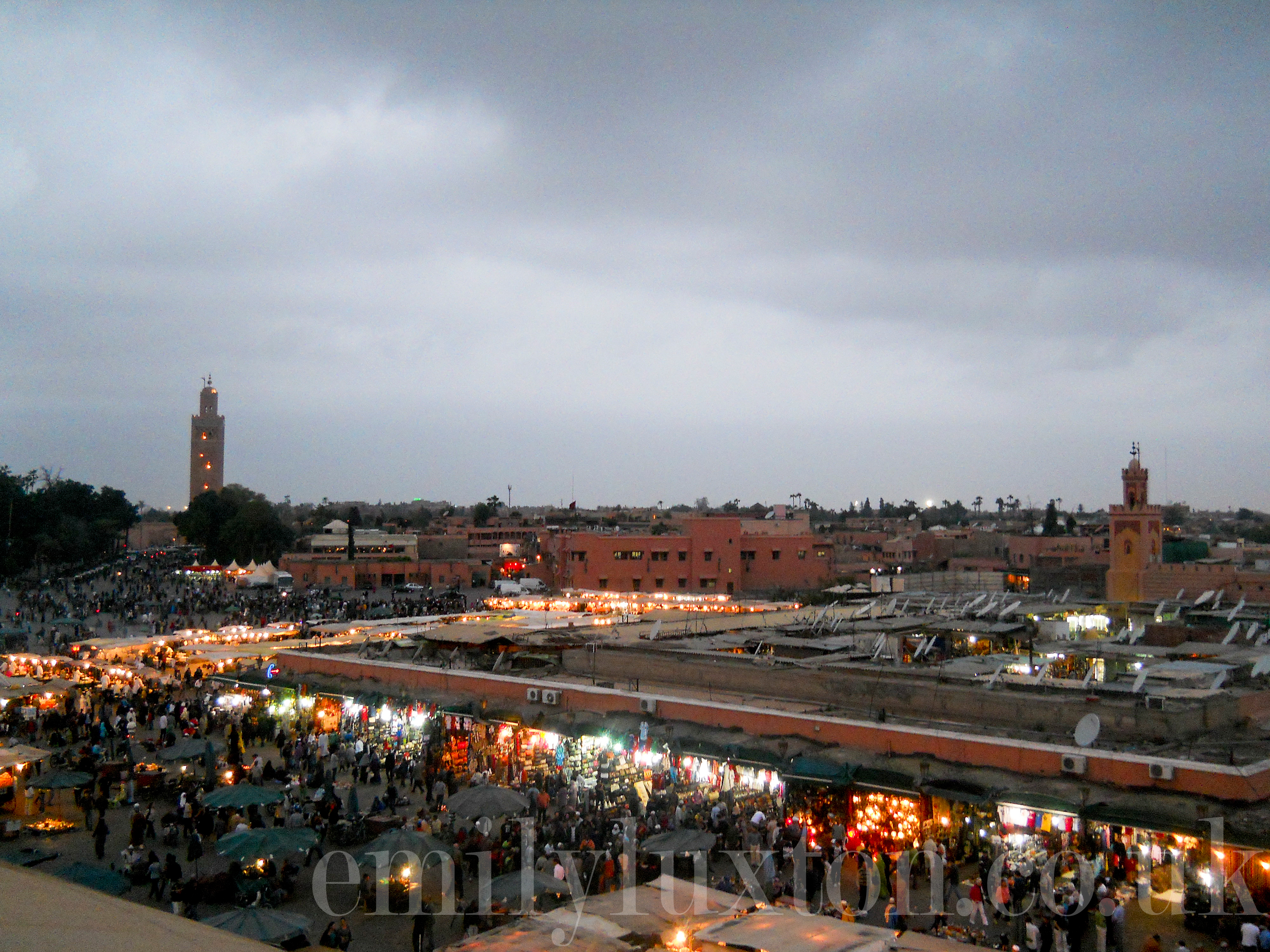
This is street food at its best; traditional, cheap and delicious. I don’t know how the chefs here can work such wonders with meat over nothing but an open flame. But then, dinner has been cooked in the same way in this square every night for centuries, so I guess it’s yet another innate ability the Marrekeshis have.
One early night and one very early start later, we were headed back to drizzly London and the whole trip had come to an end.
Those ten days had been a whirlwind of extremes; from hectic Marrakech to the Sahara and back, from mountains and waterfalls to great flat plains, from the ancient to the modern, from camping in the desert to a four-poster bed… the list goes on.
It was one of the most amazing experiences I’ve ever had and I hope you’ve enjoyed reading about my adventures.
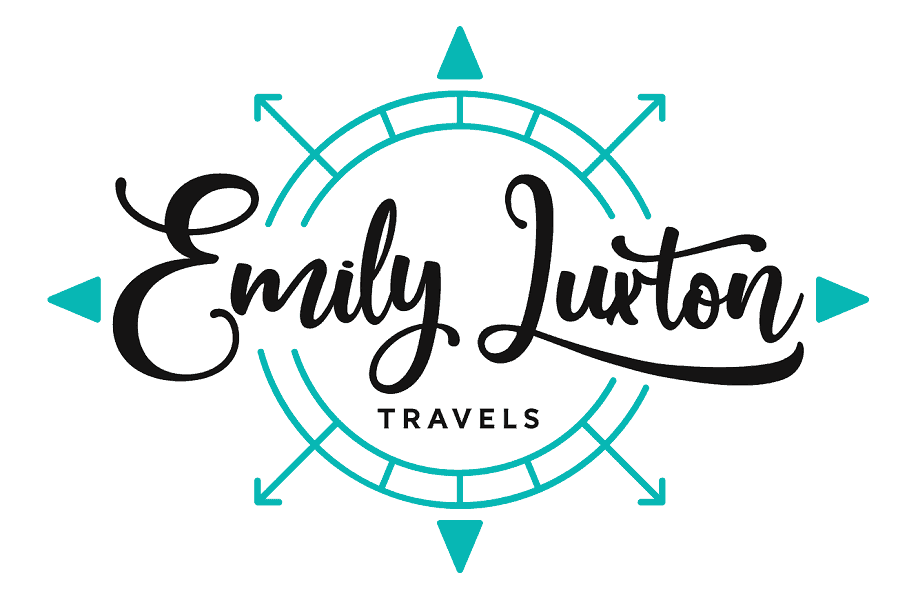
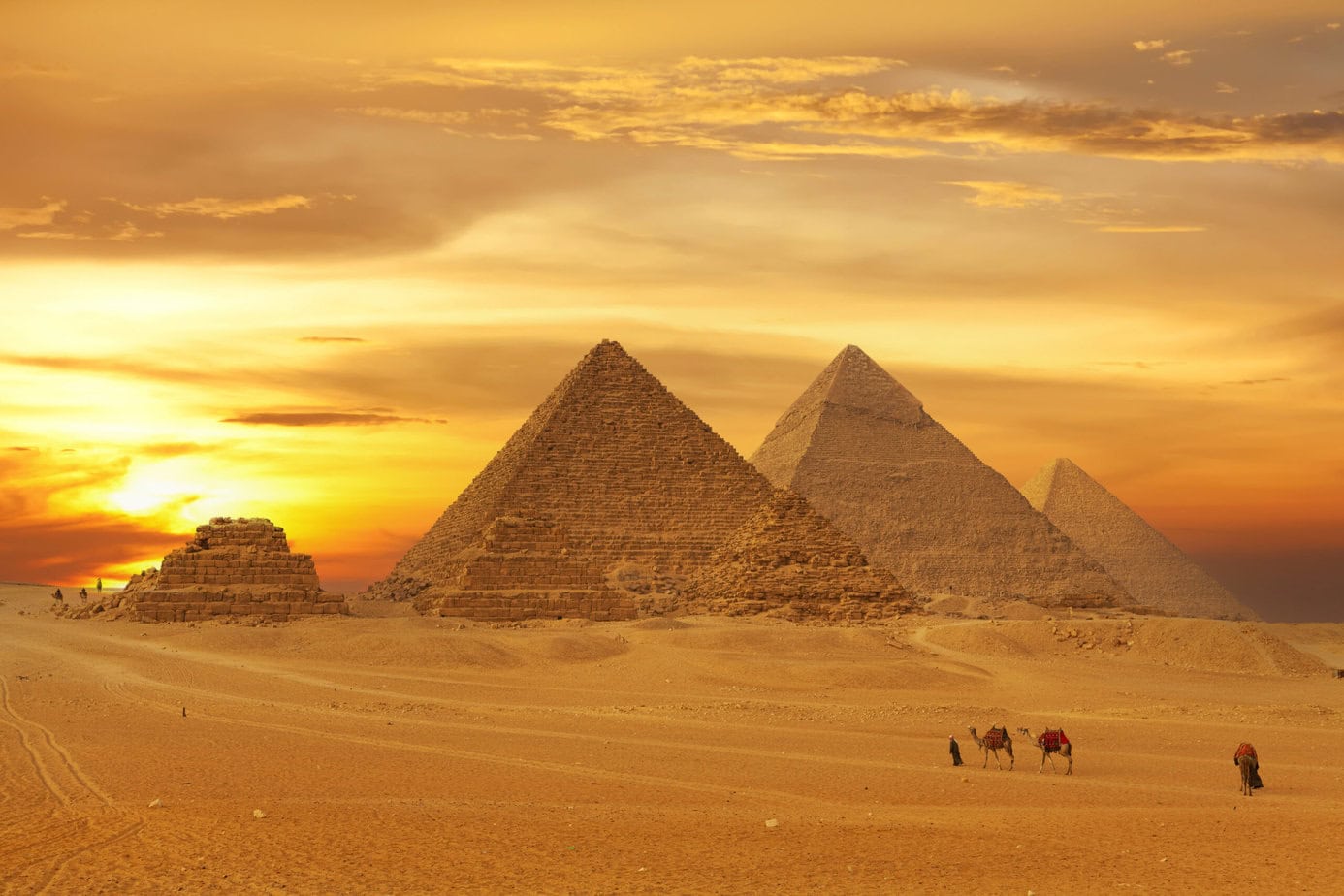
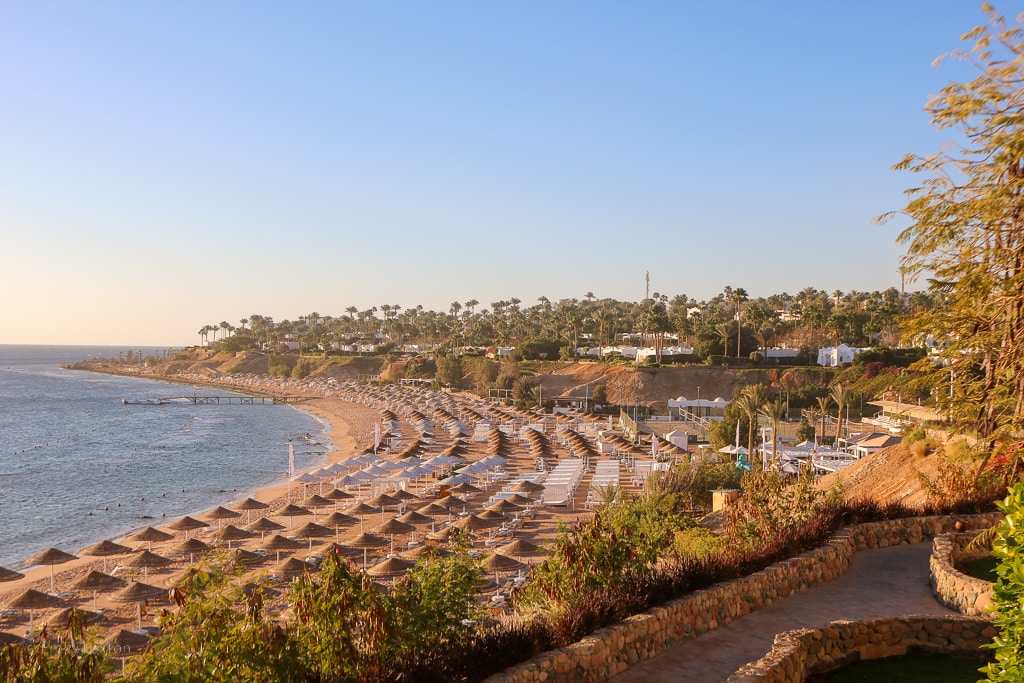
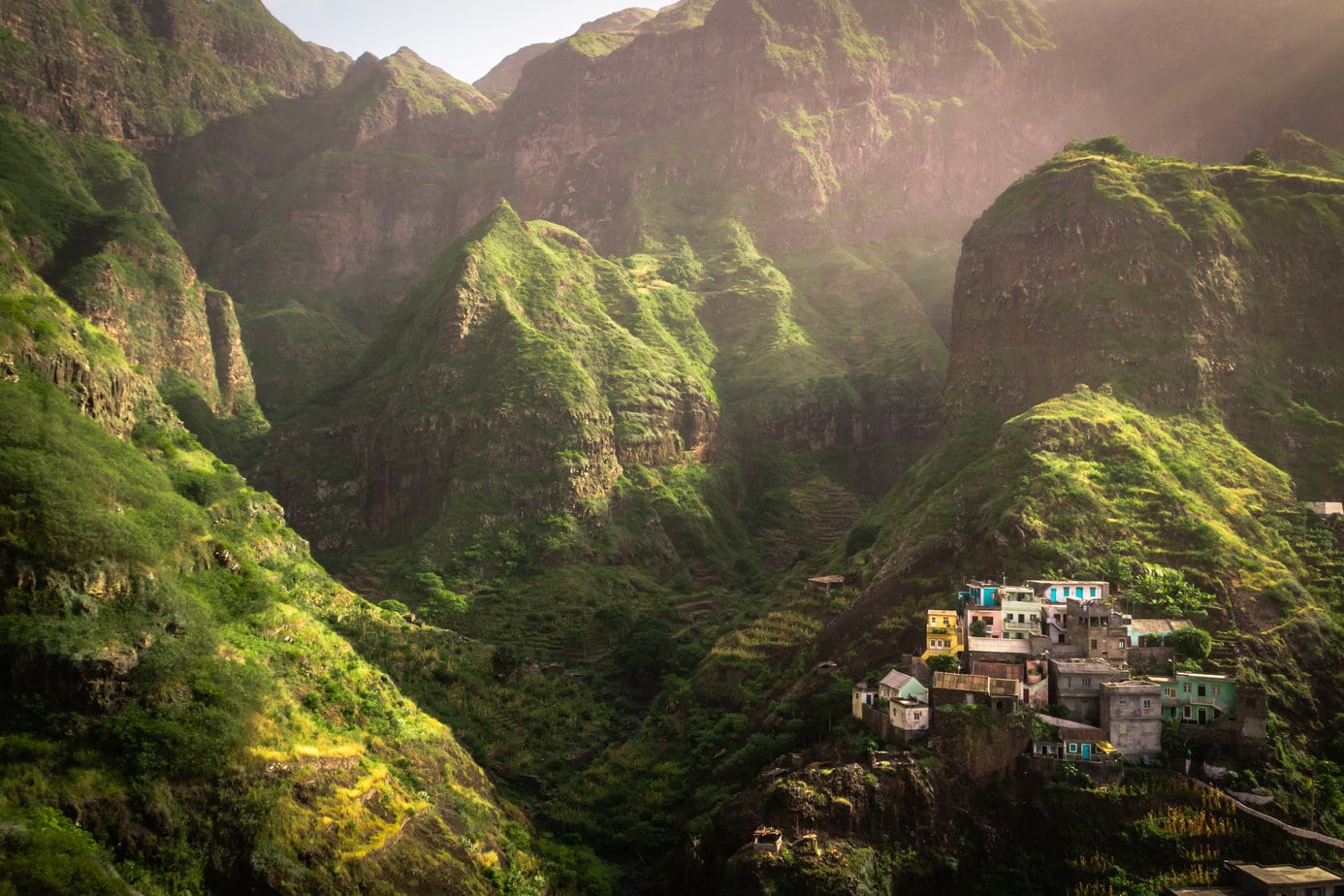
Aaah, Marrakech :) Thanks for bringing me here with your like, makes me want to go back and become a goat herd in the atlas mountains all over again!
Thank you! It was the most incredible adventure, such an amazing city! I felt a bit sad when I read the beginning of your post, but memories are everything! I know I won’t need a single one of my photos or souvenirs to take me back there (although the spices I bought may help!!). Good luck with your travels – I hope to go inter-railing at some point soon!!
Em
Its a completely different world, lovely to talk to someone who has had the same experience. Its a shame about the photos, but I know I will never forget my trip, so its not too sad :)
Thankyou, and good luck to you too!
Tks to visit my blog Emily.
i hope you enjoy your trip in Morocco. I have been 3 time in Casablanca for work and one time to visit the country. The people and life style are different from european style but if you are friendly and humble you will find lovely people everywhere and beautiful skies! We ride in motorbike from Marrakech to Tata Oasis and we have nice and warm memories!
Enjoy!
Thanks you! We had an incredible time – it is such a vivid and exciting time. Thanks for visiting and commenting :)
Em